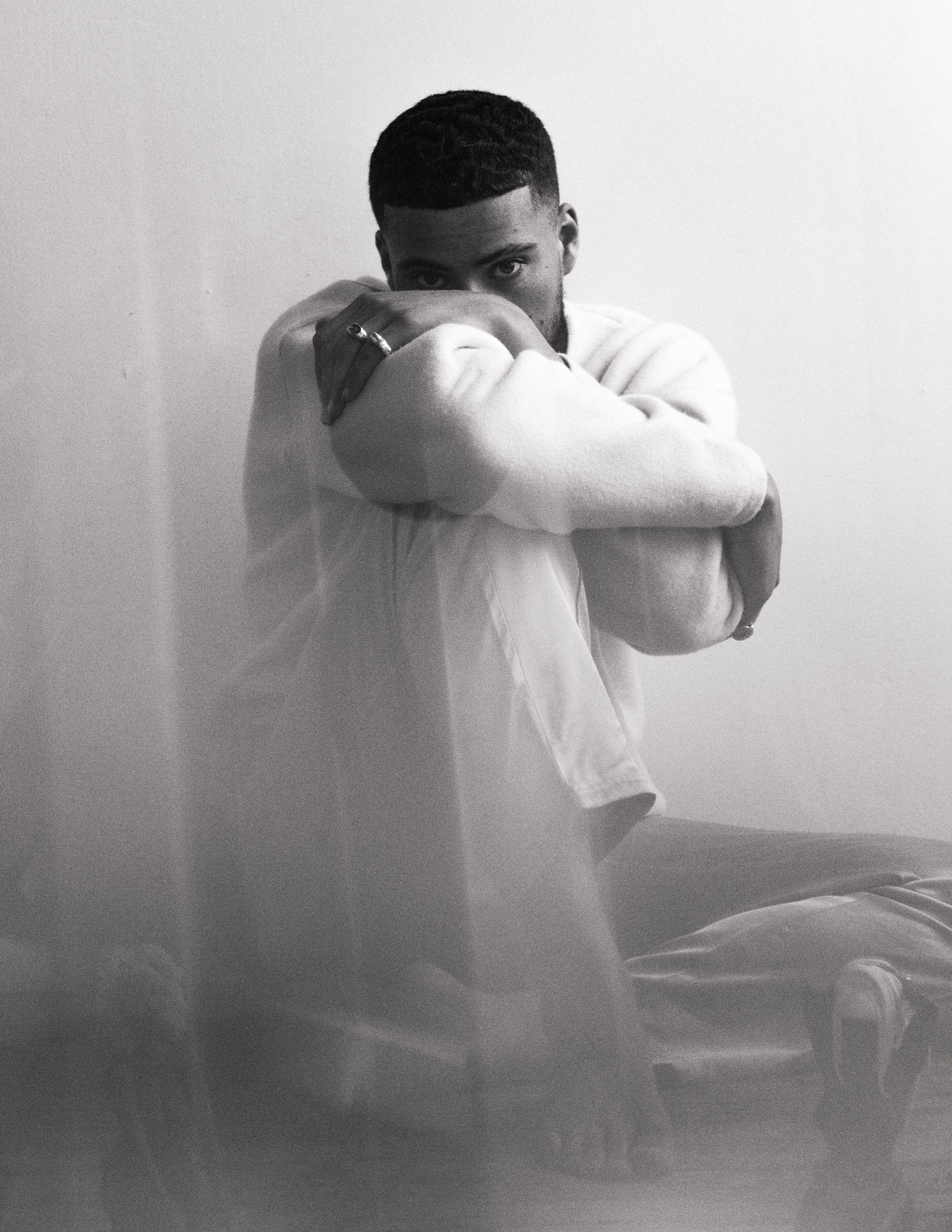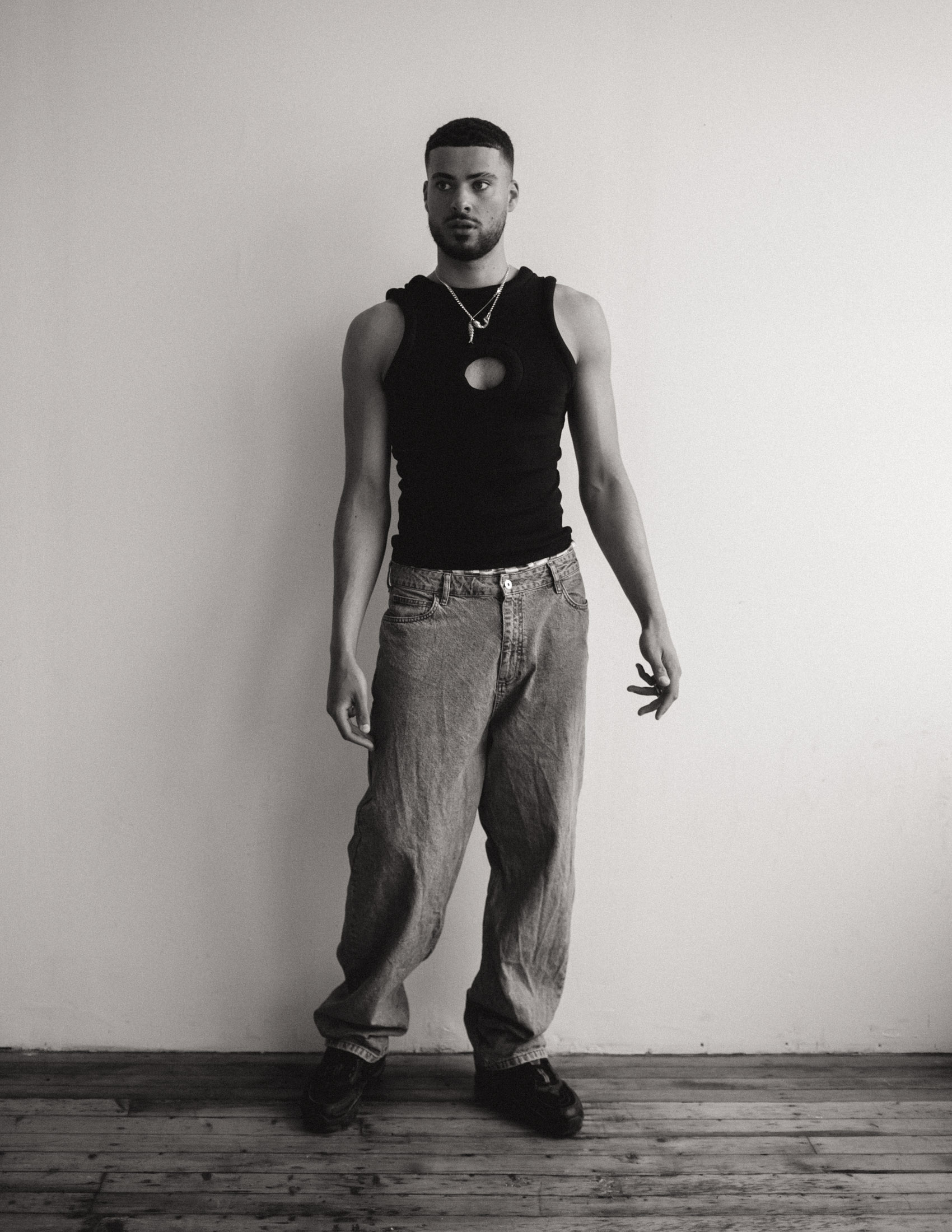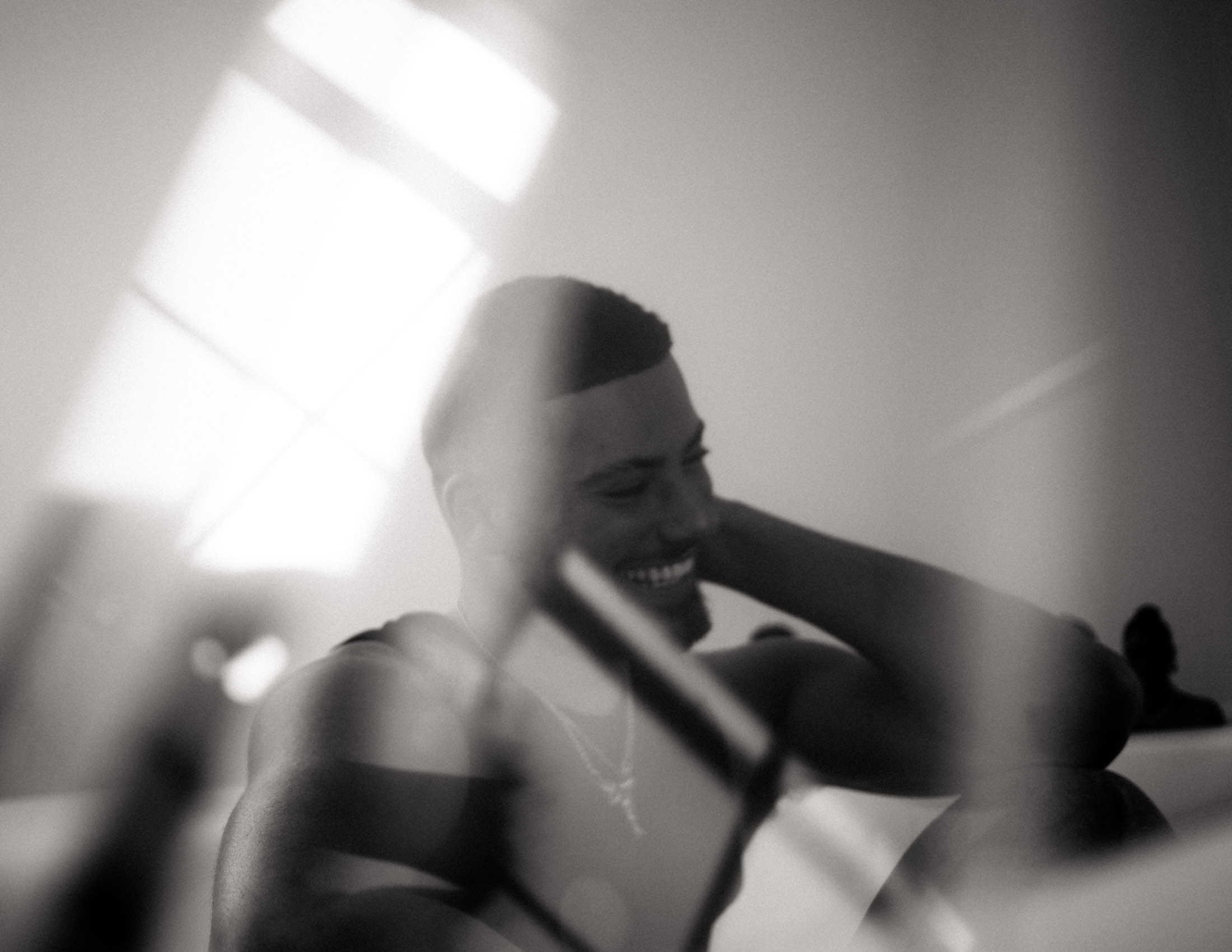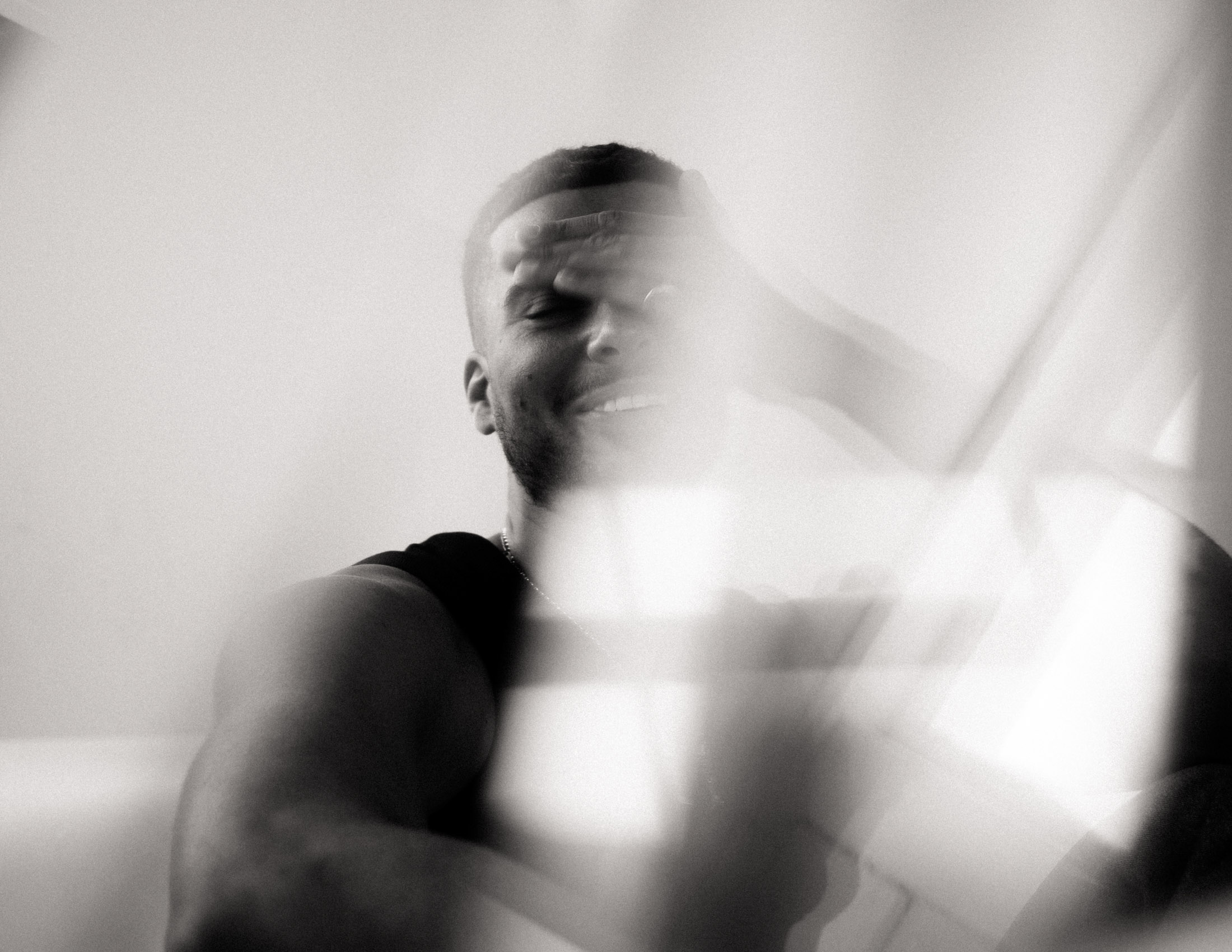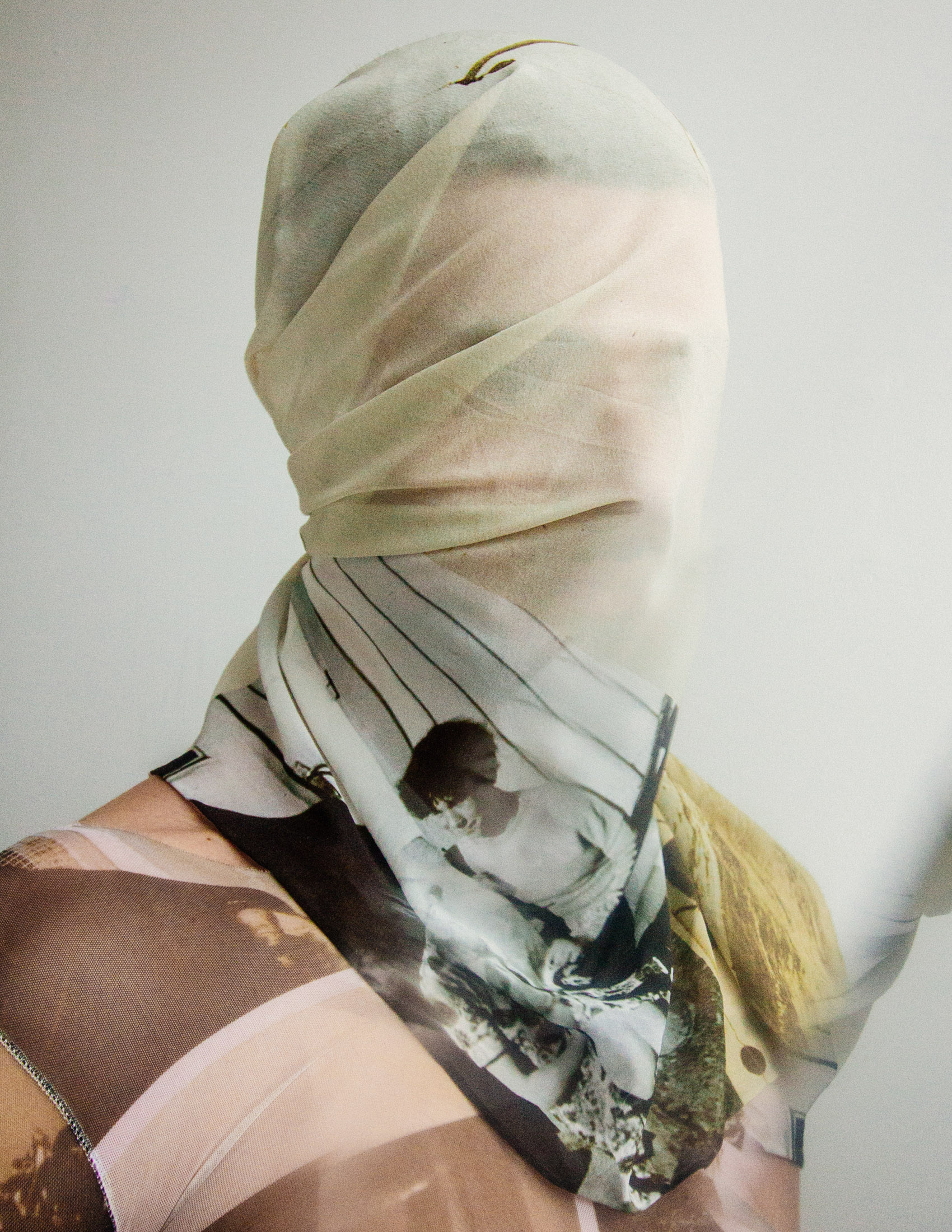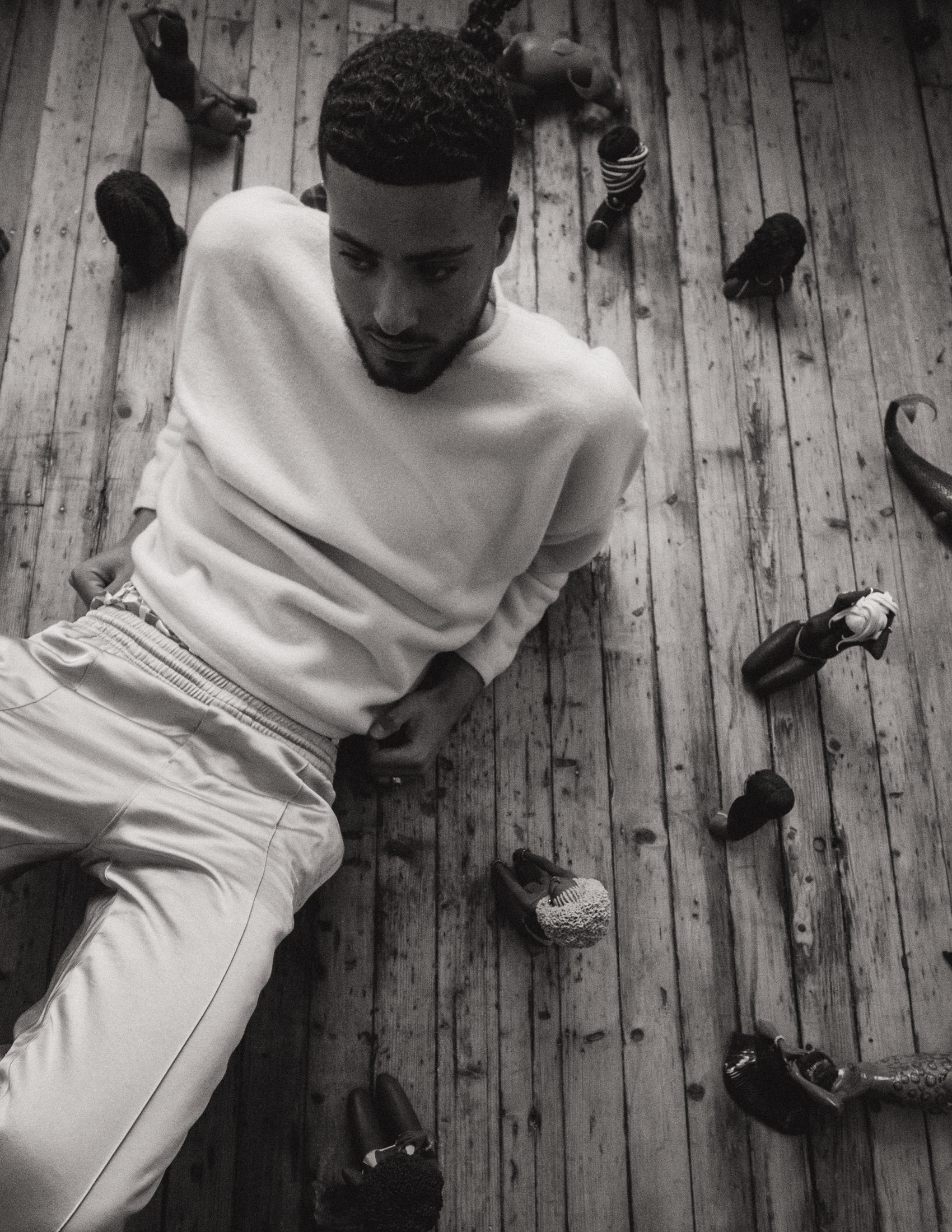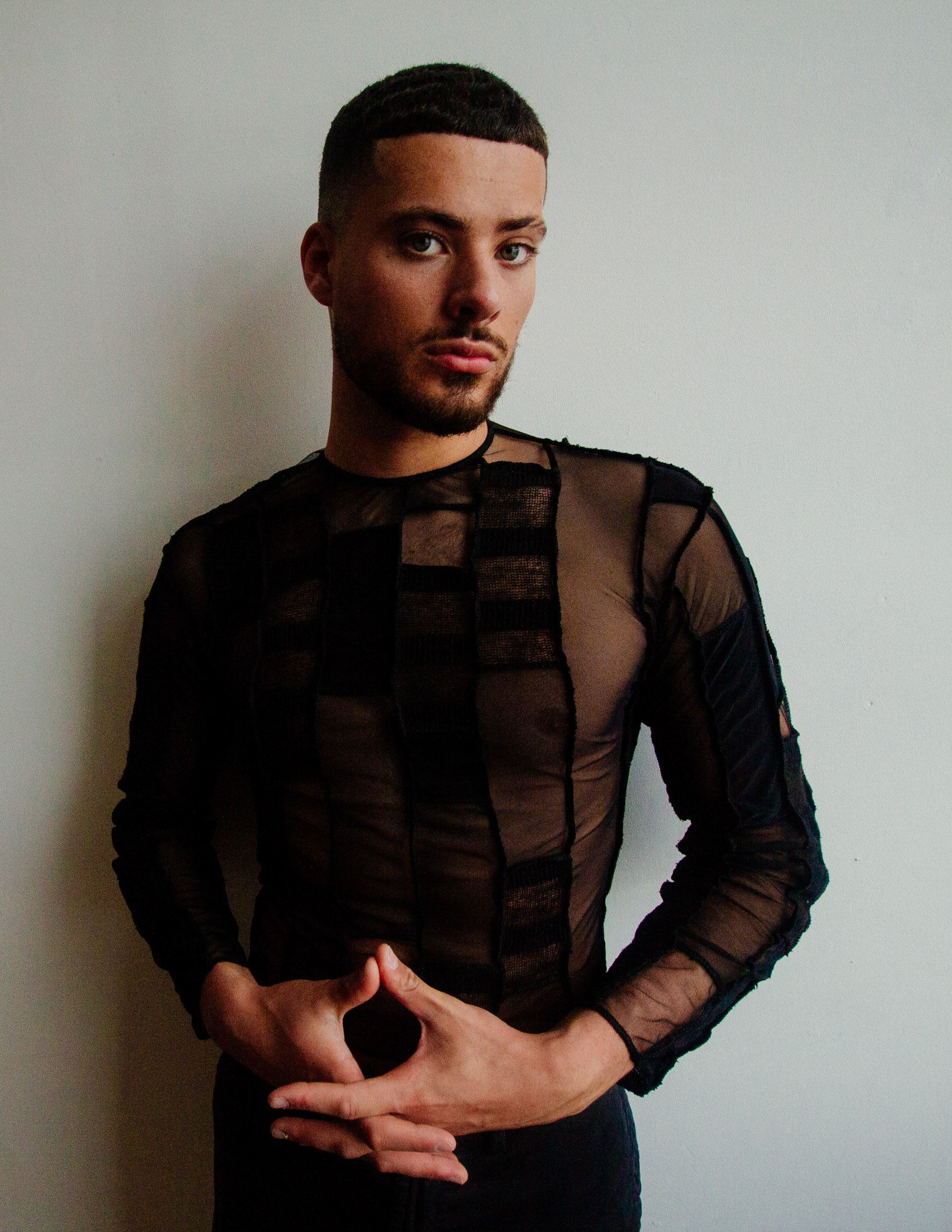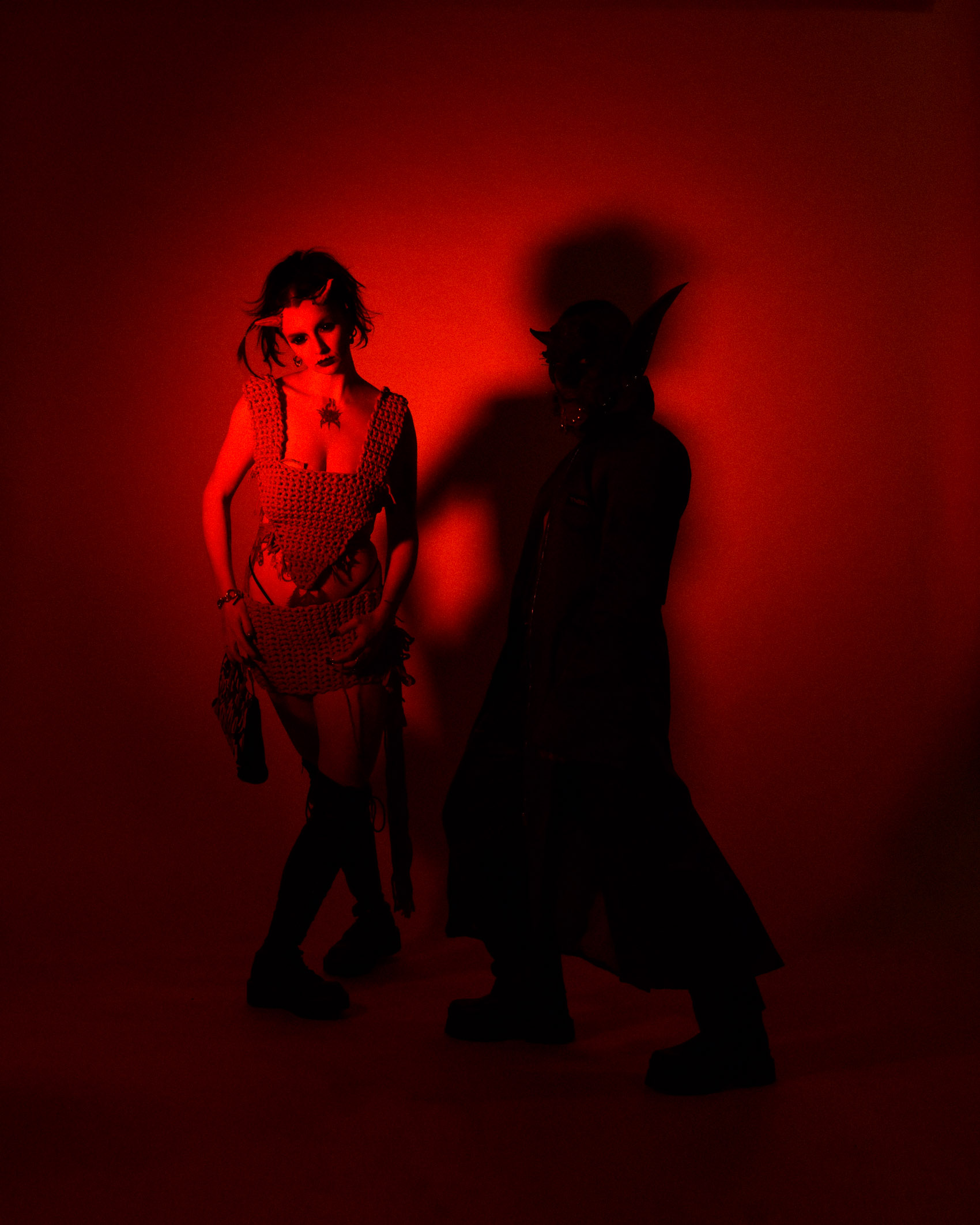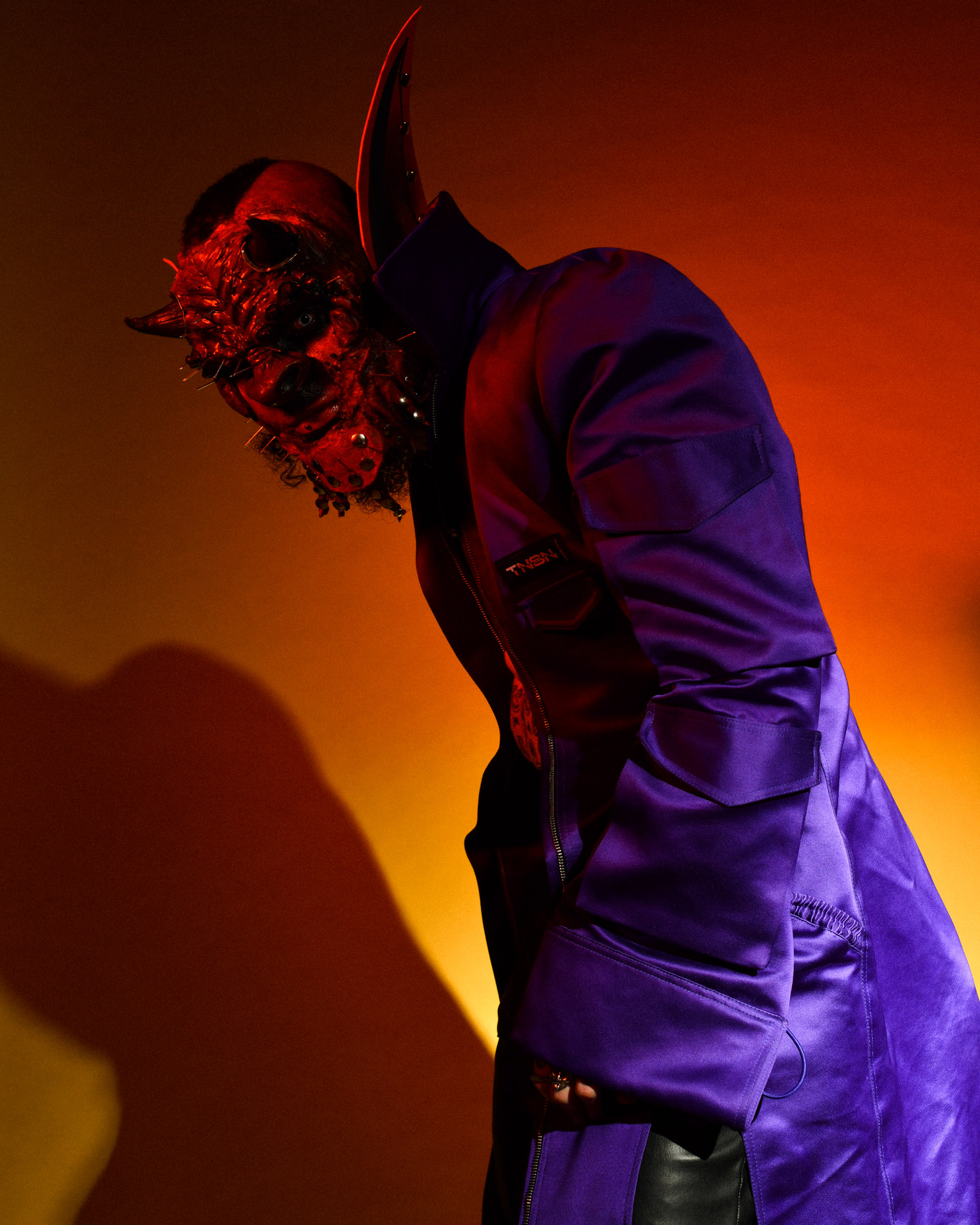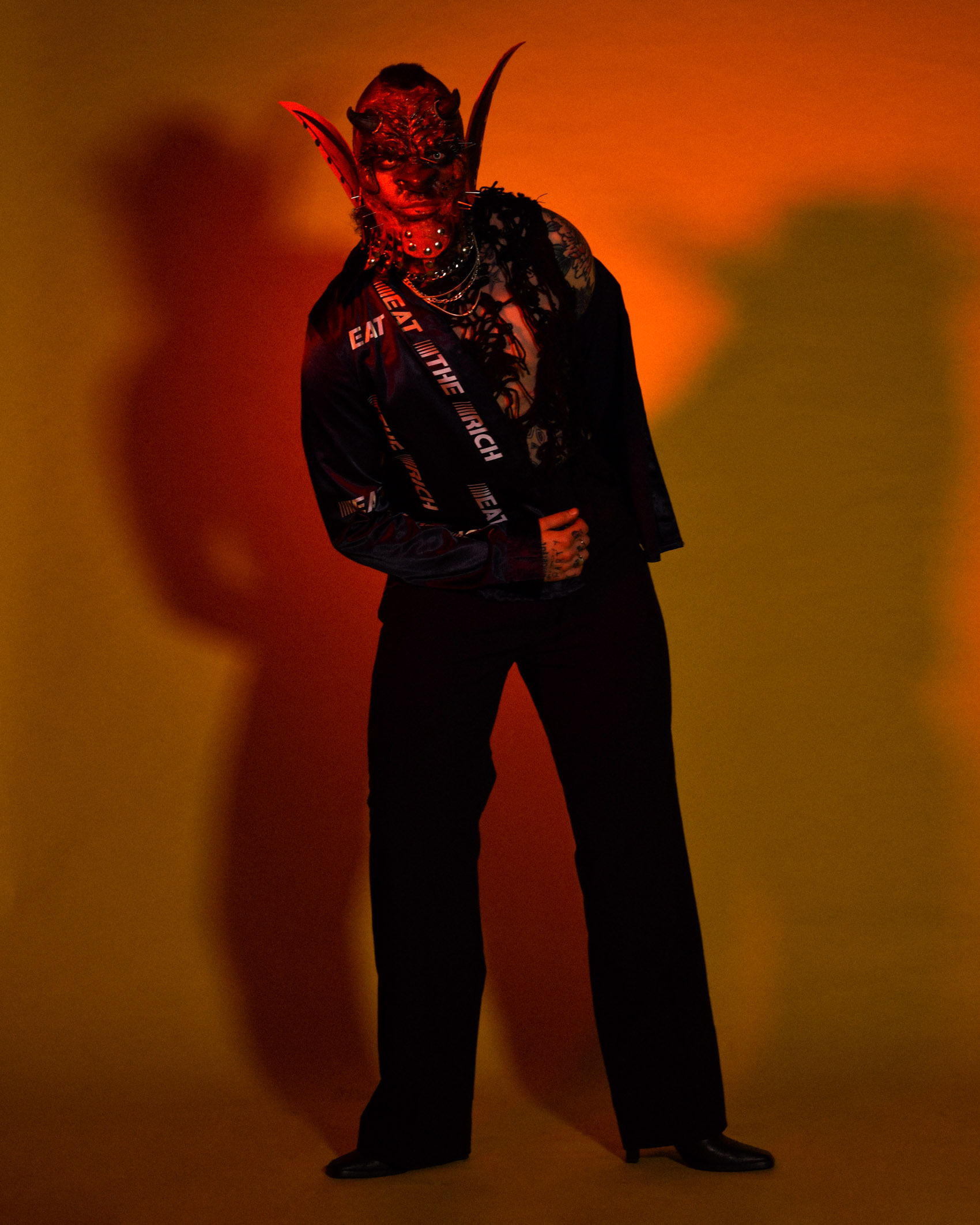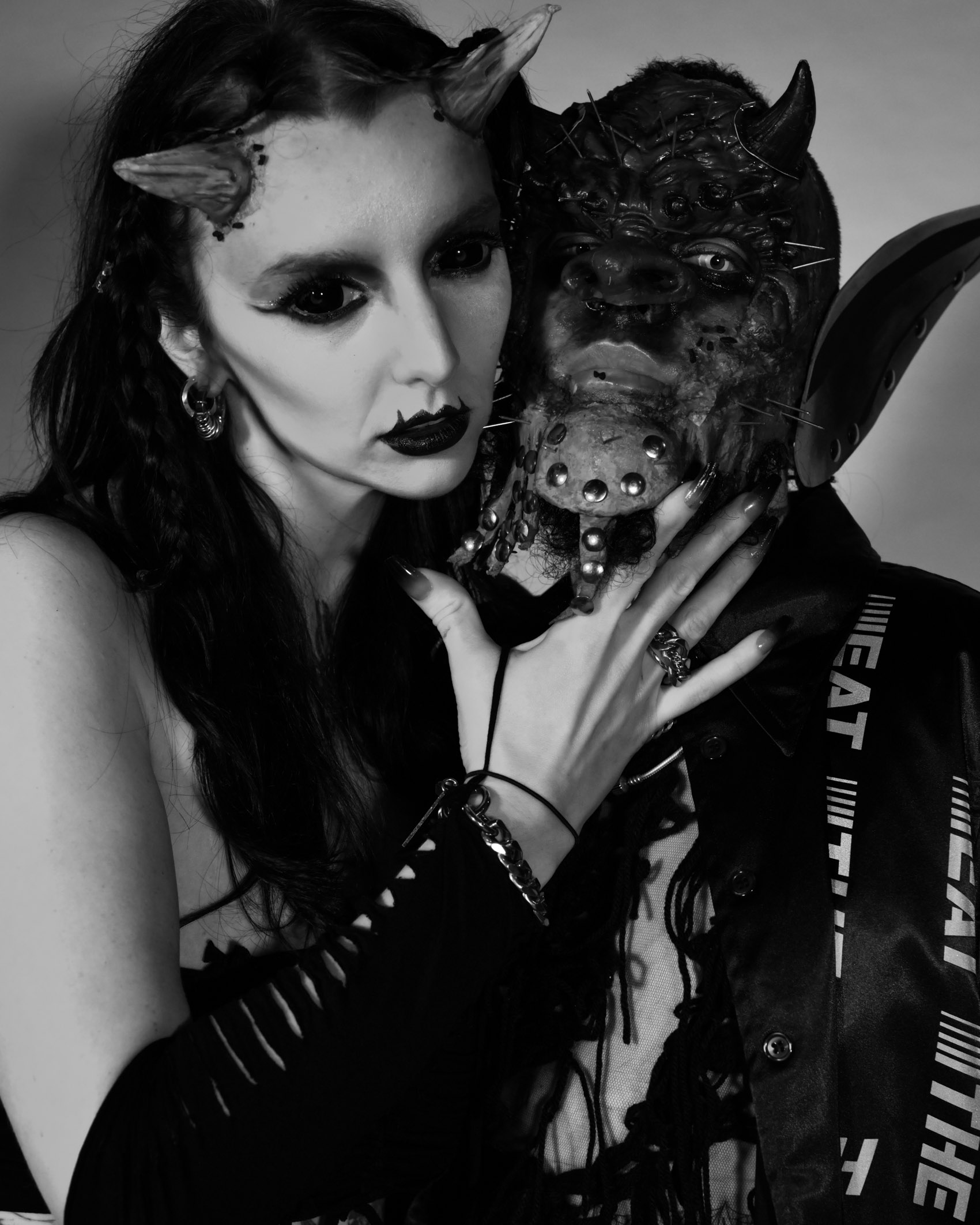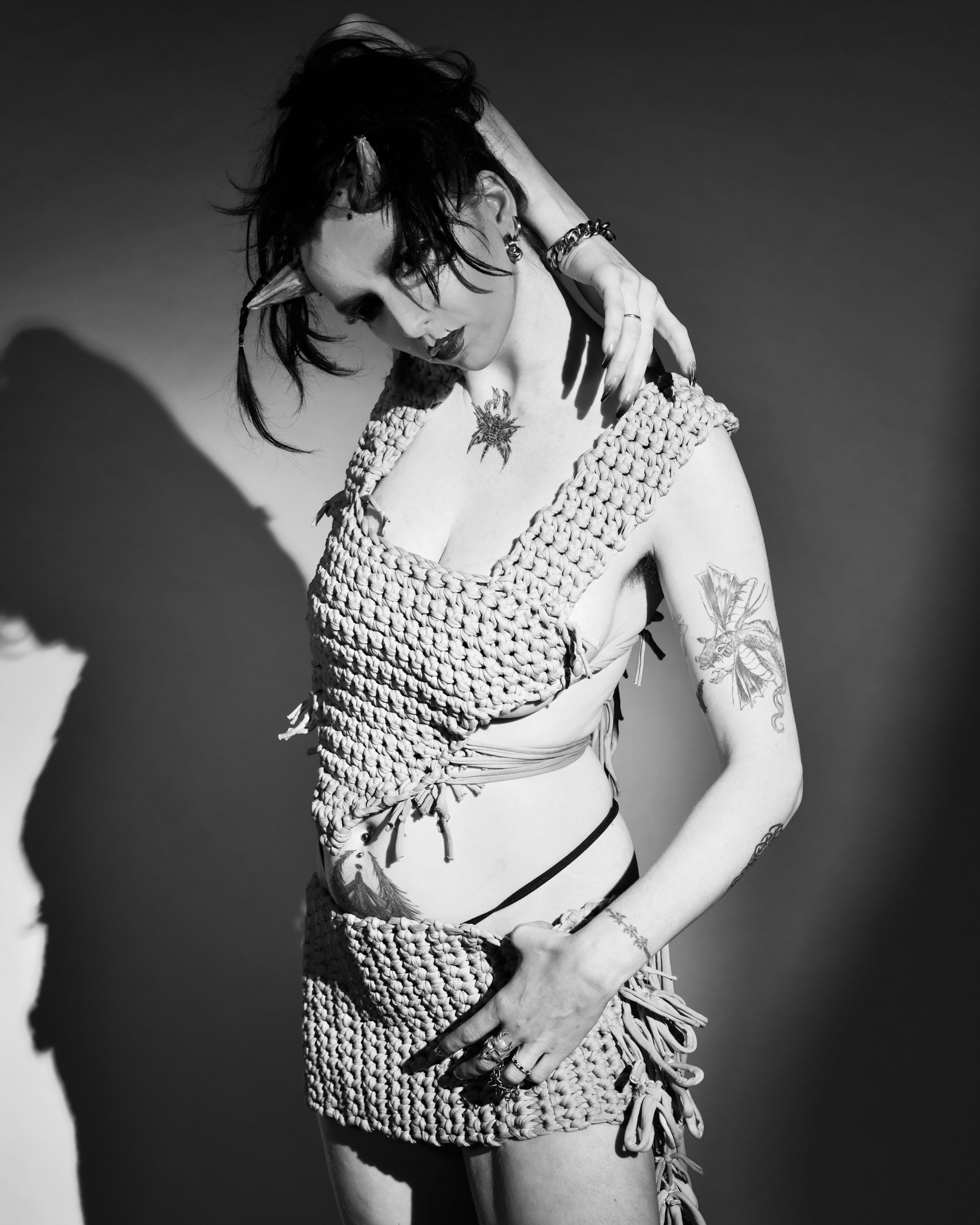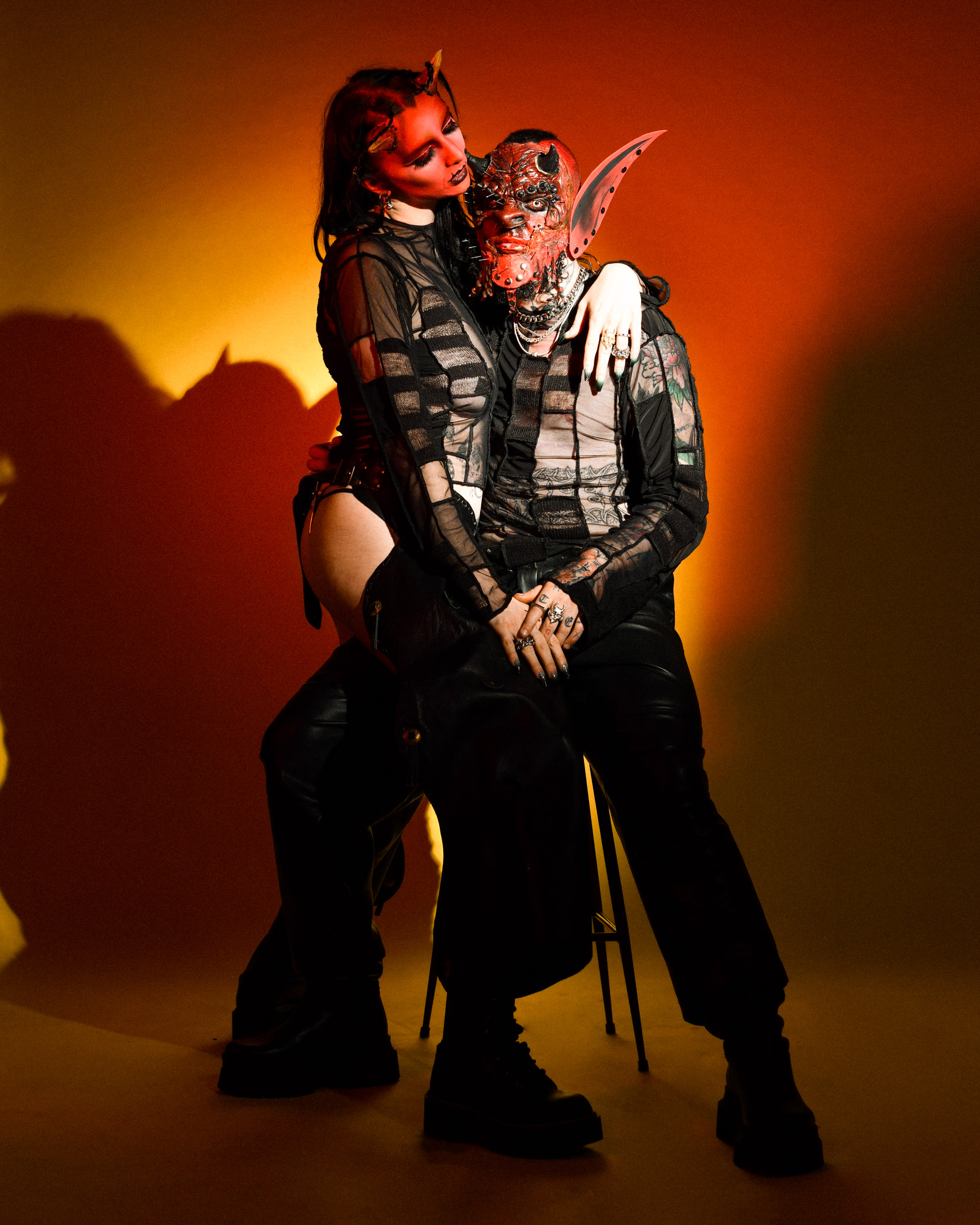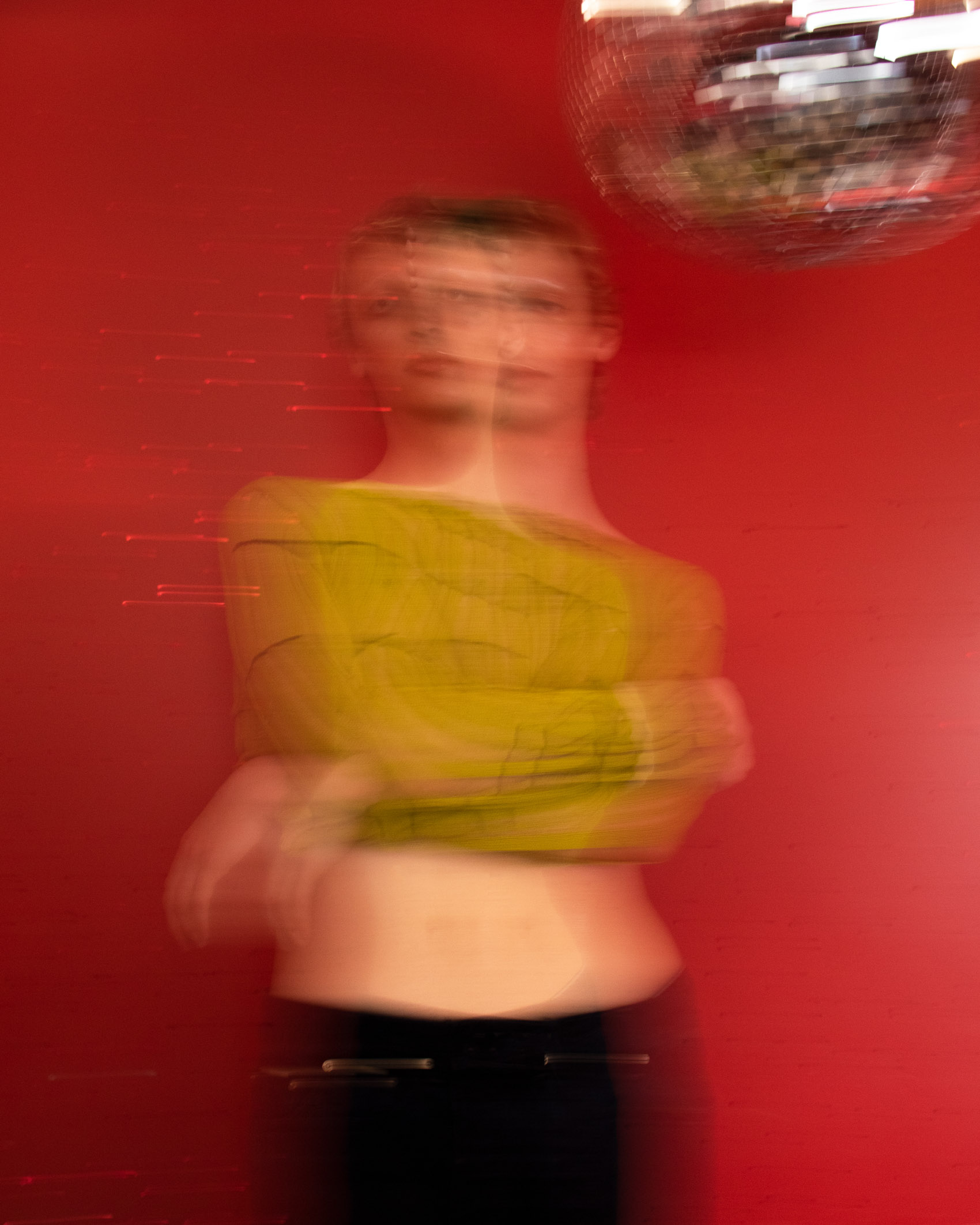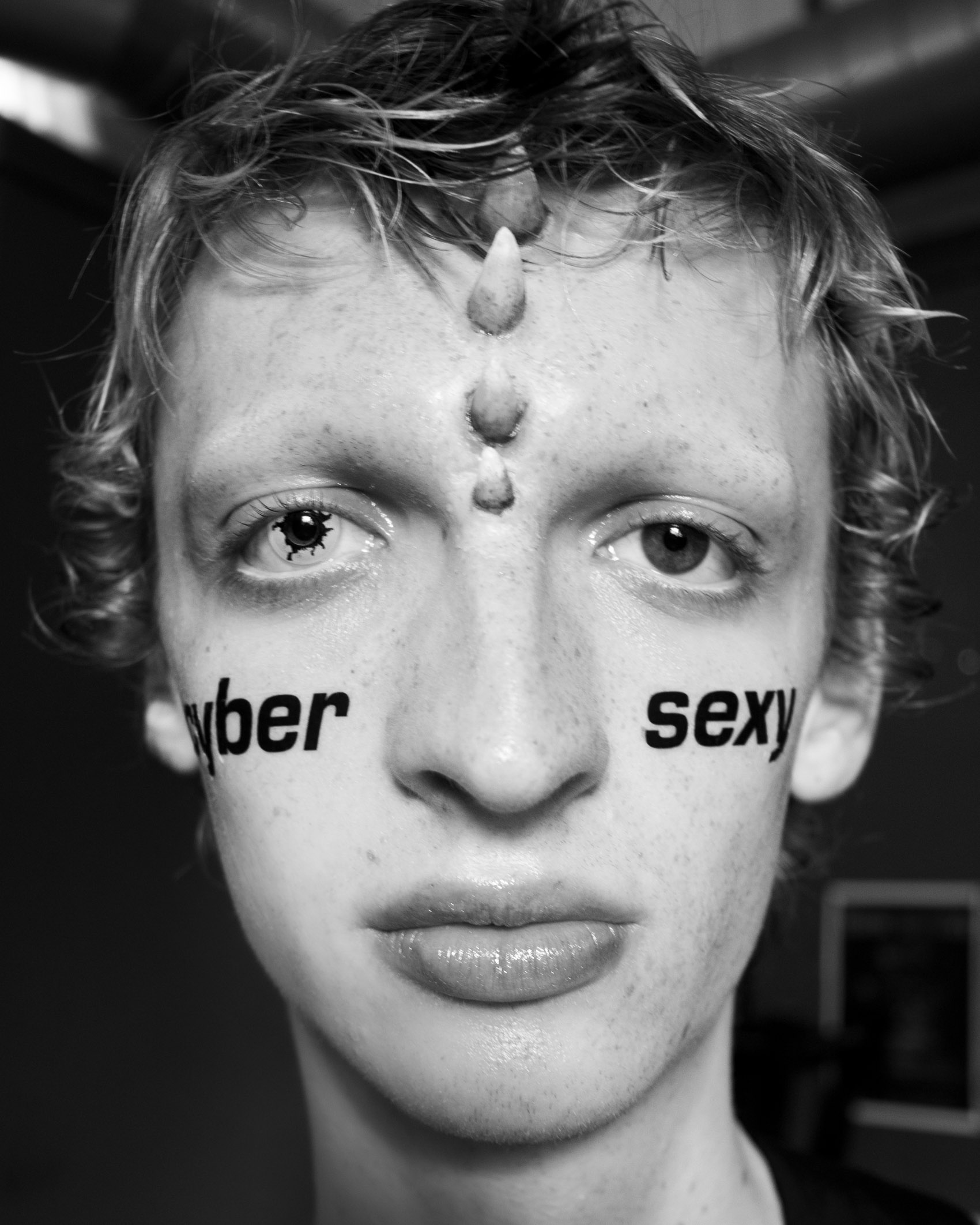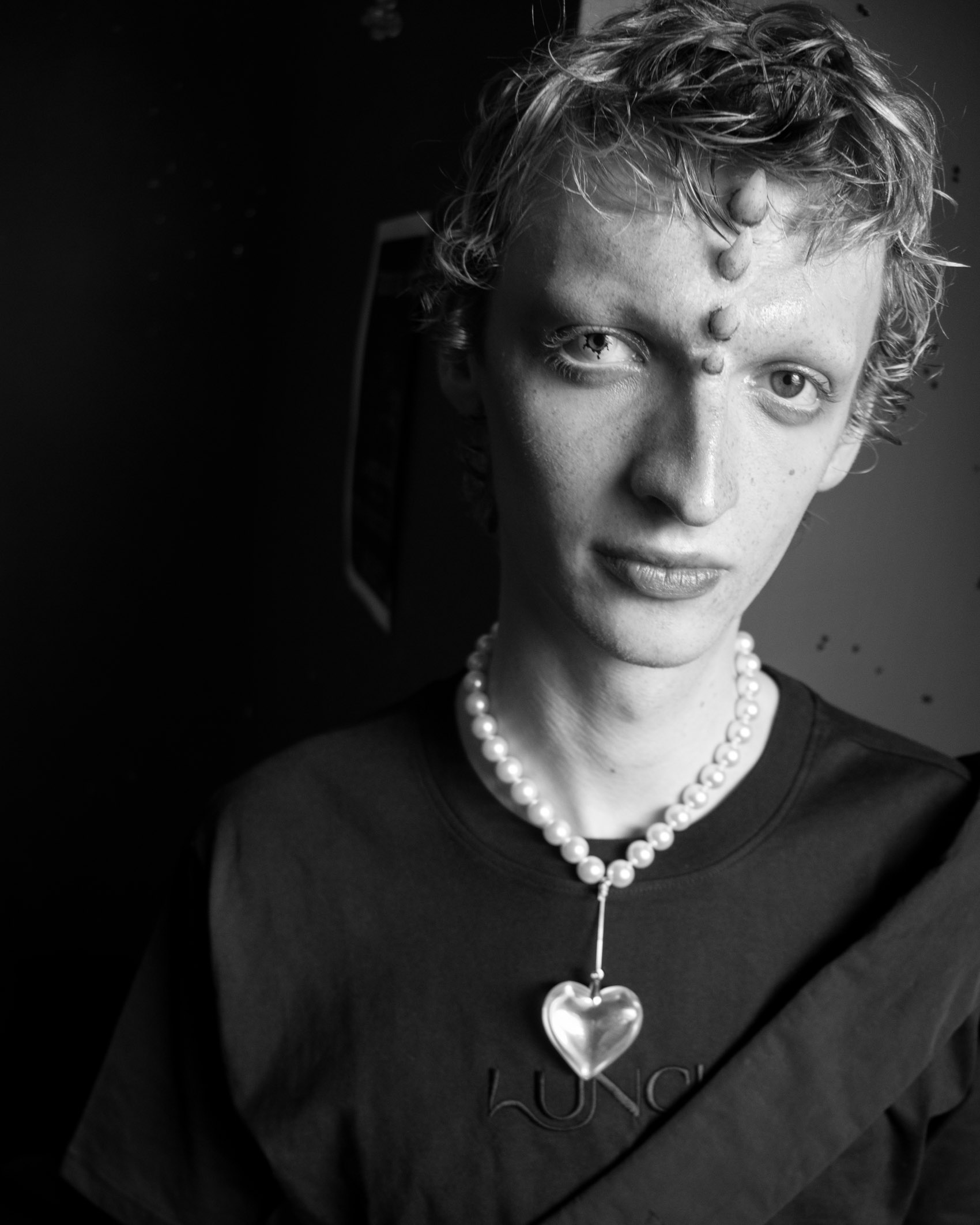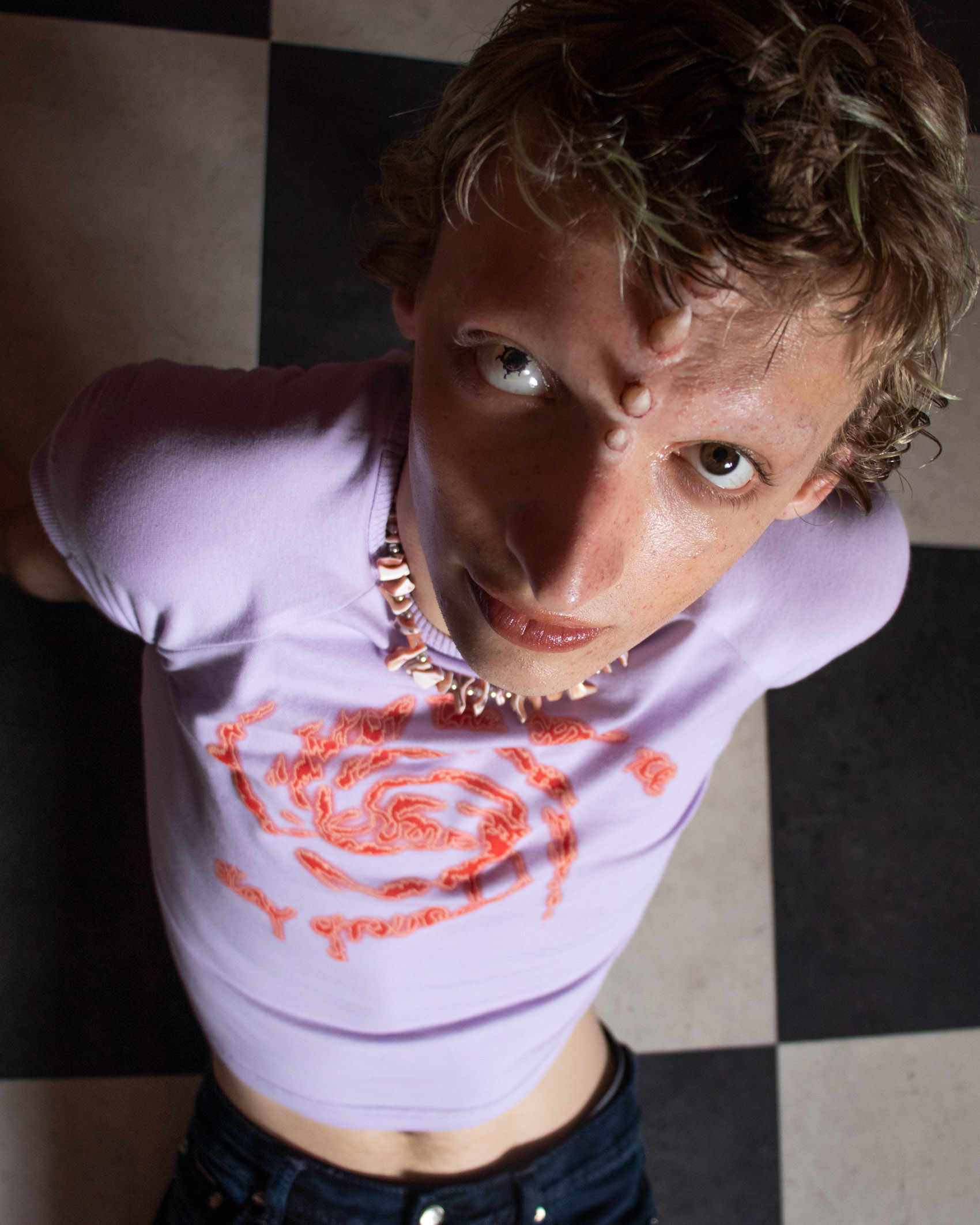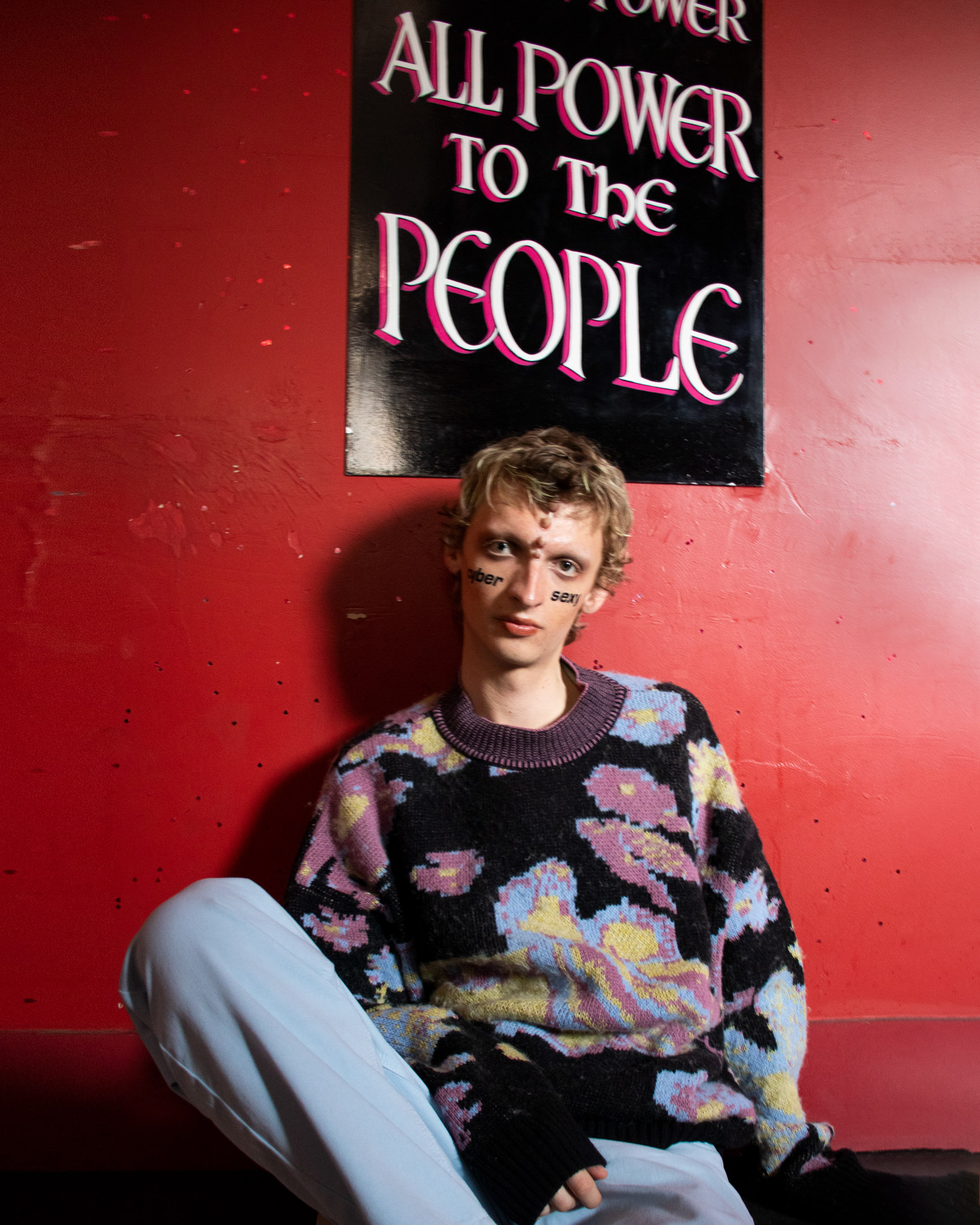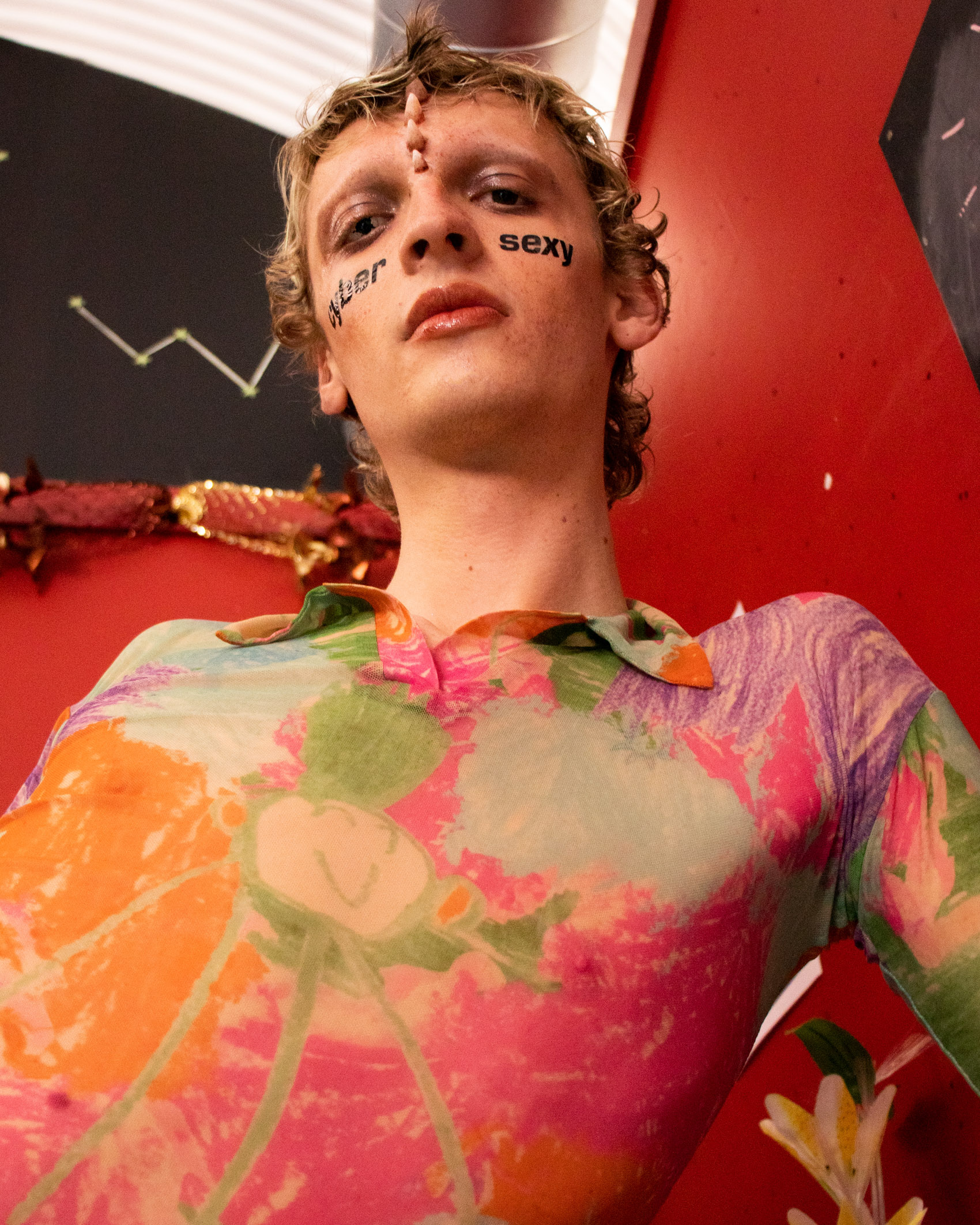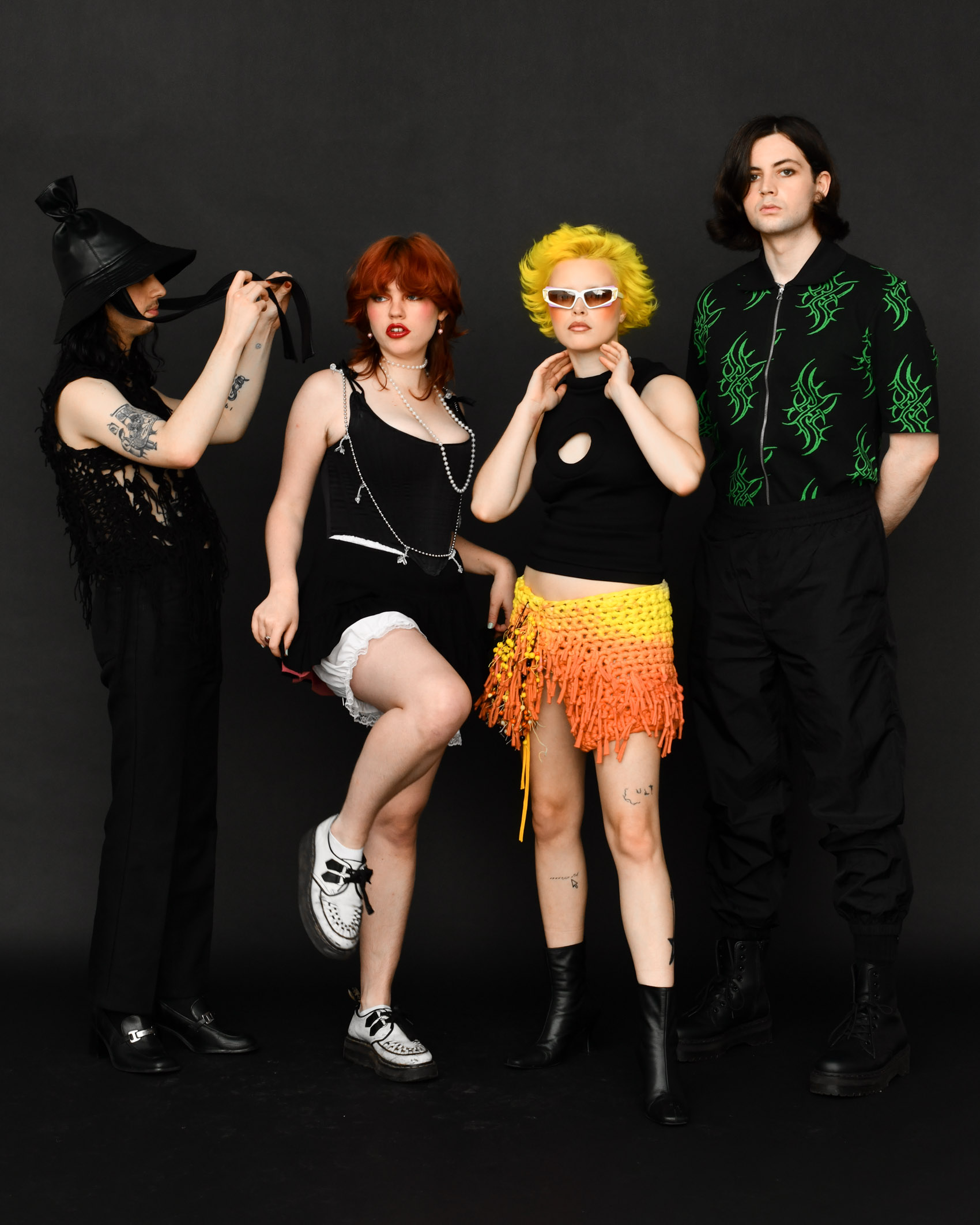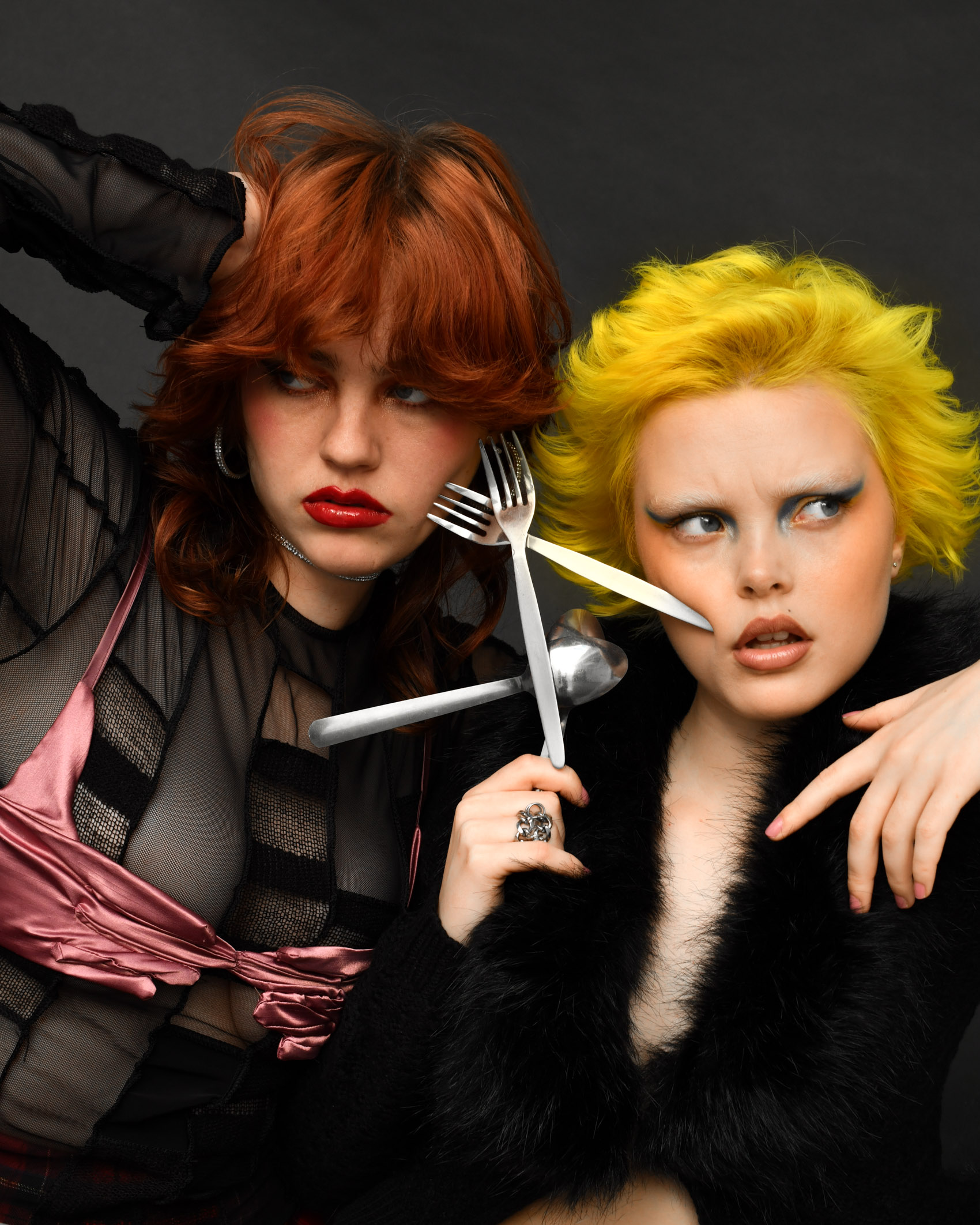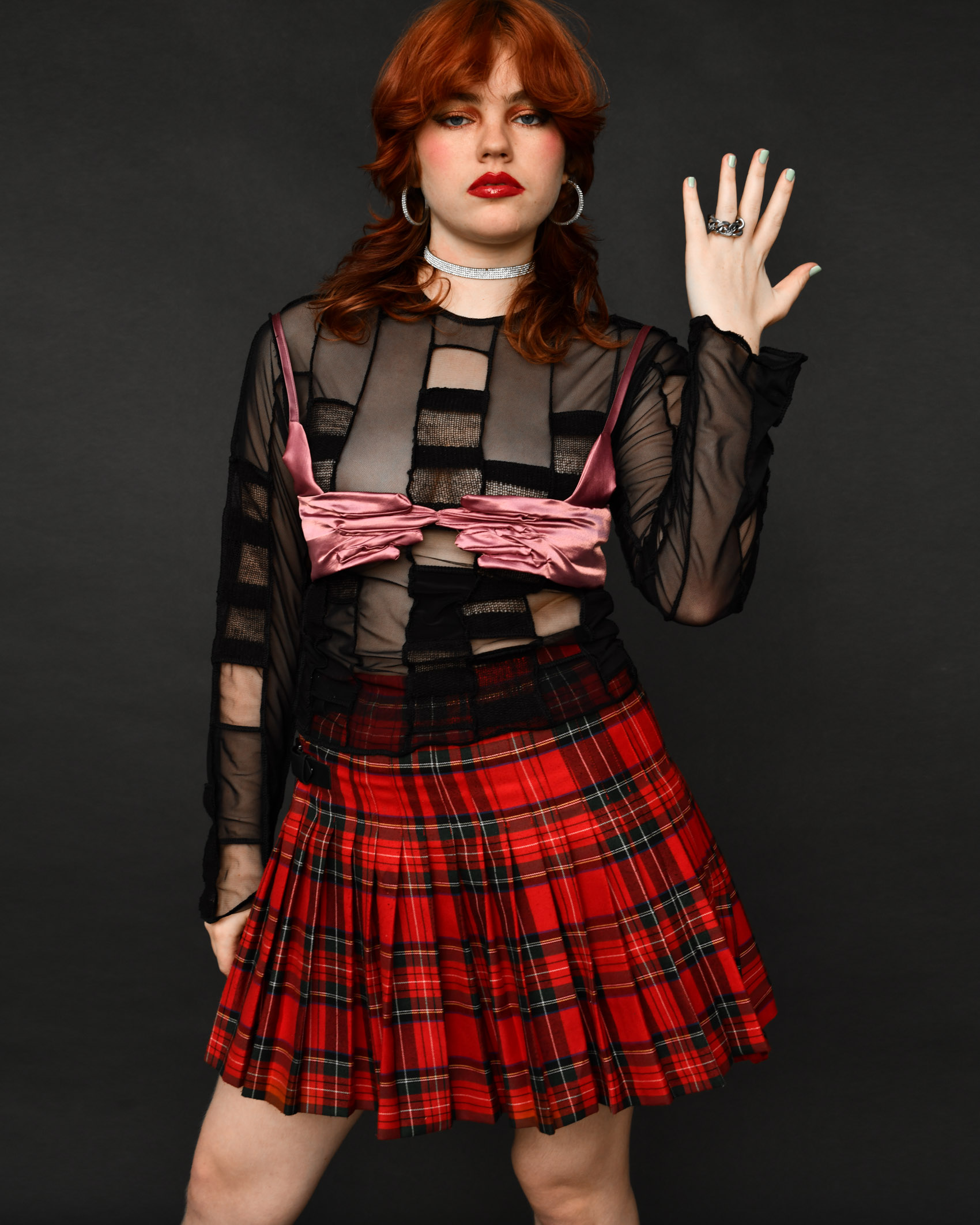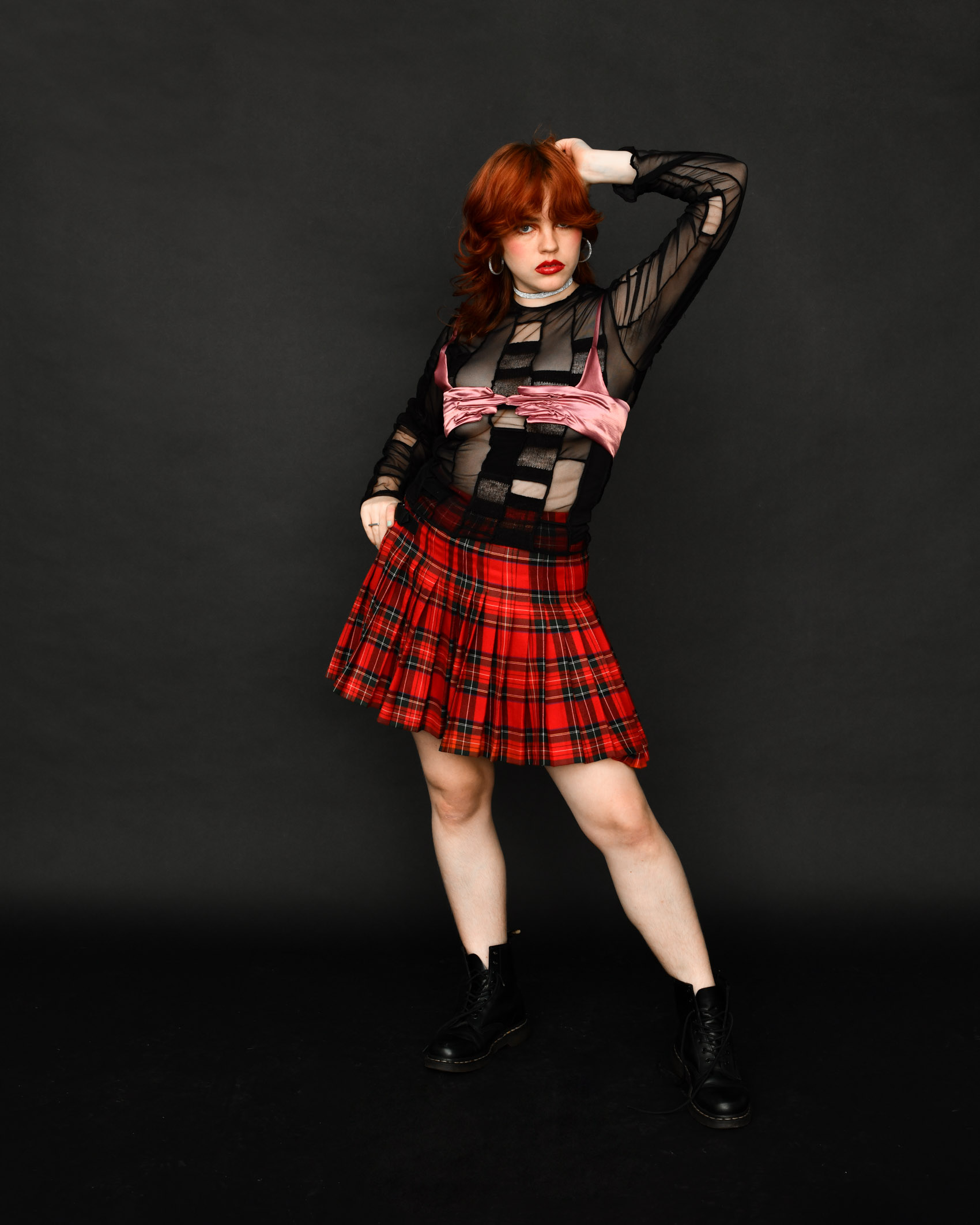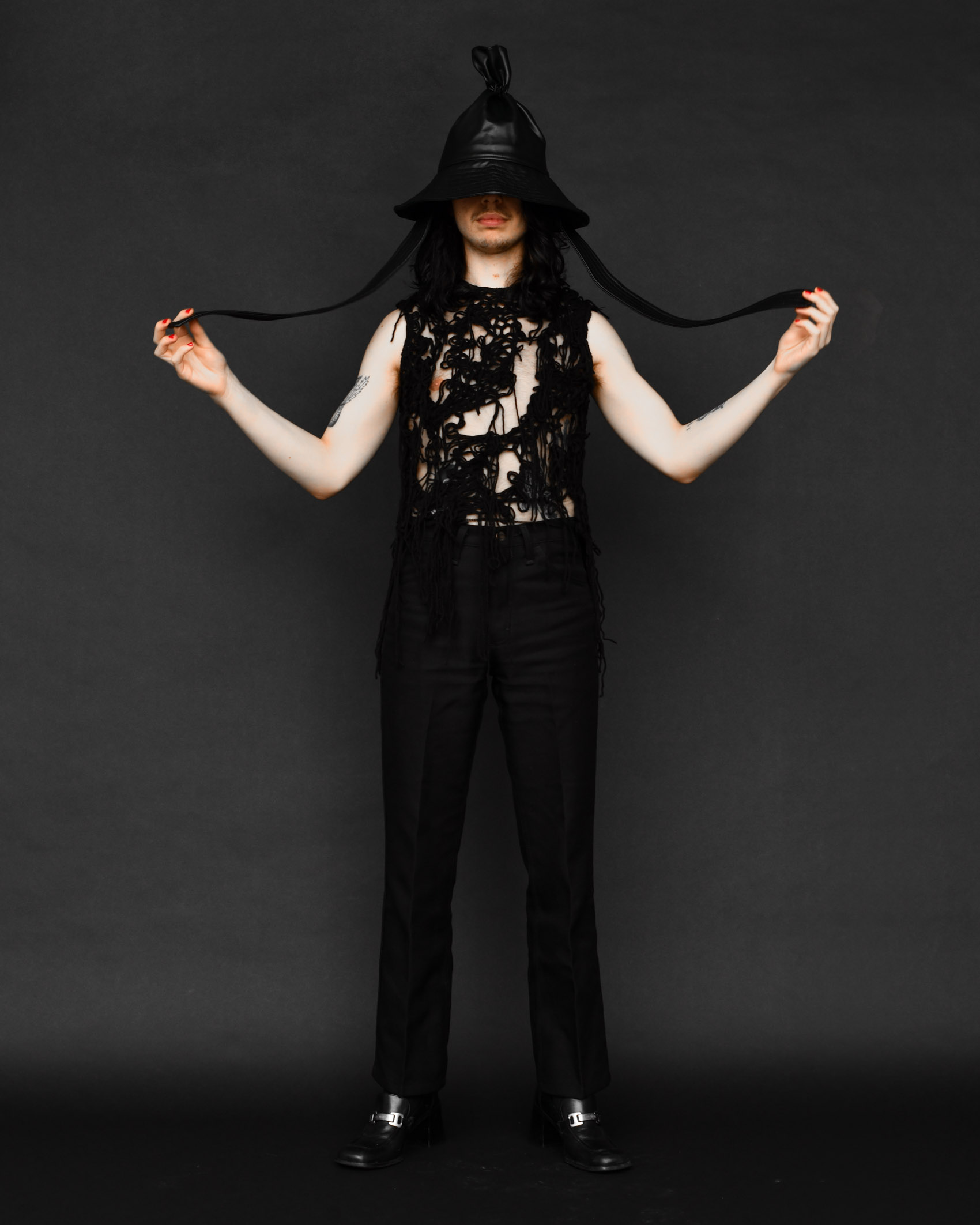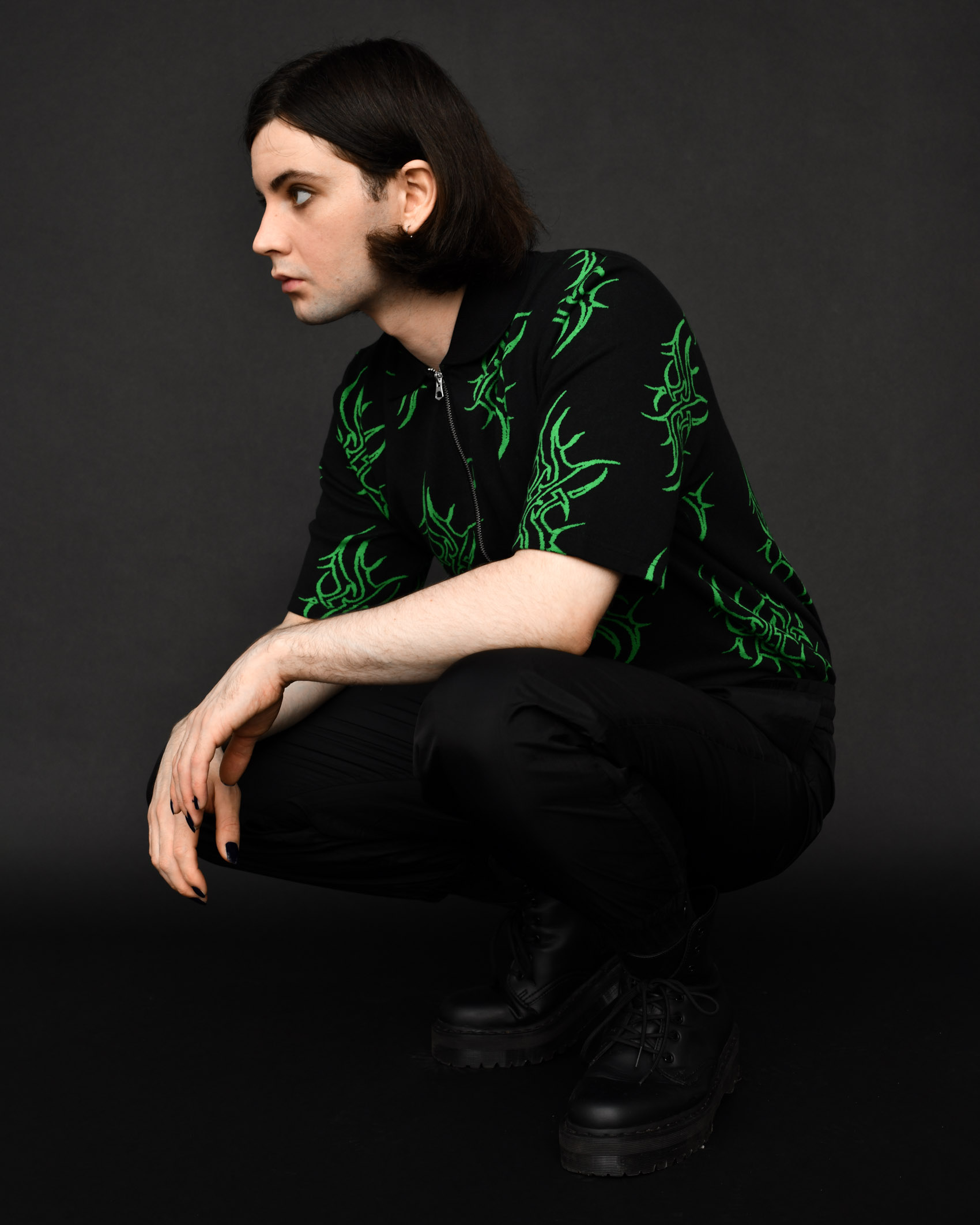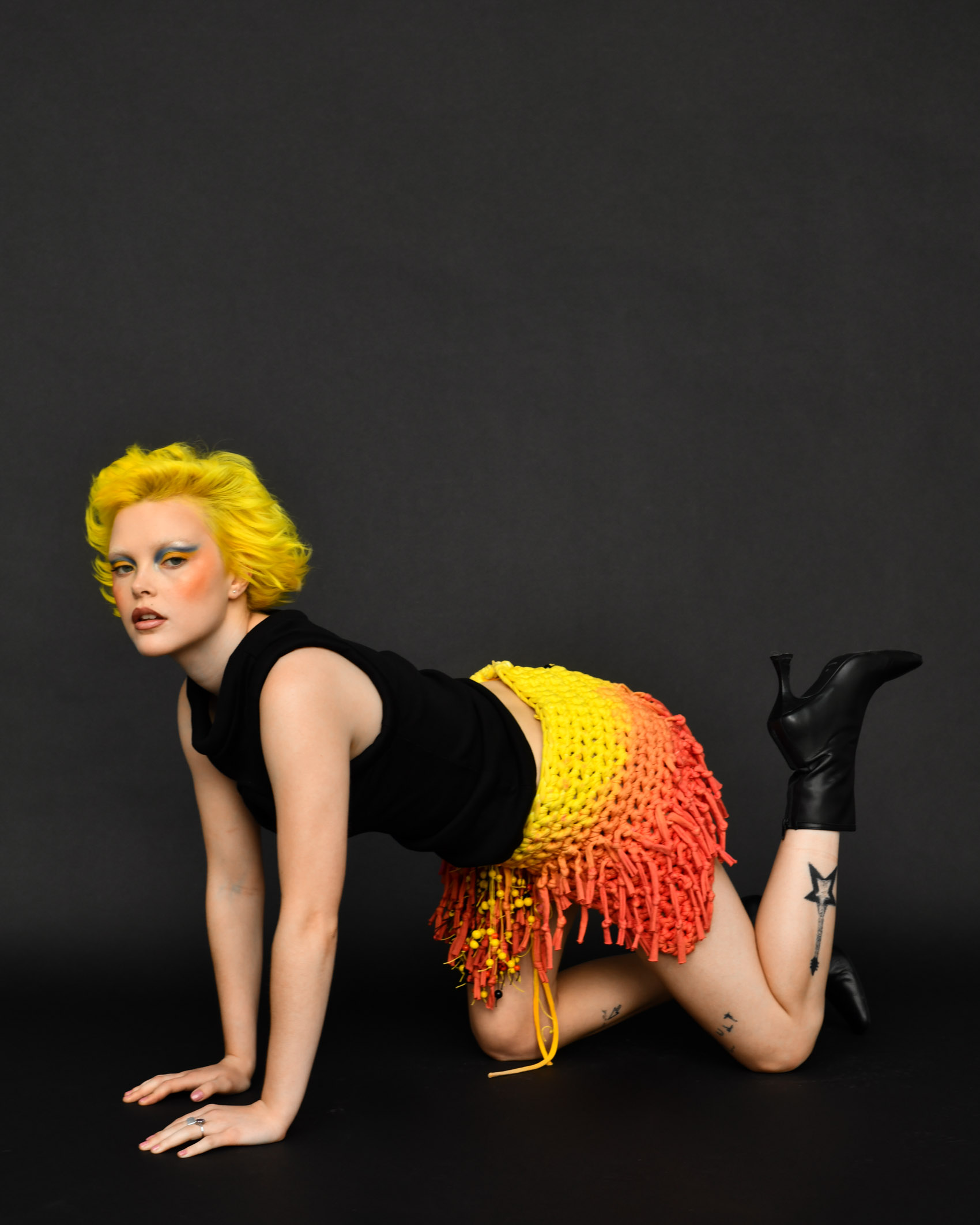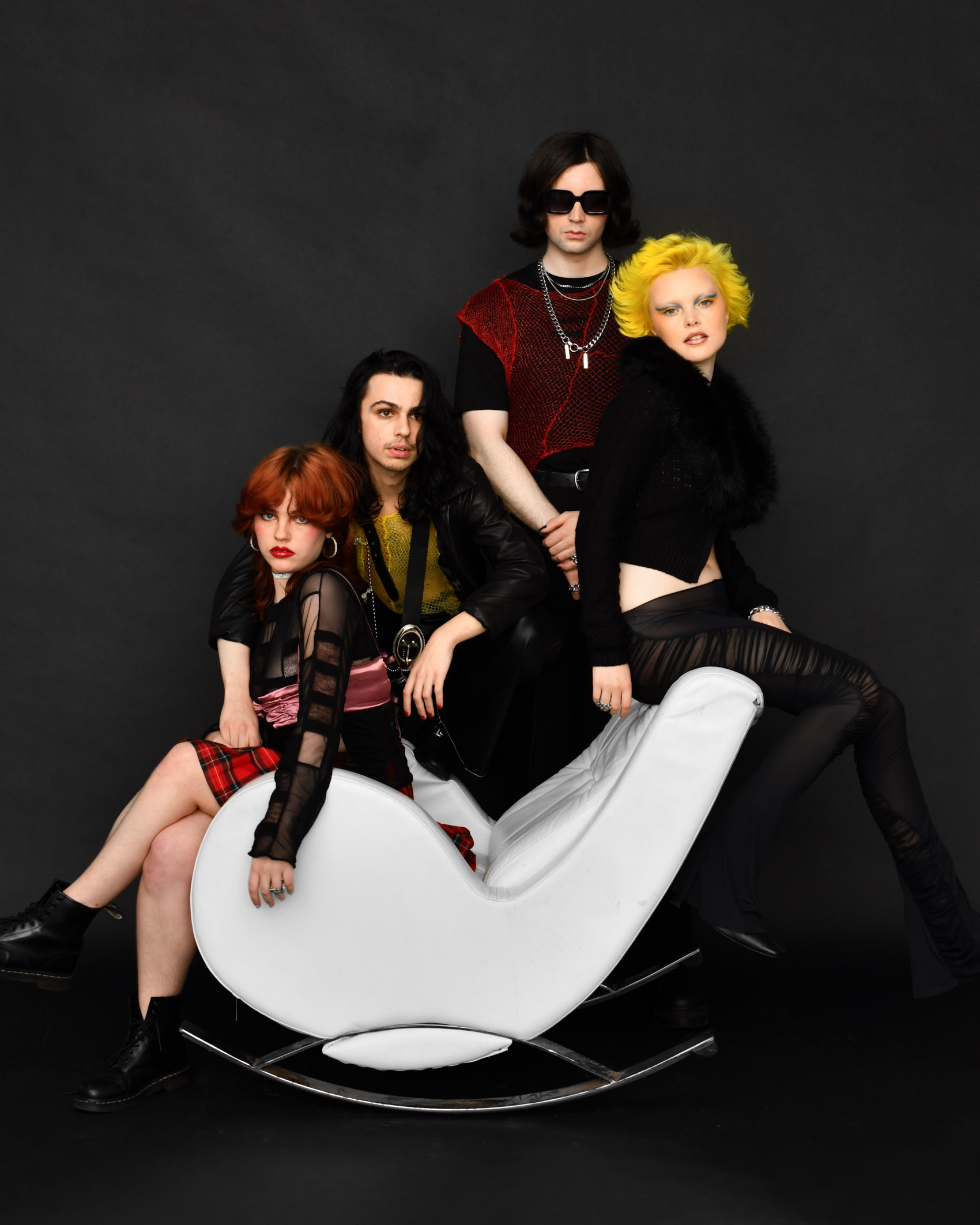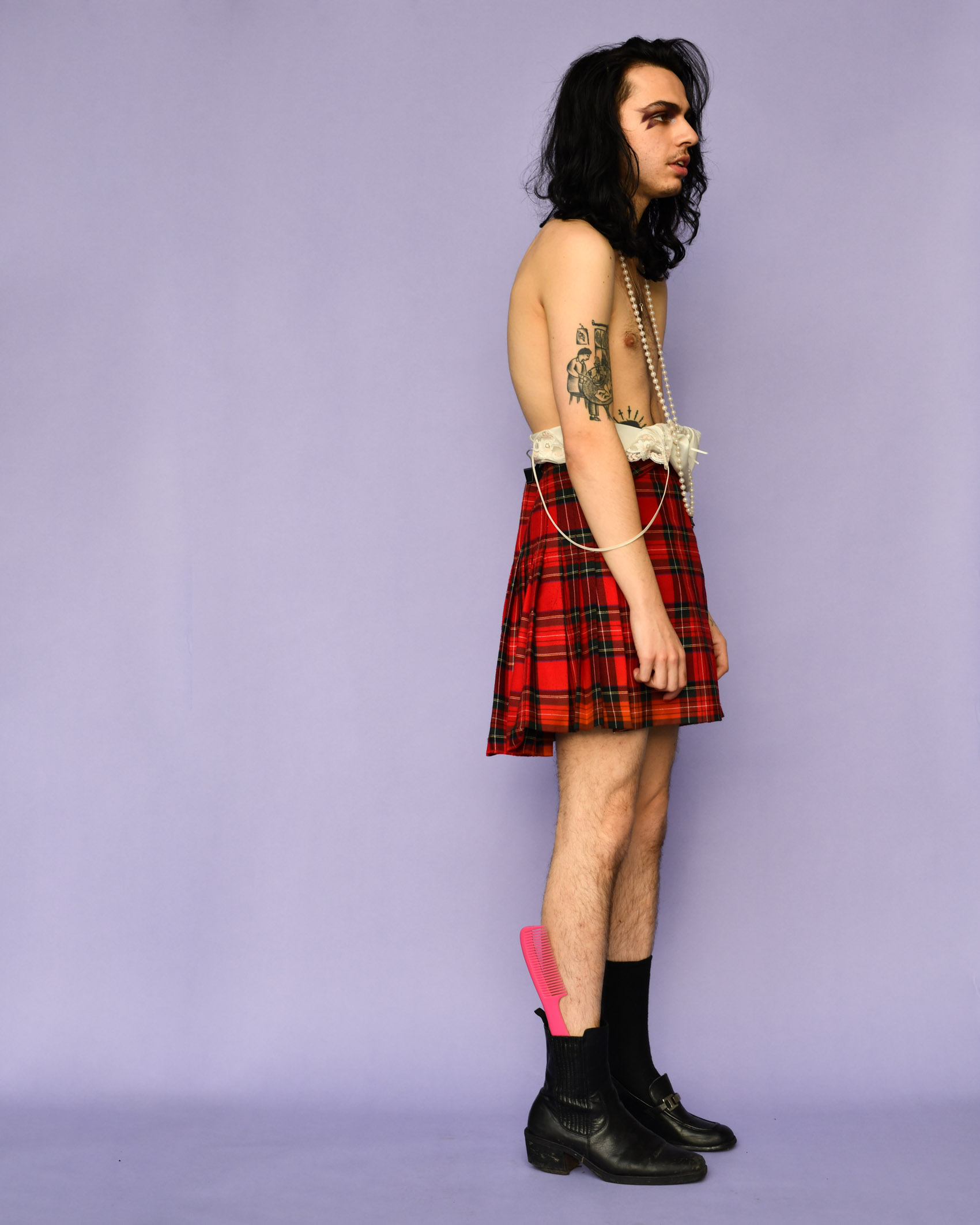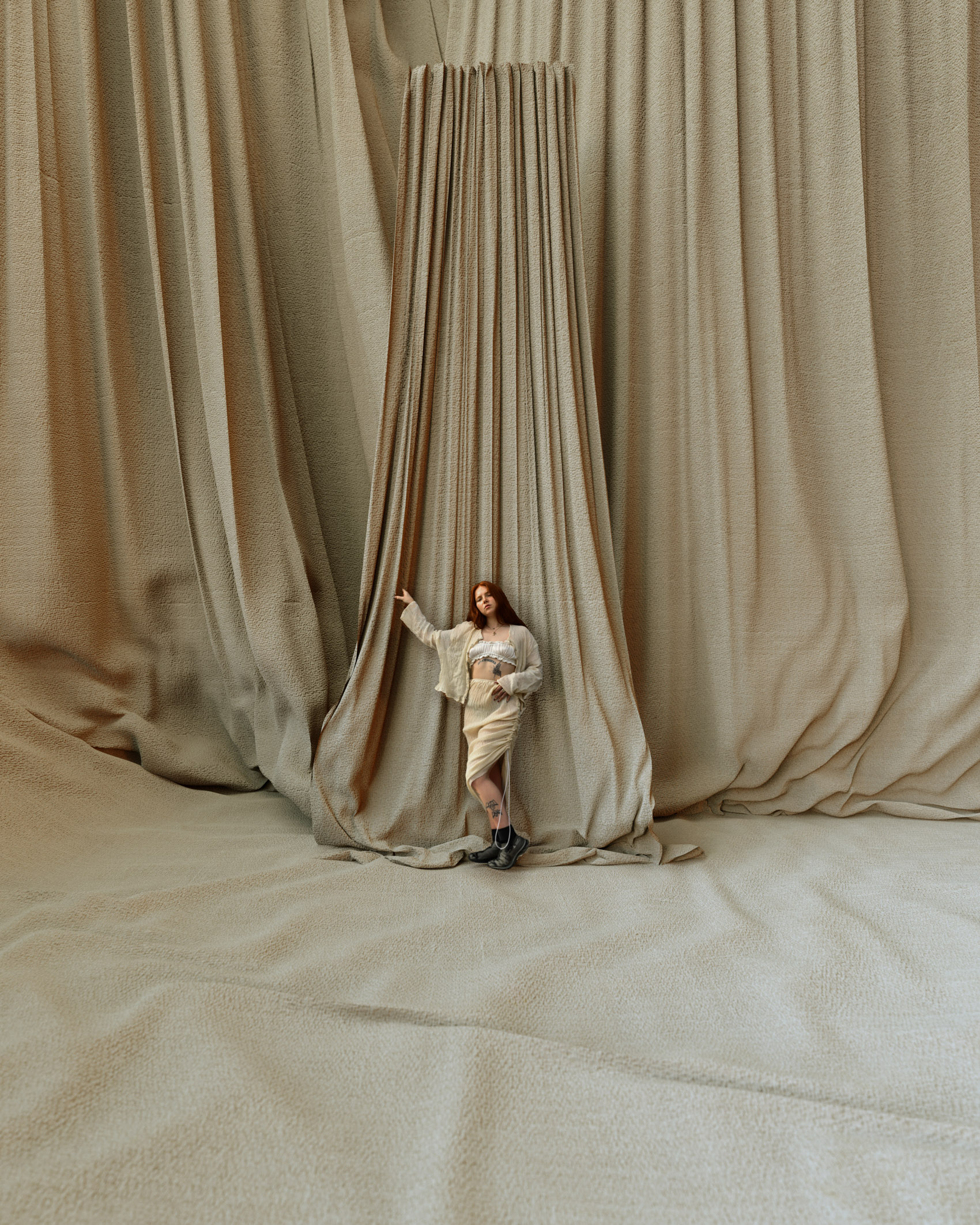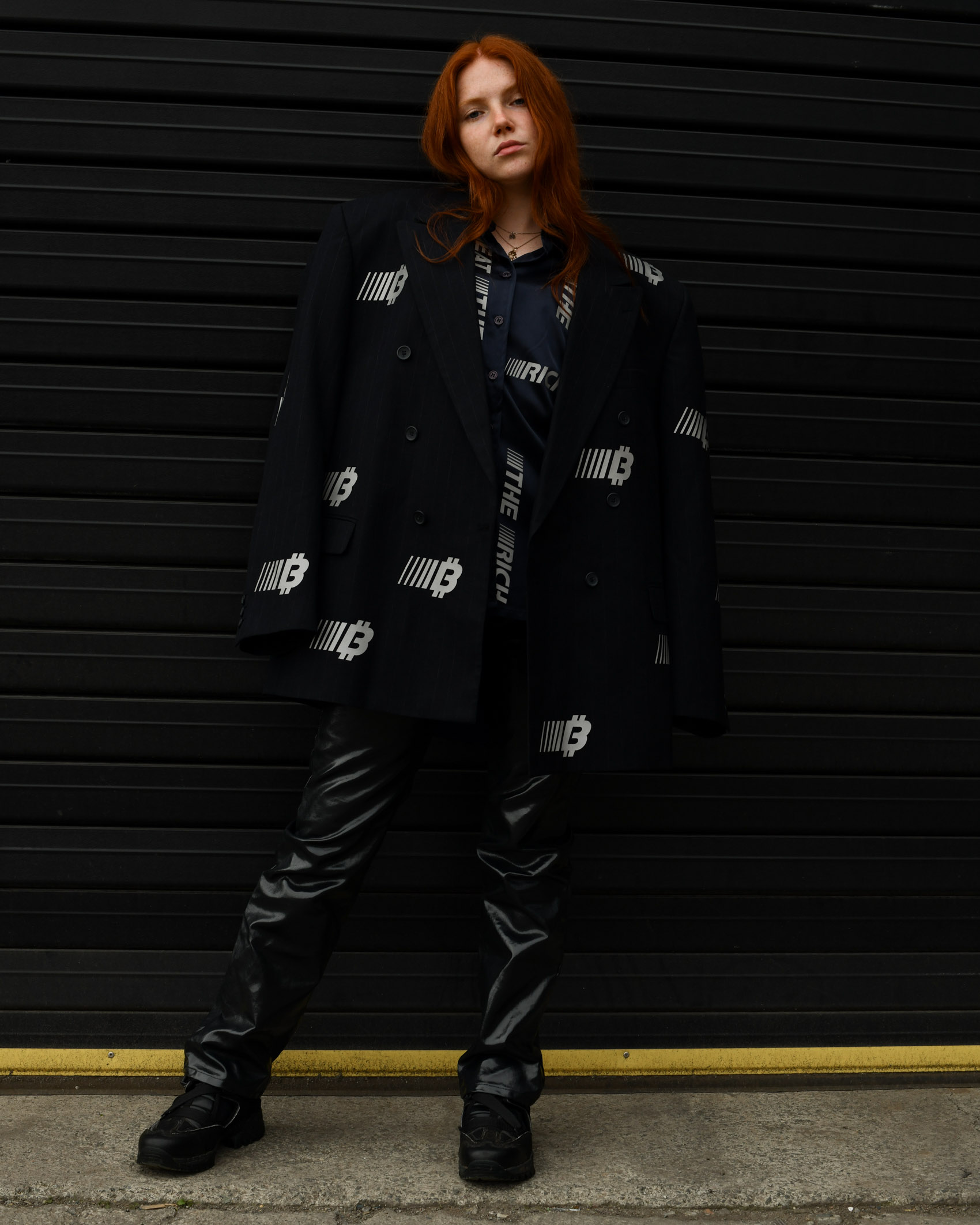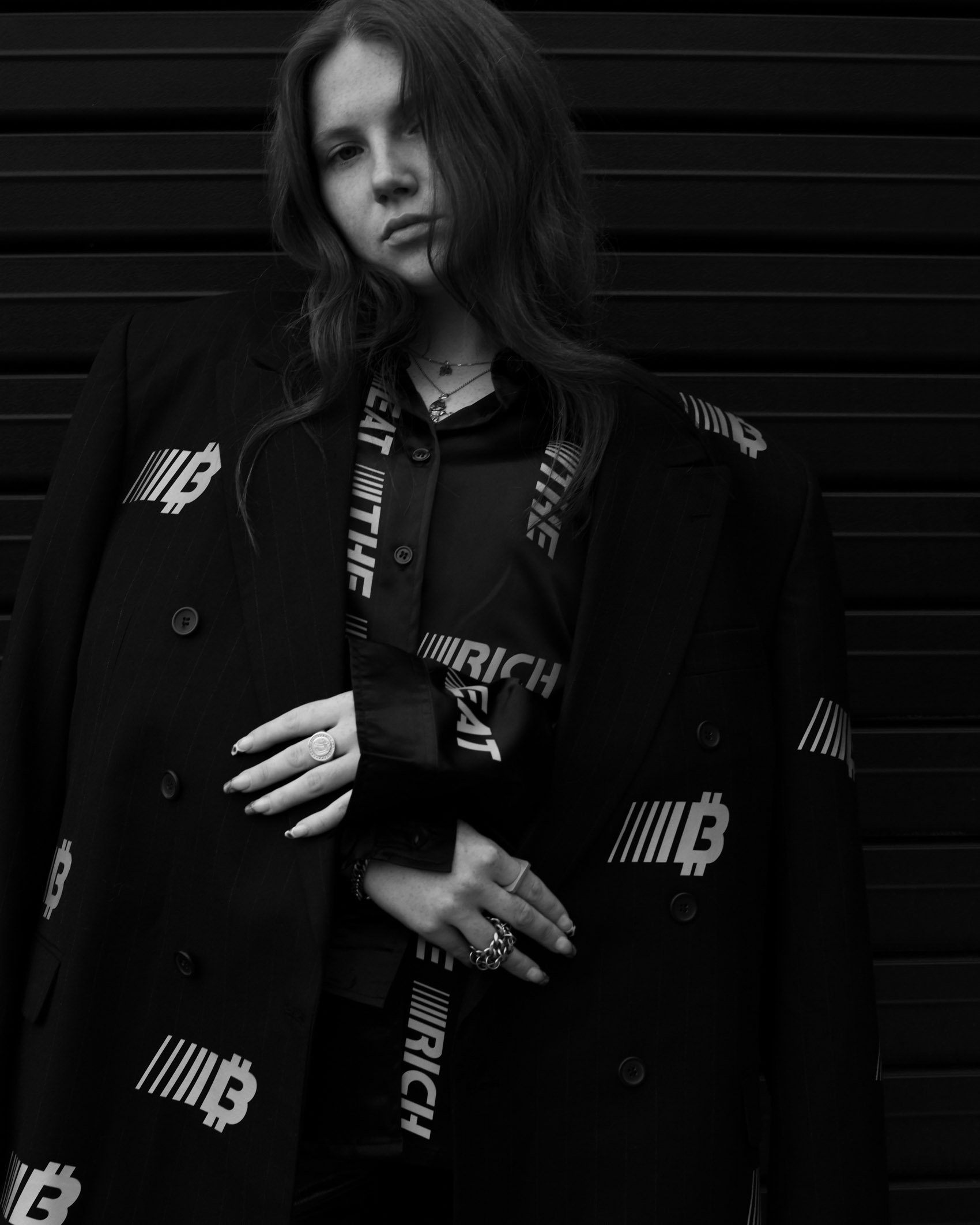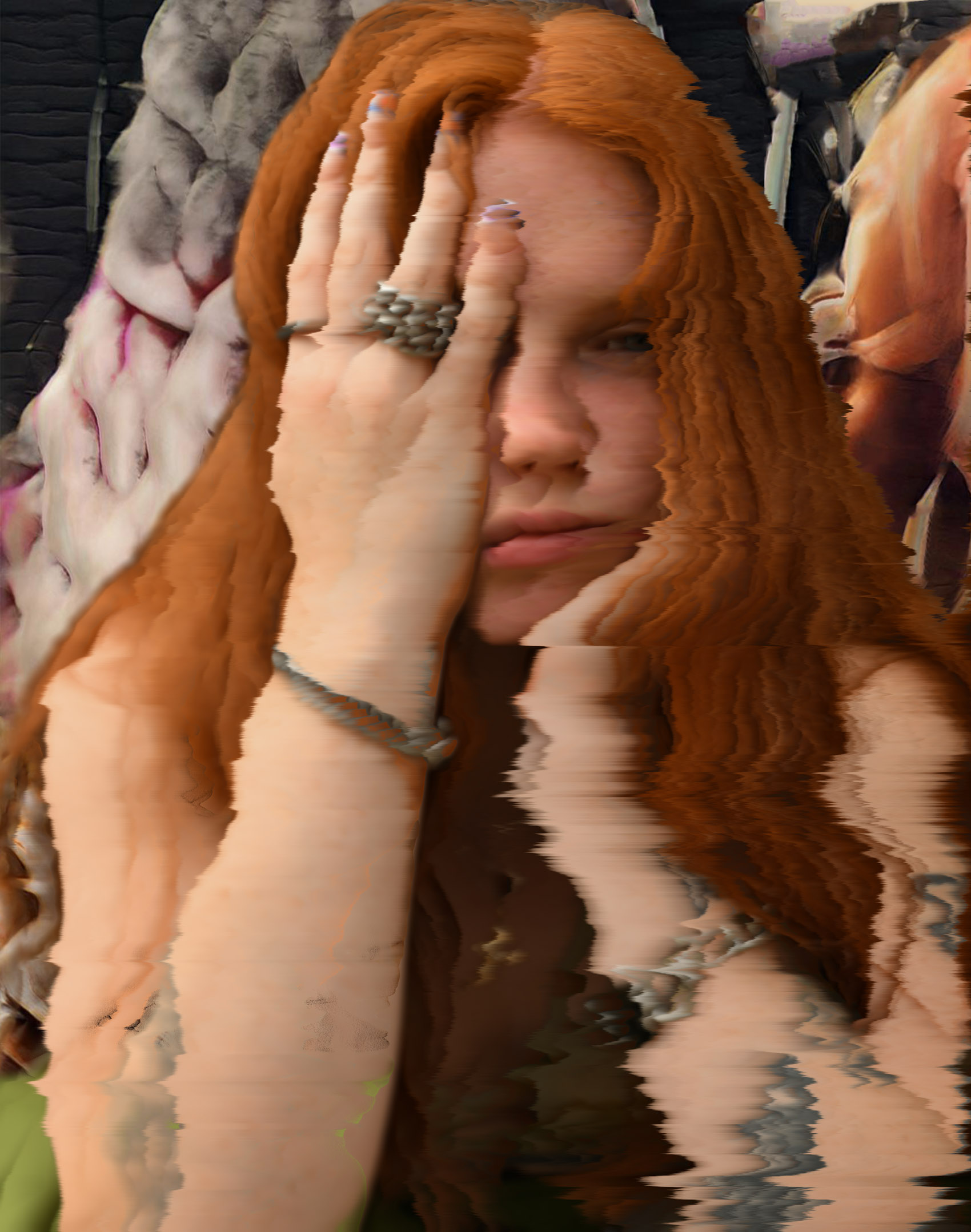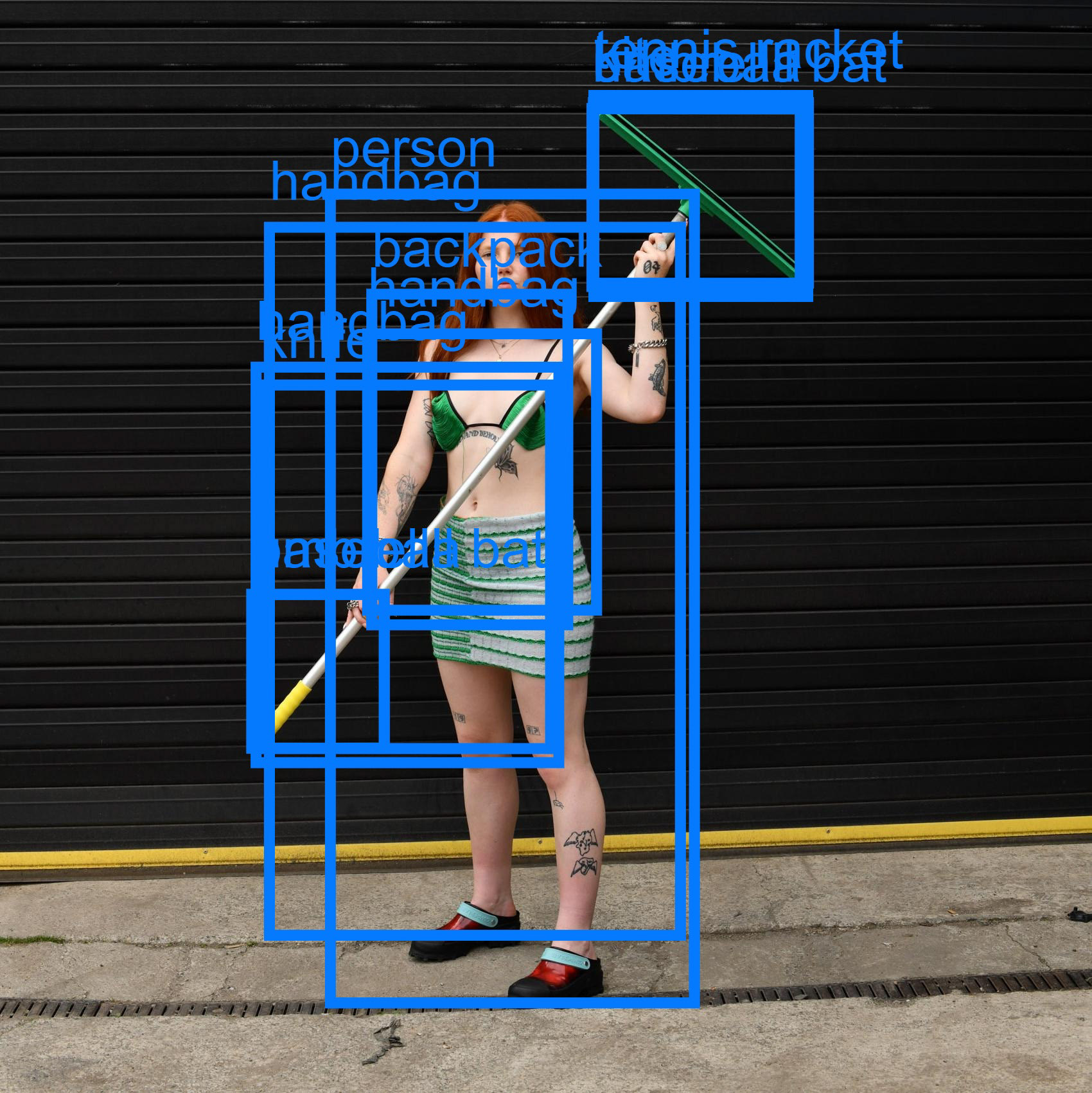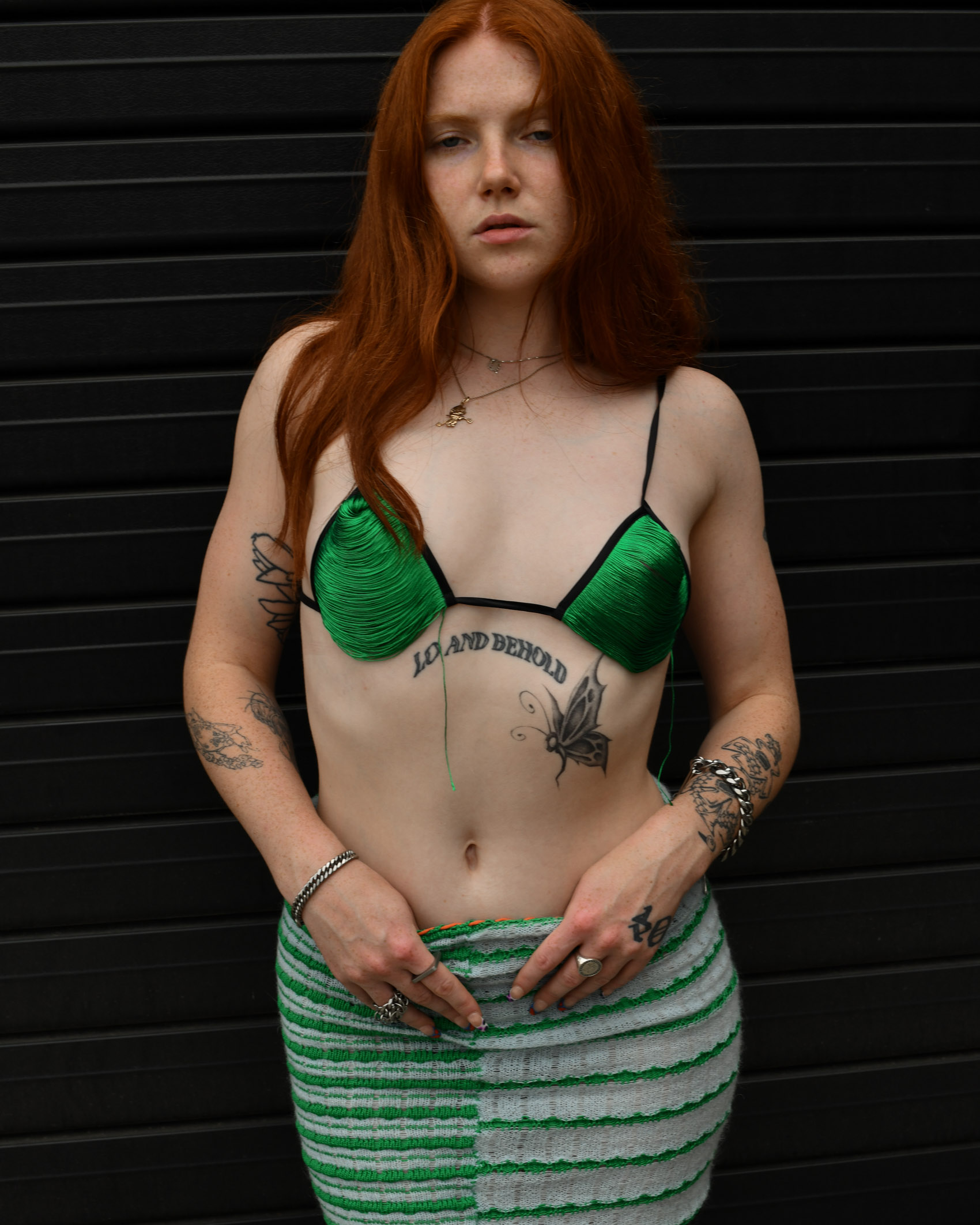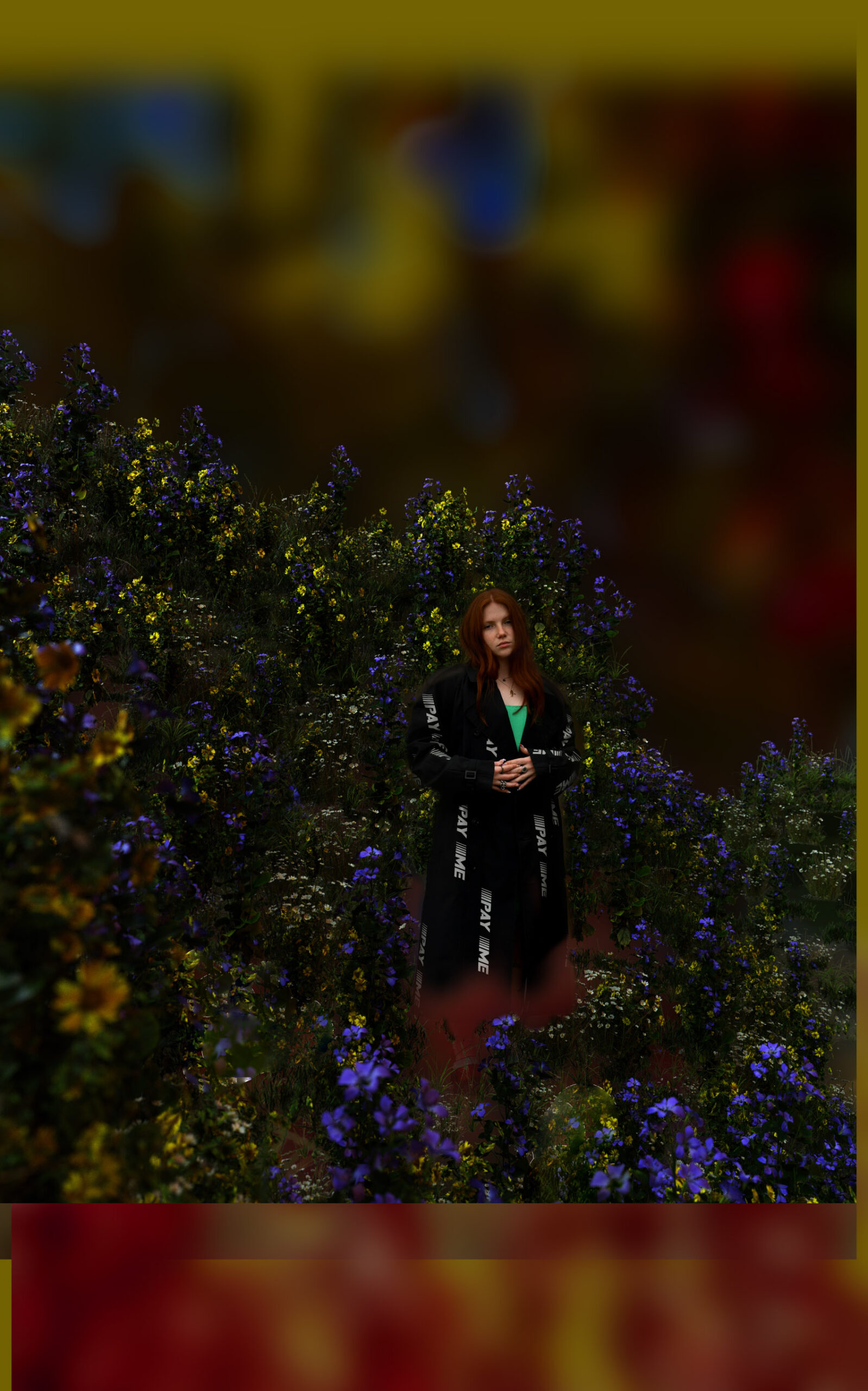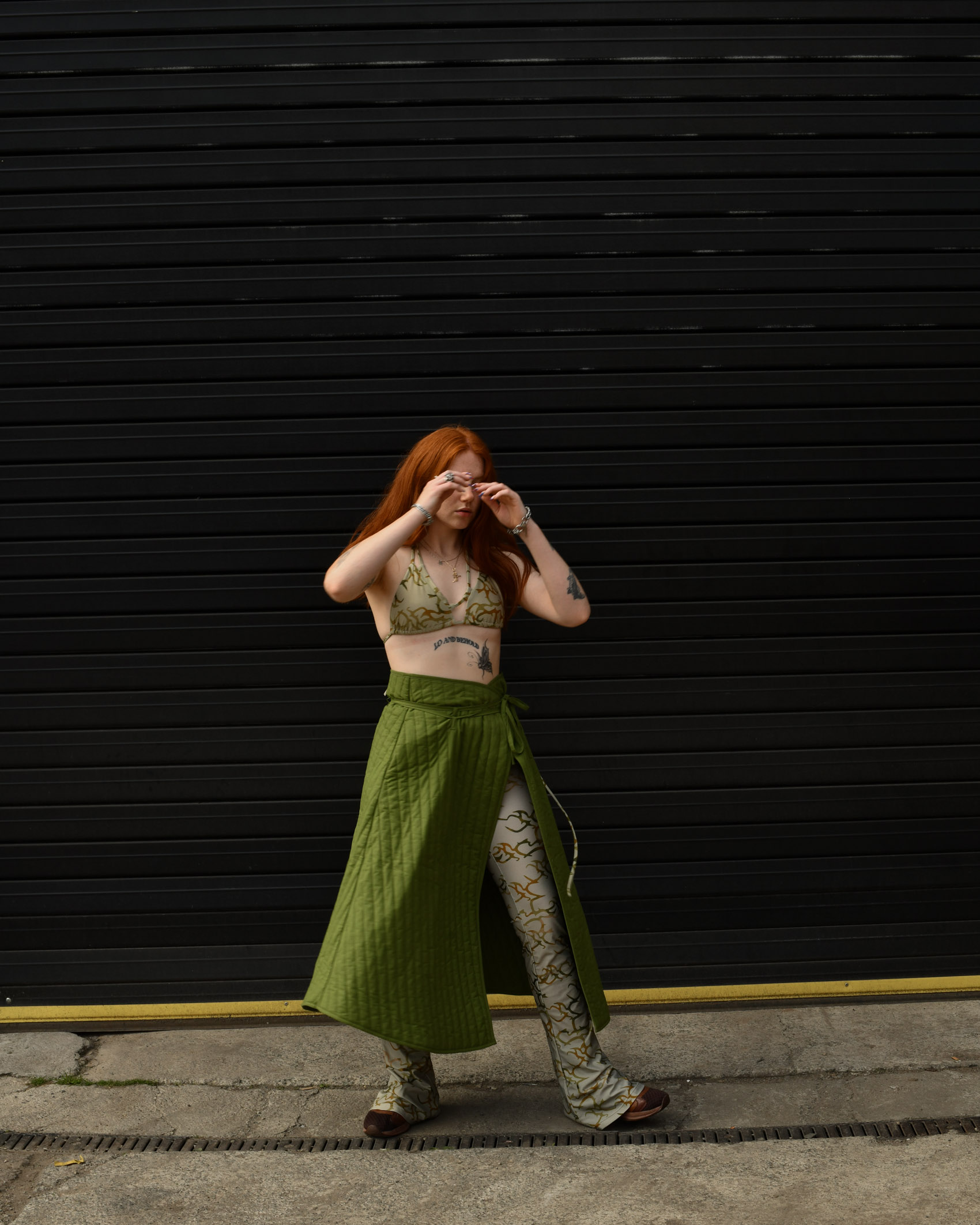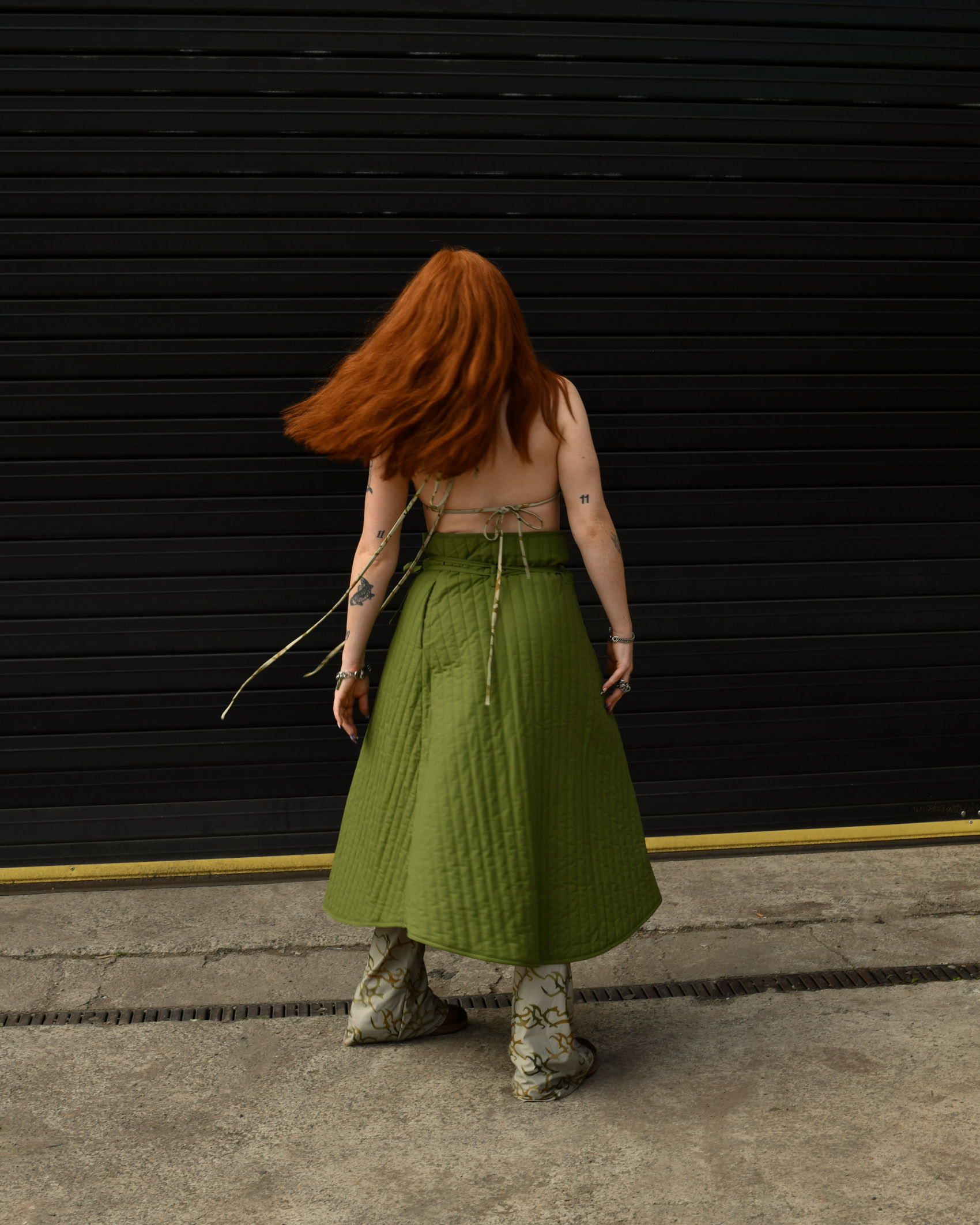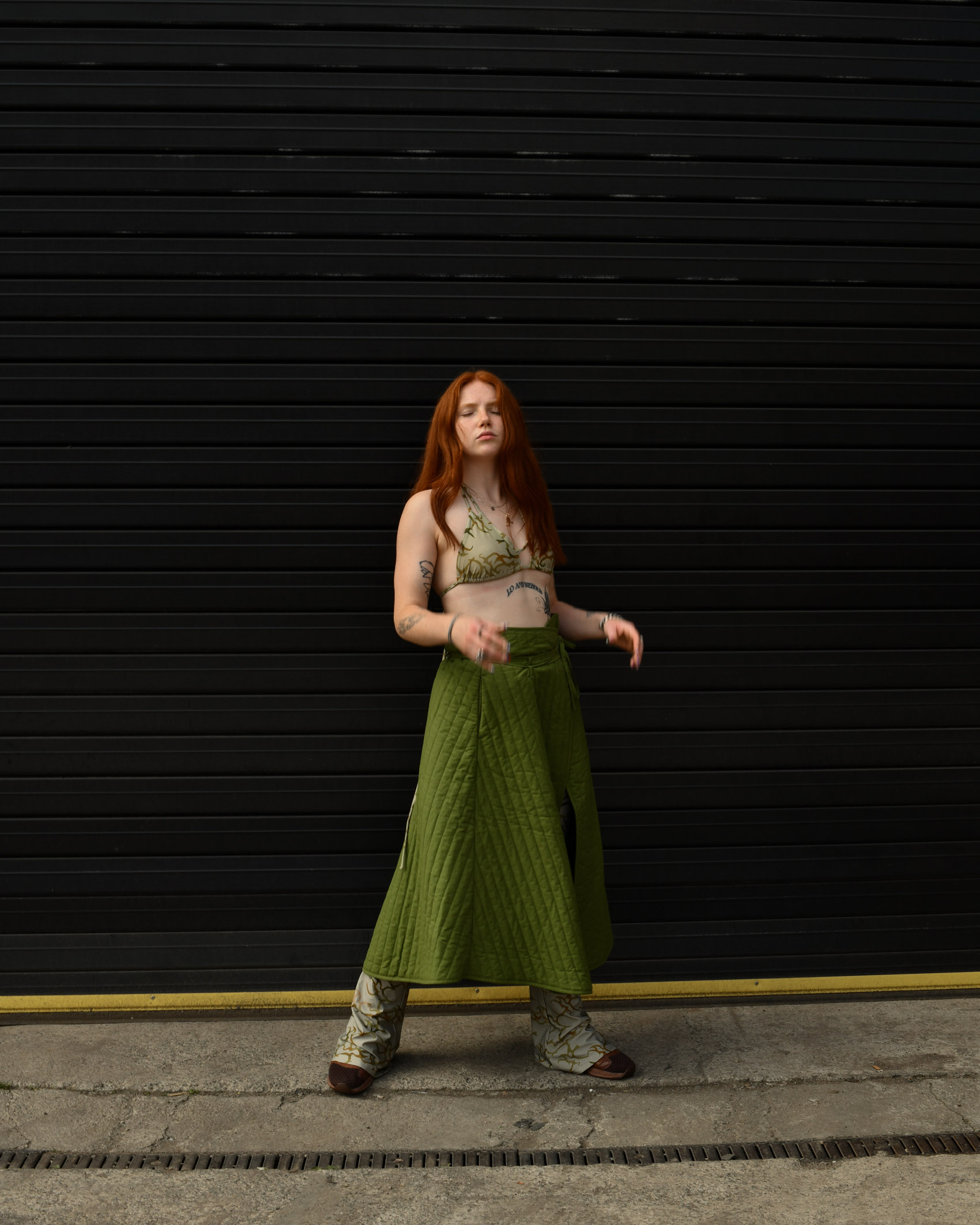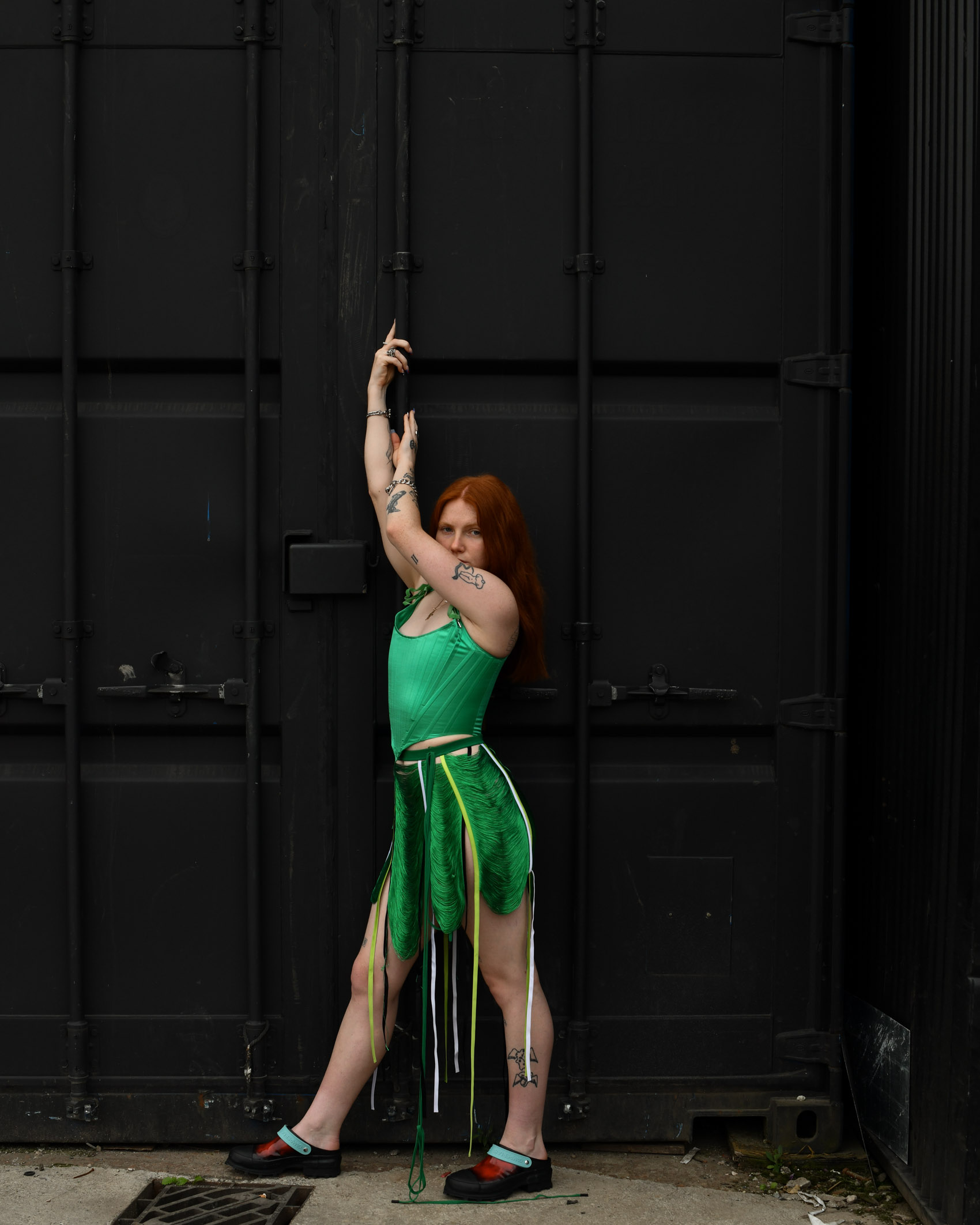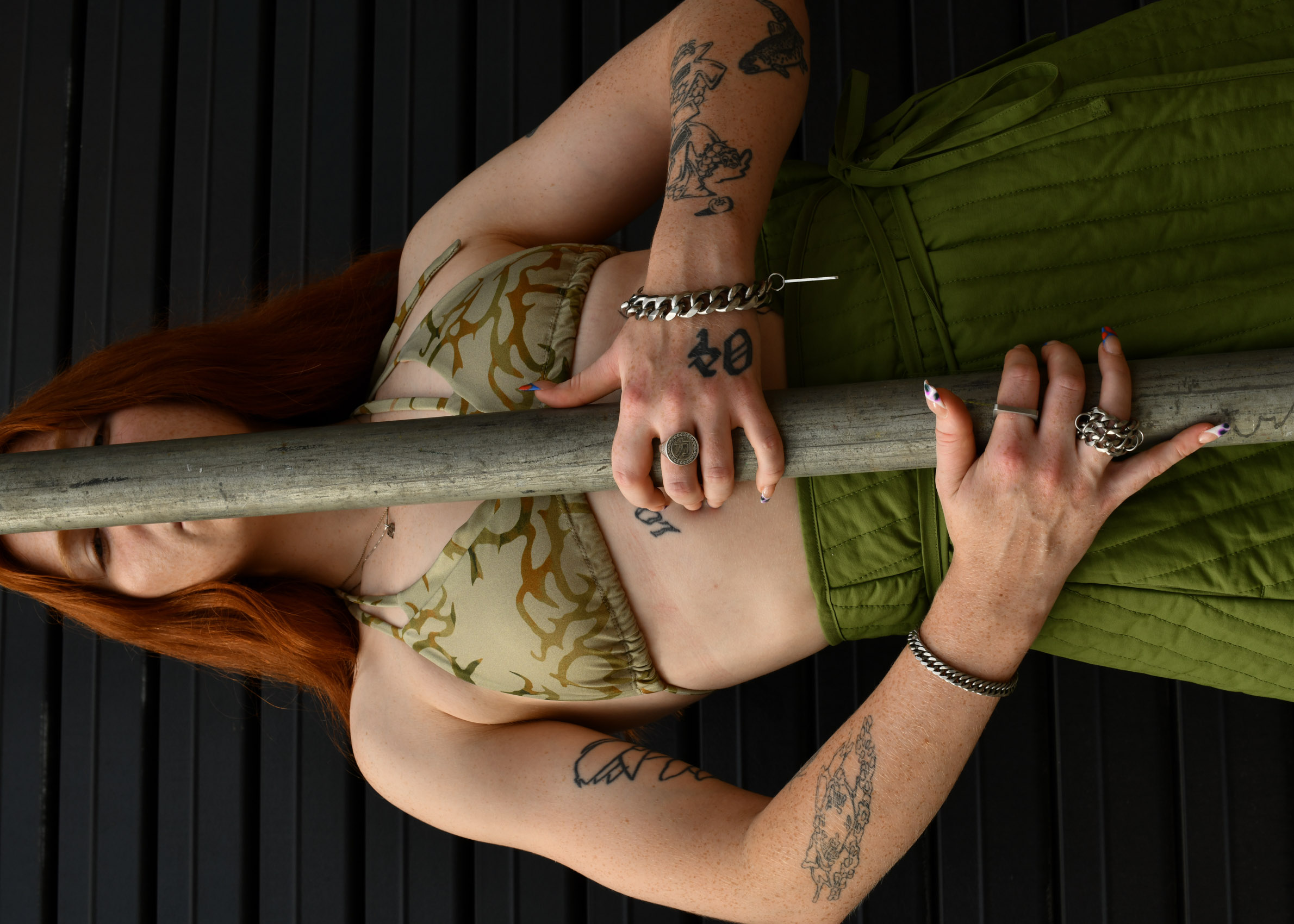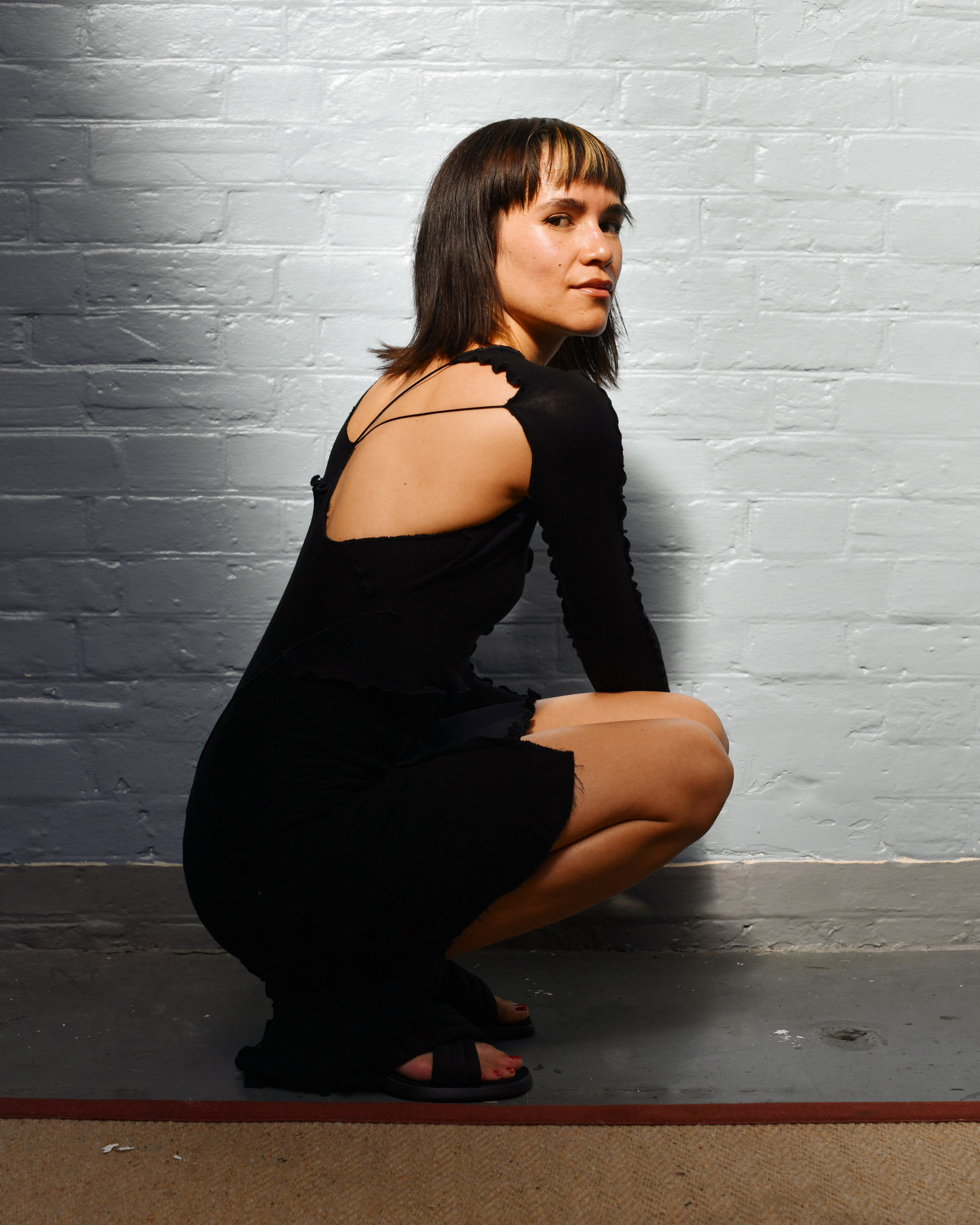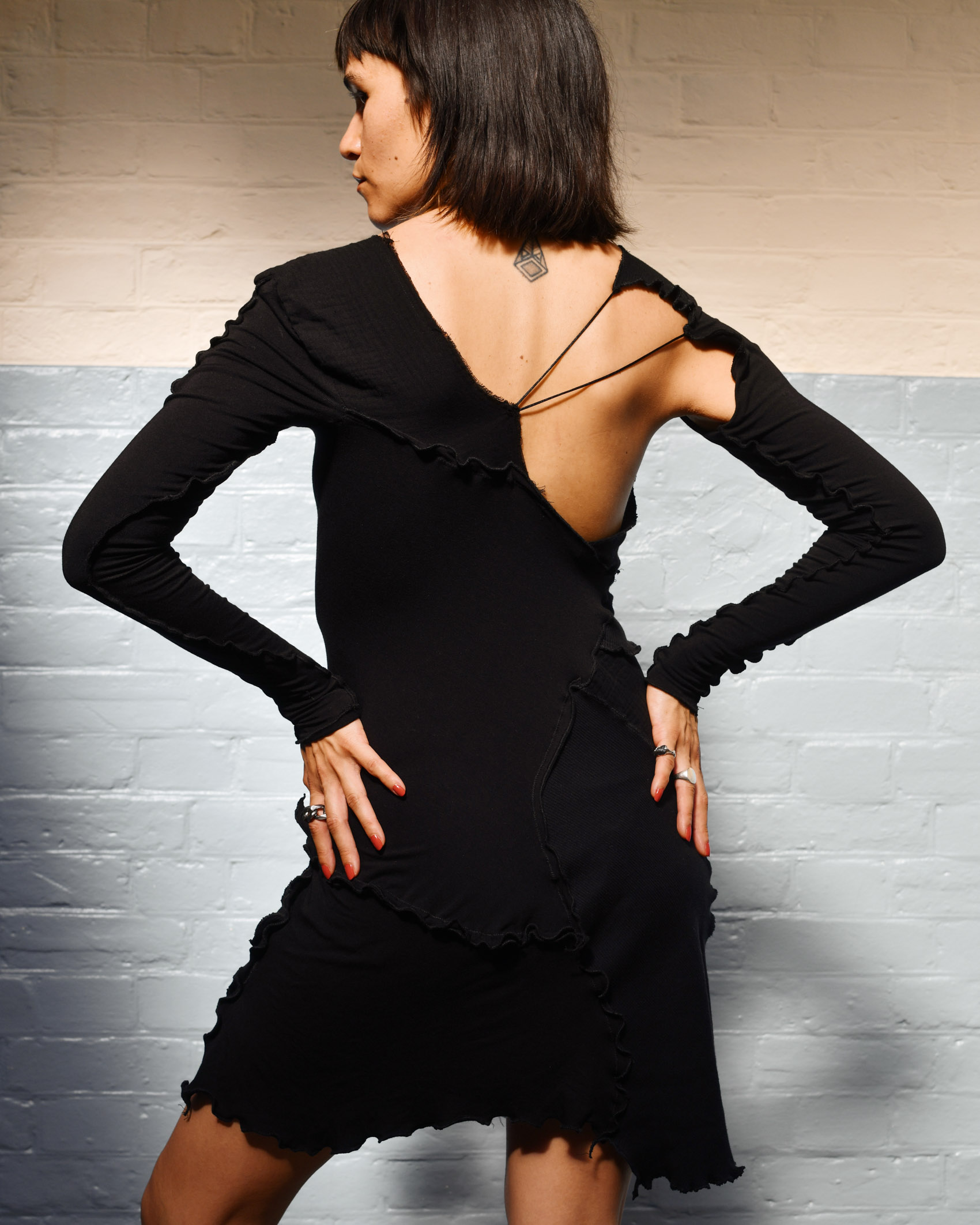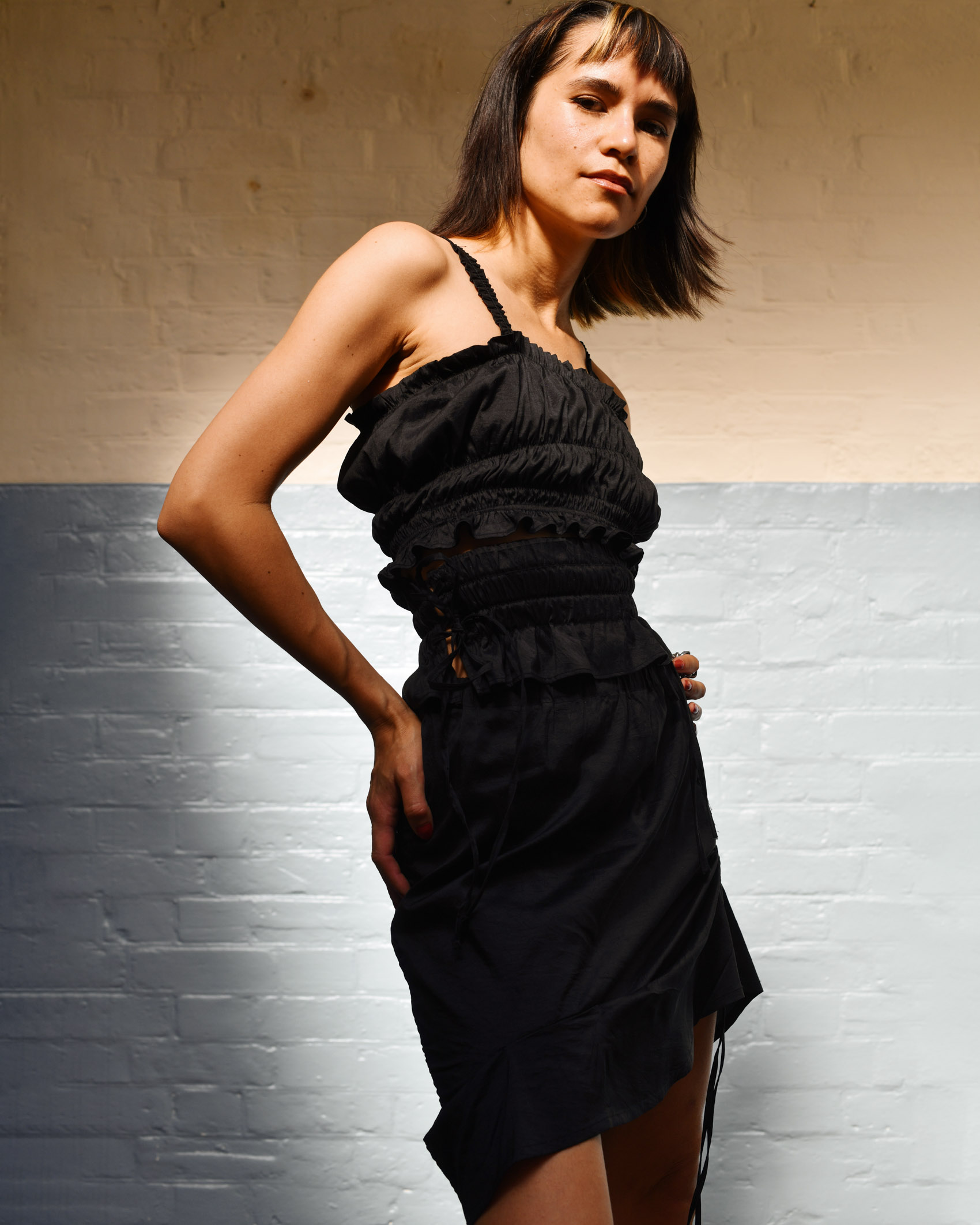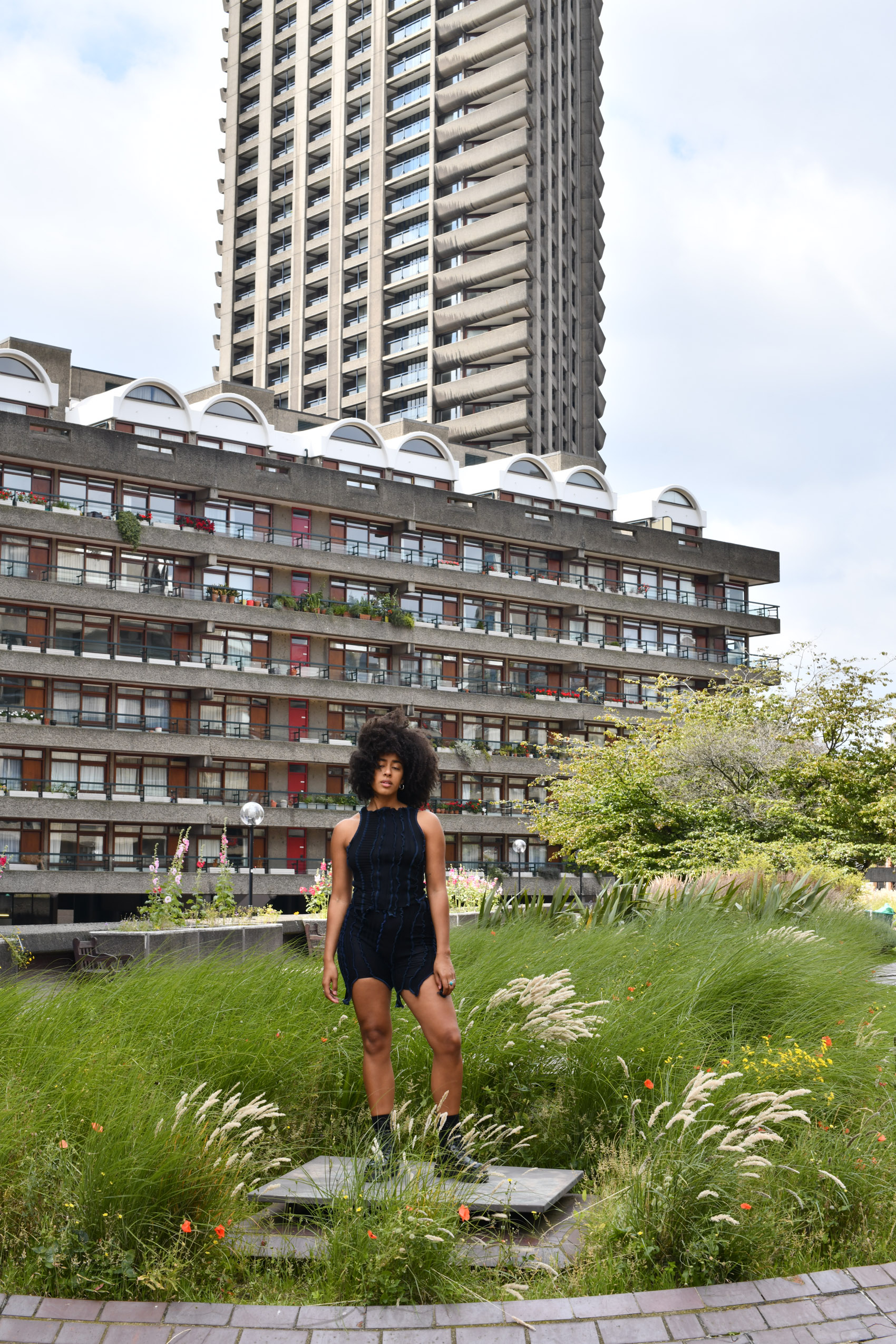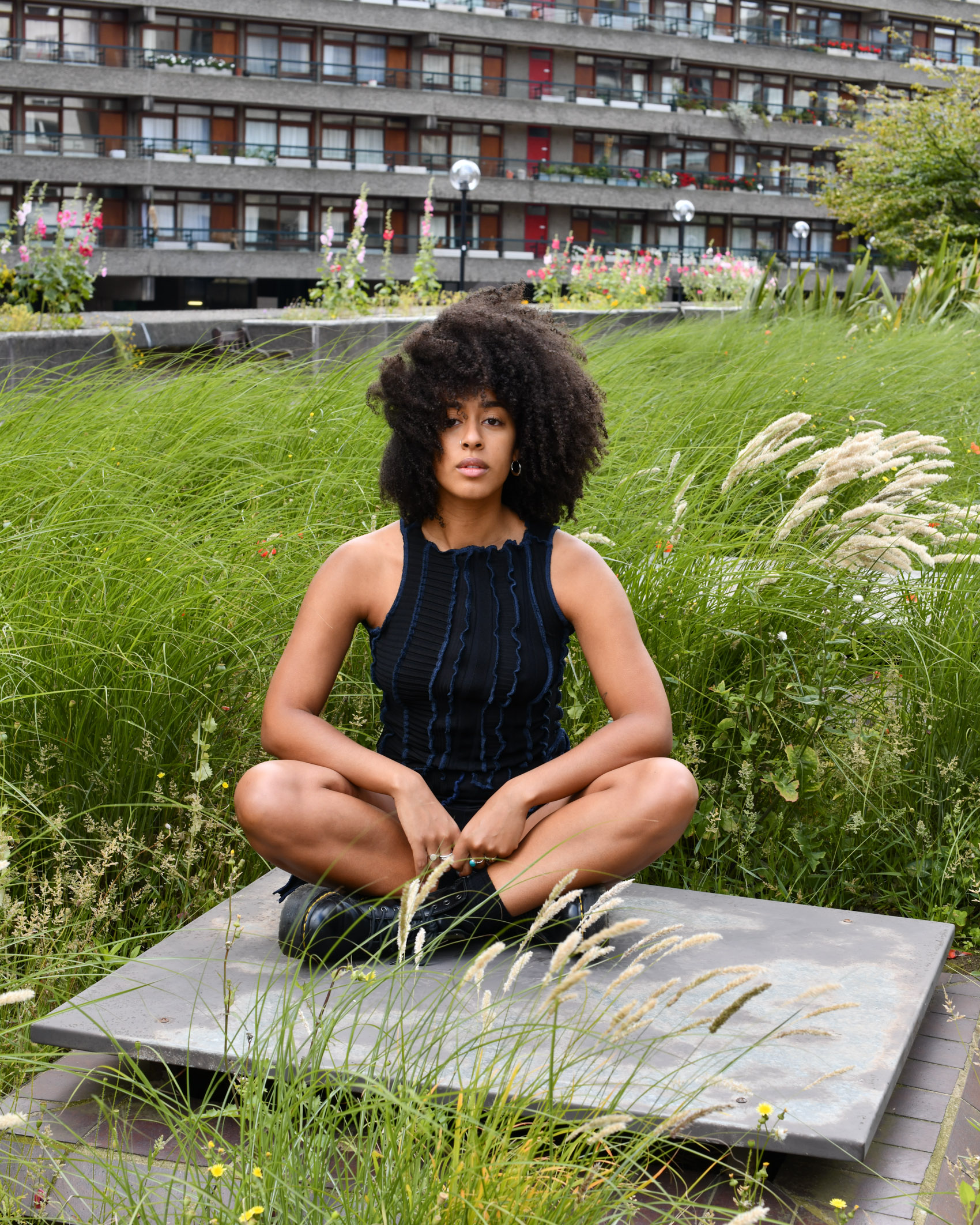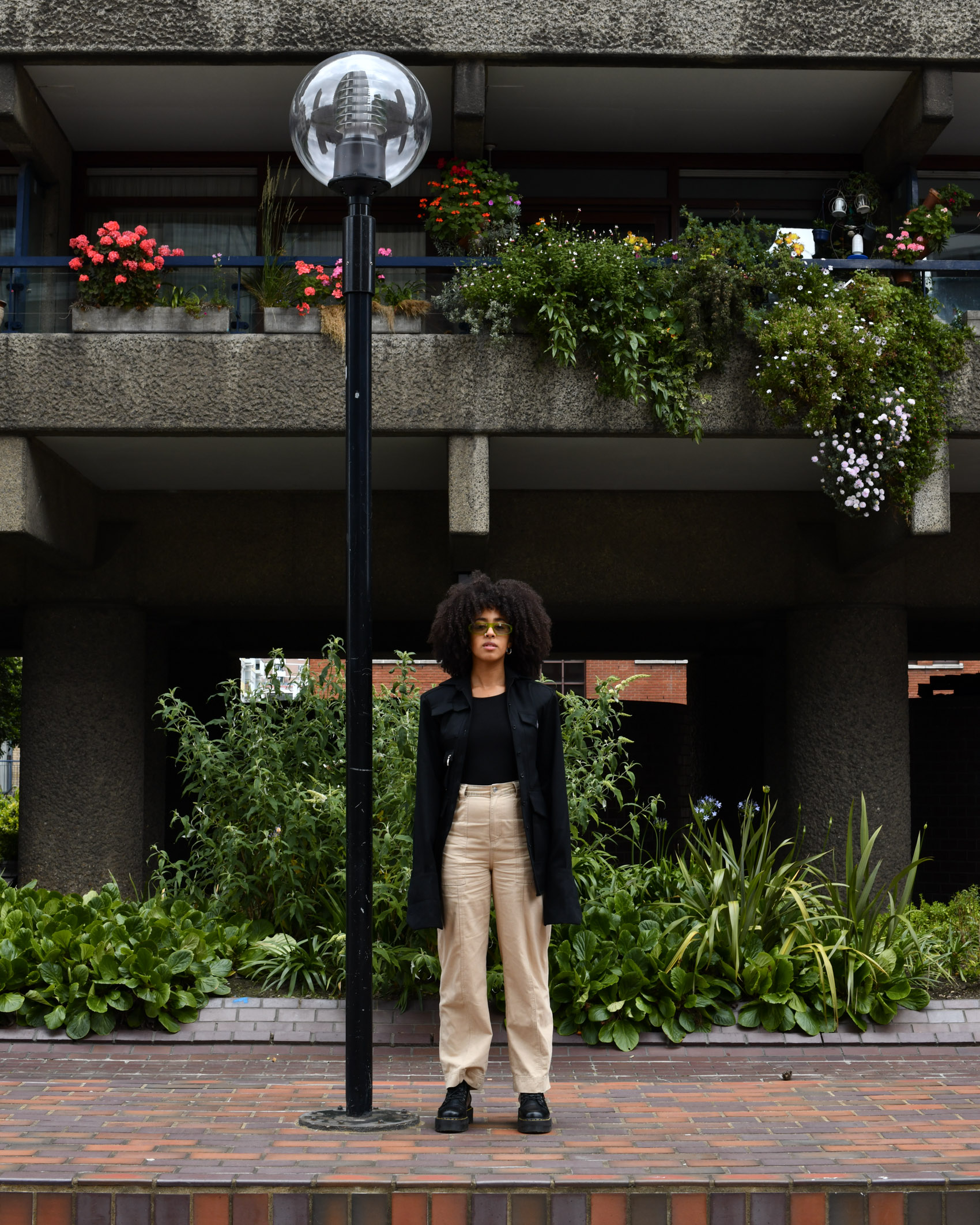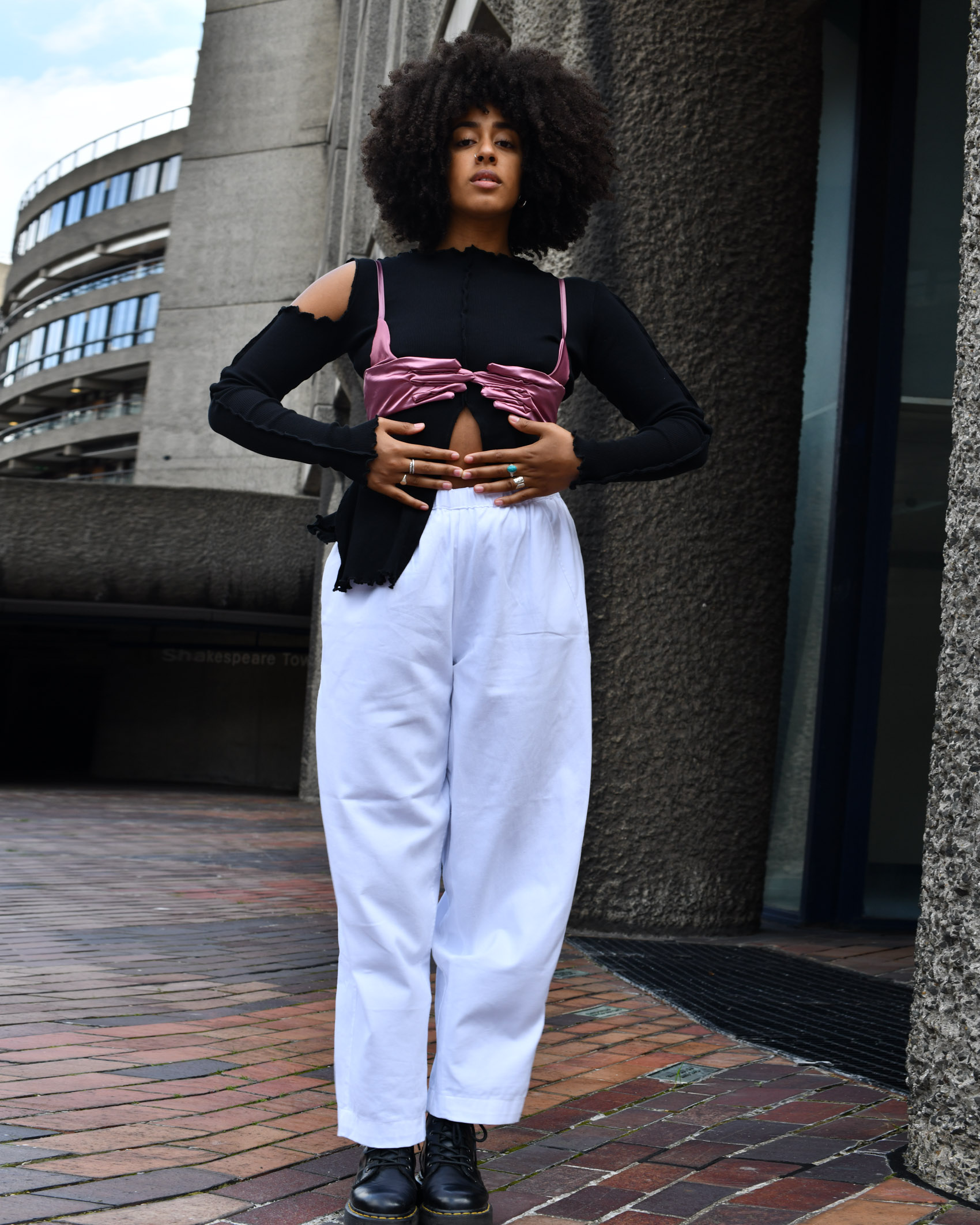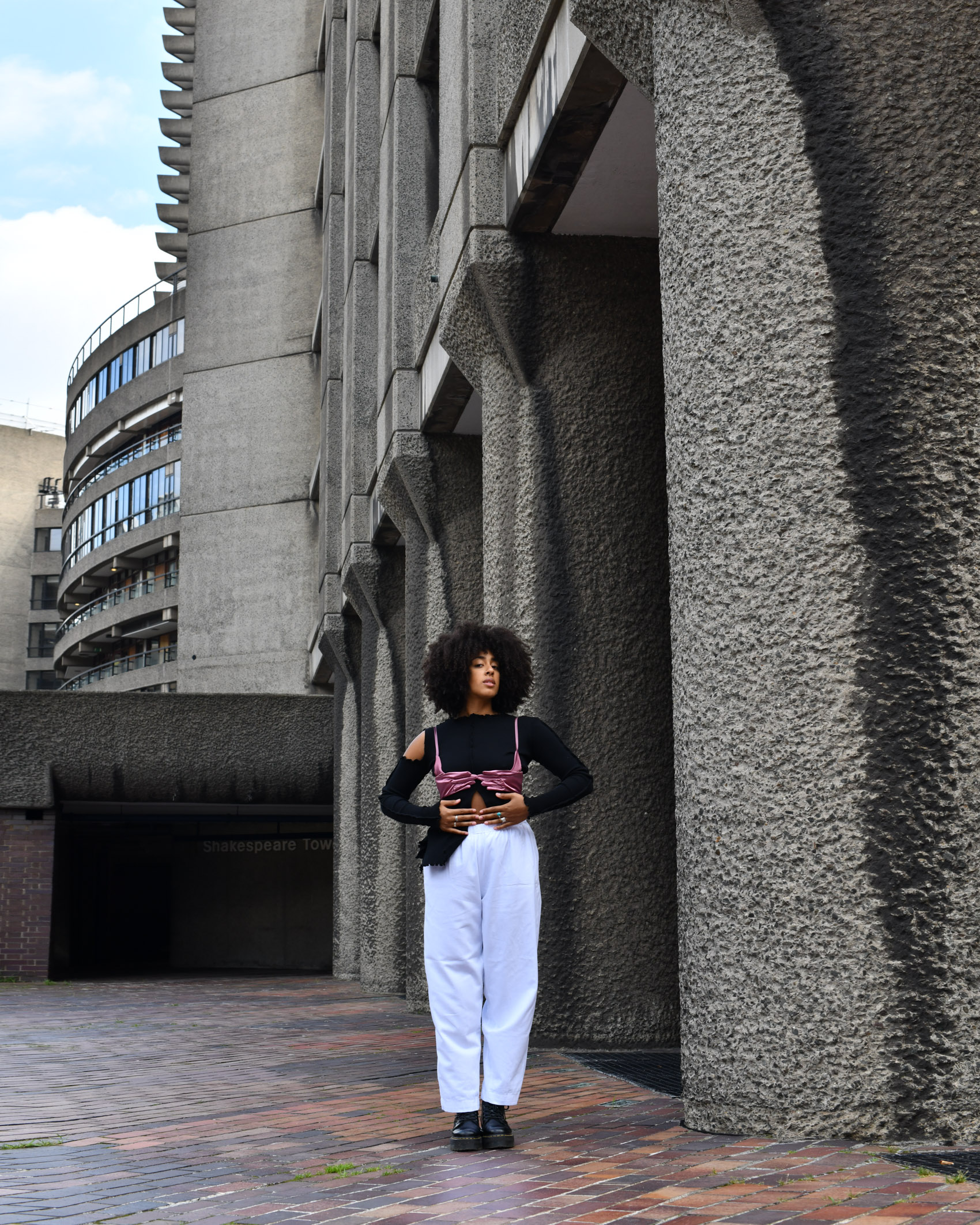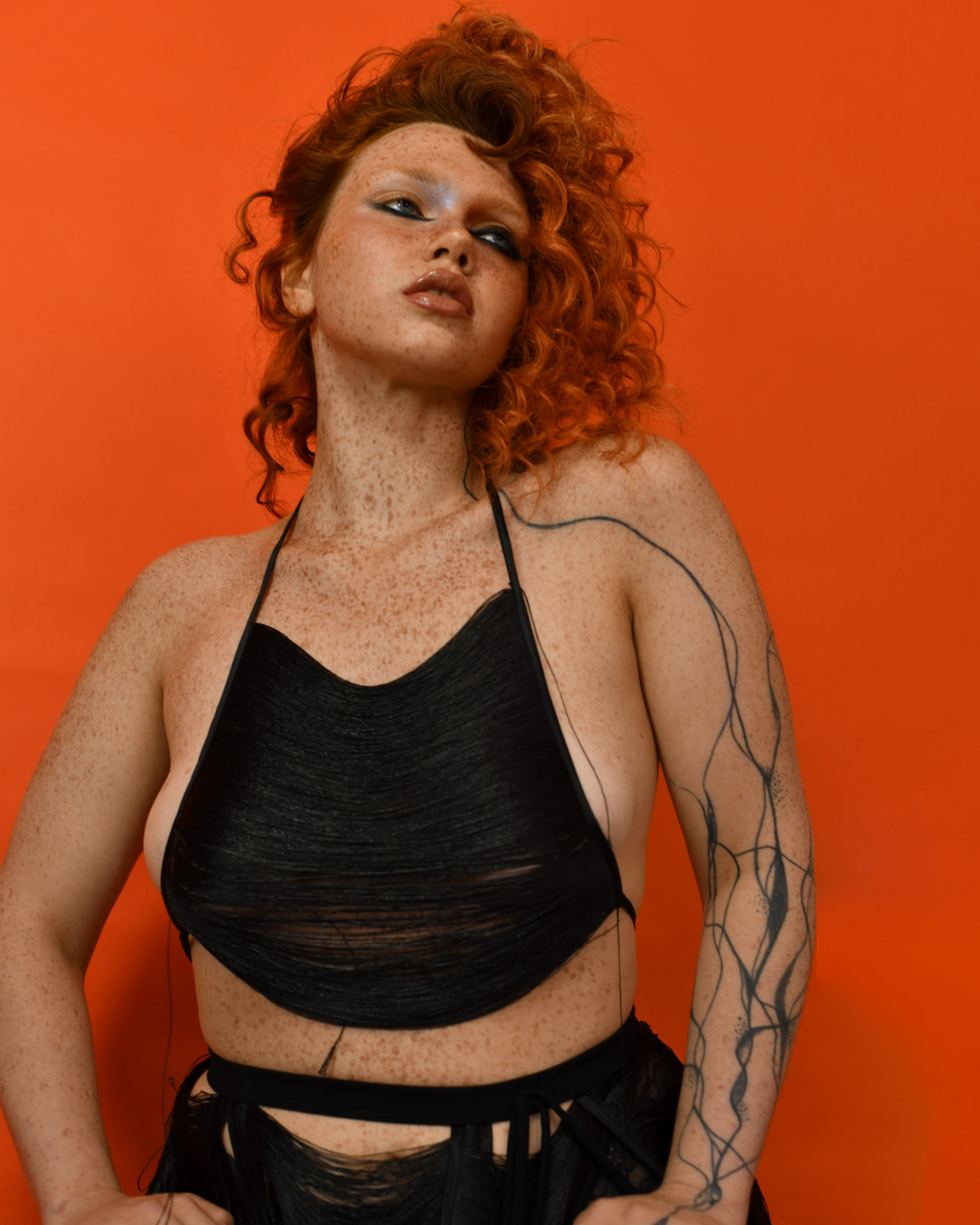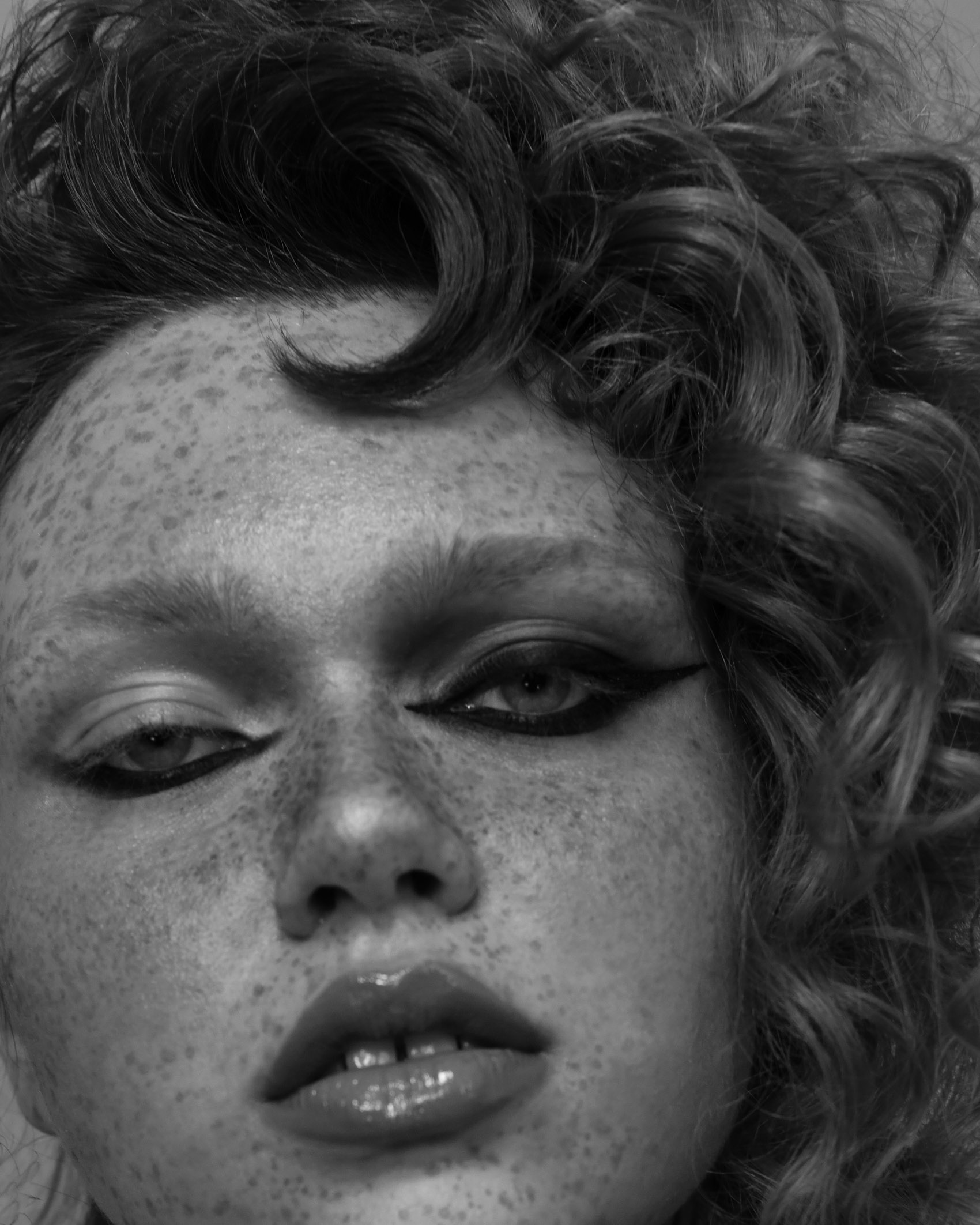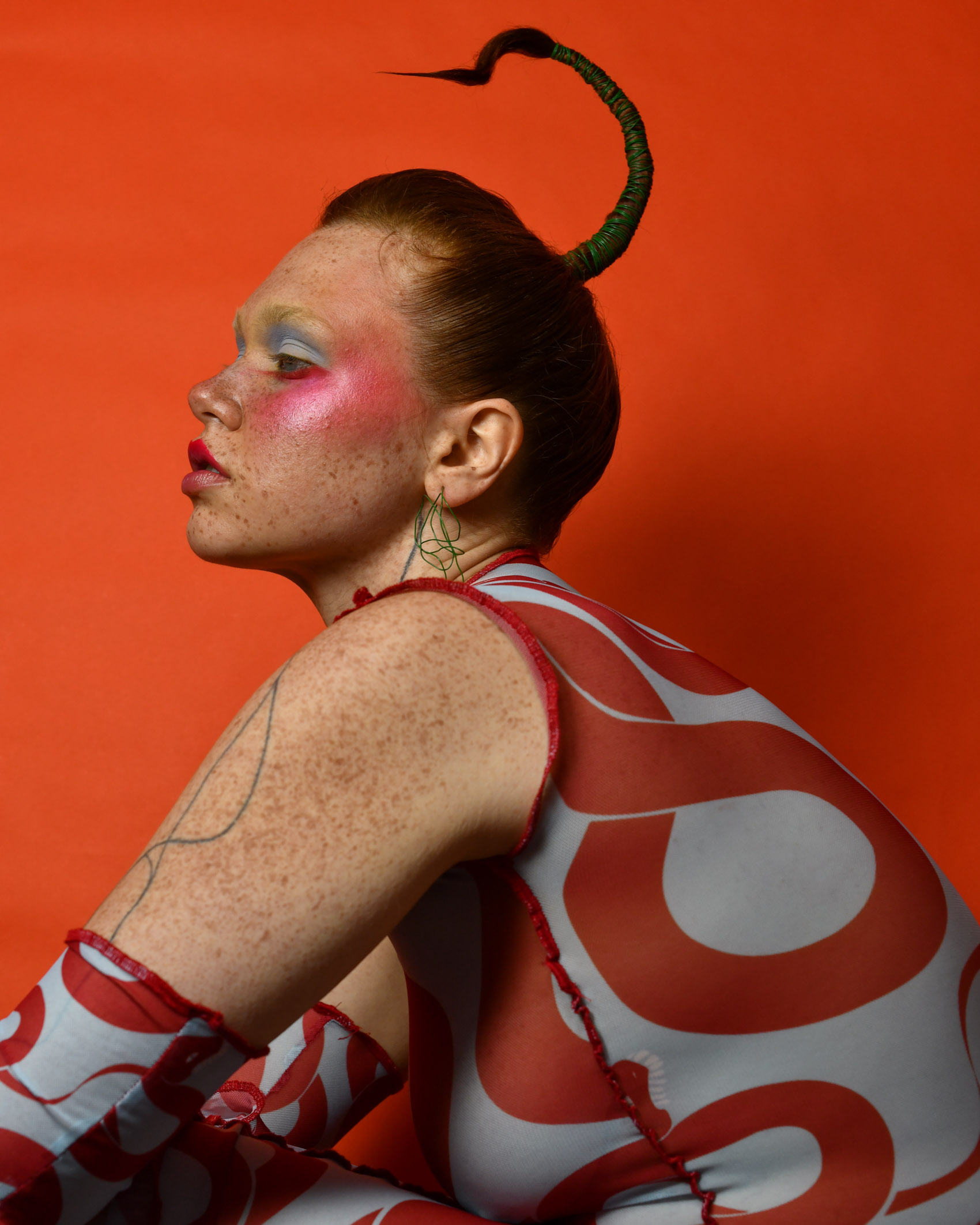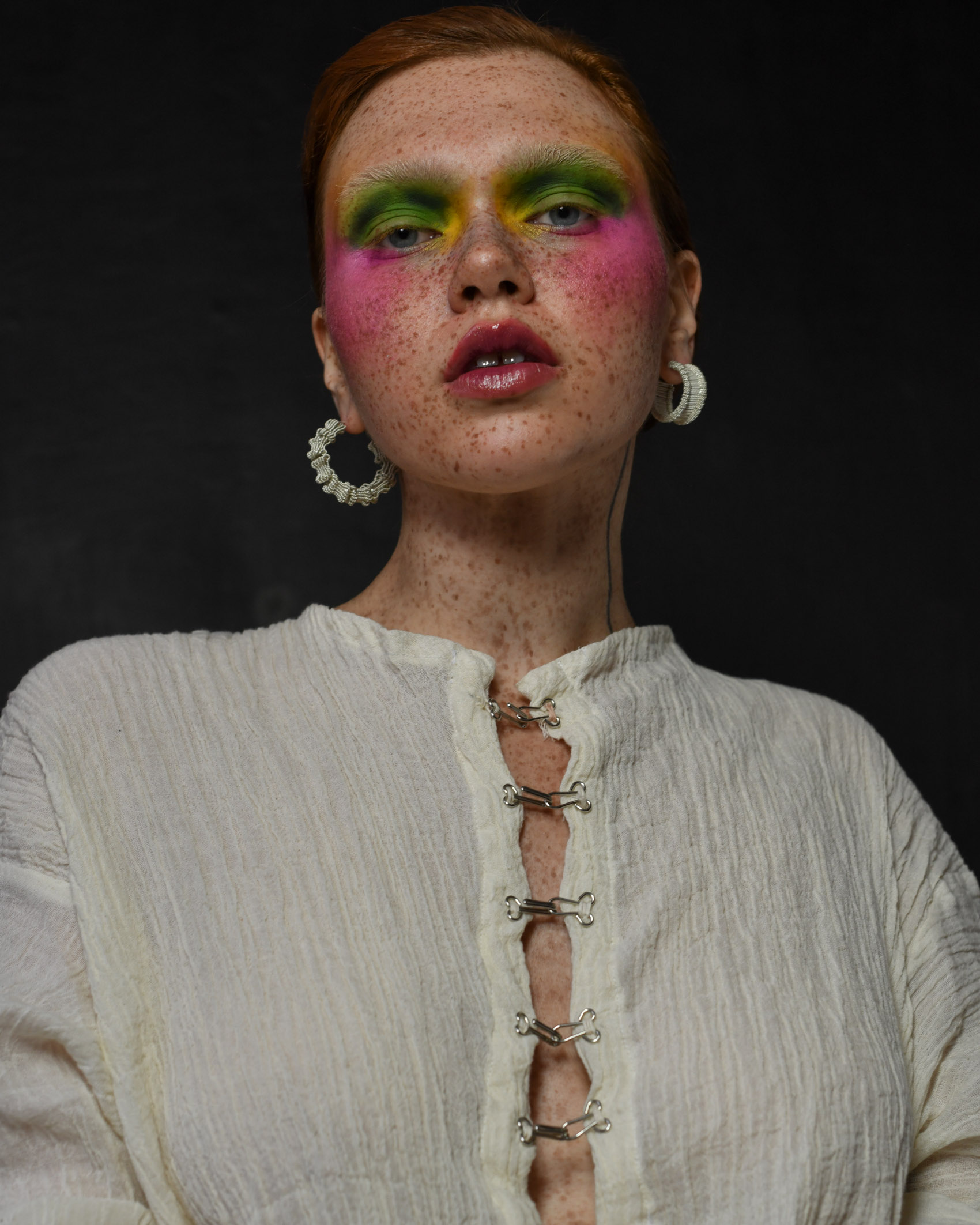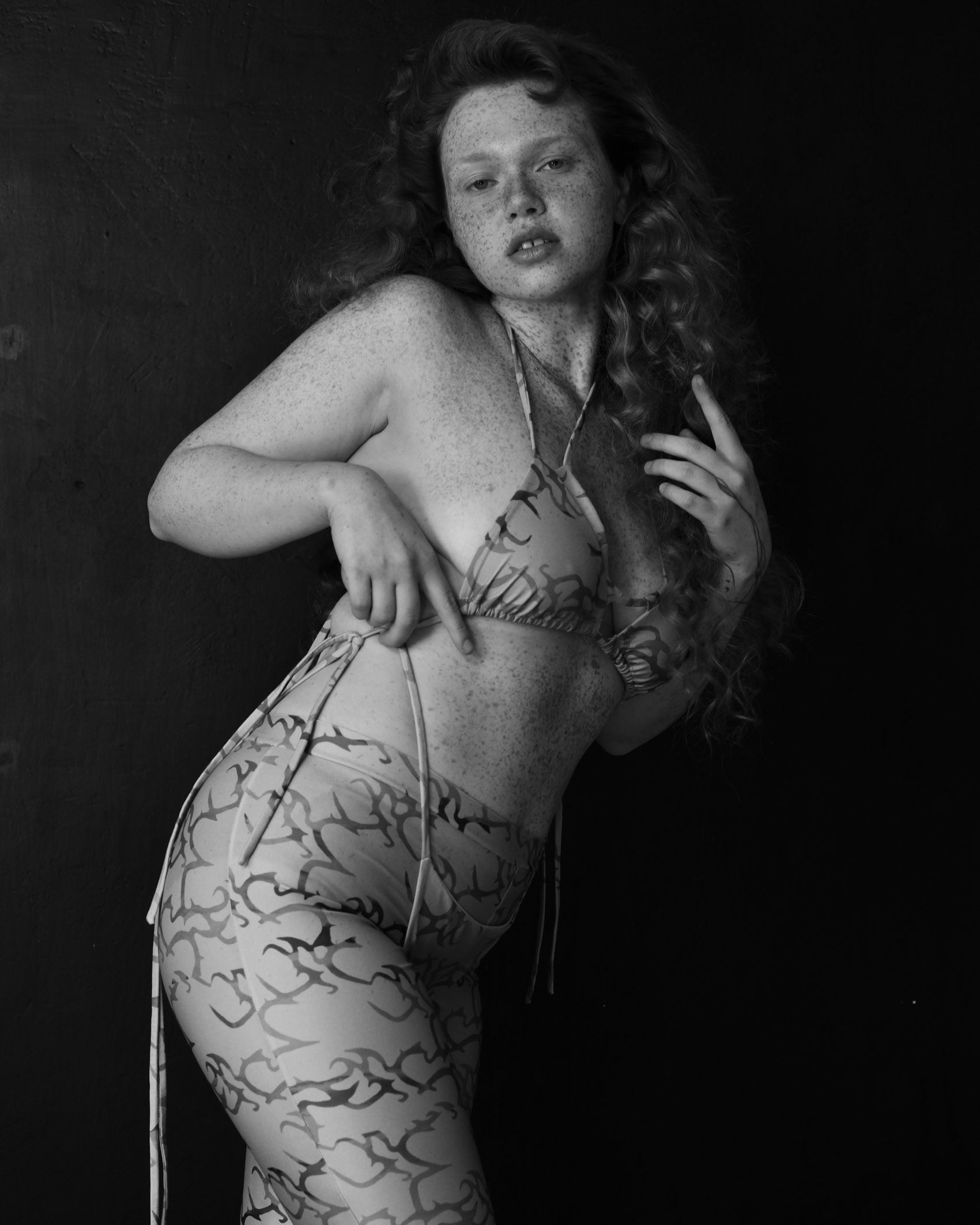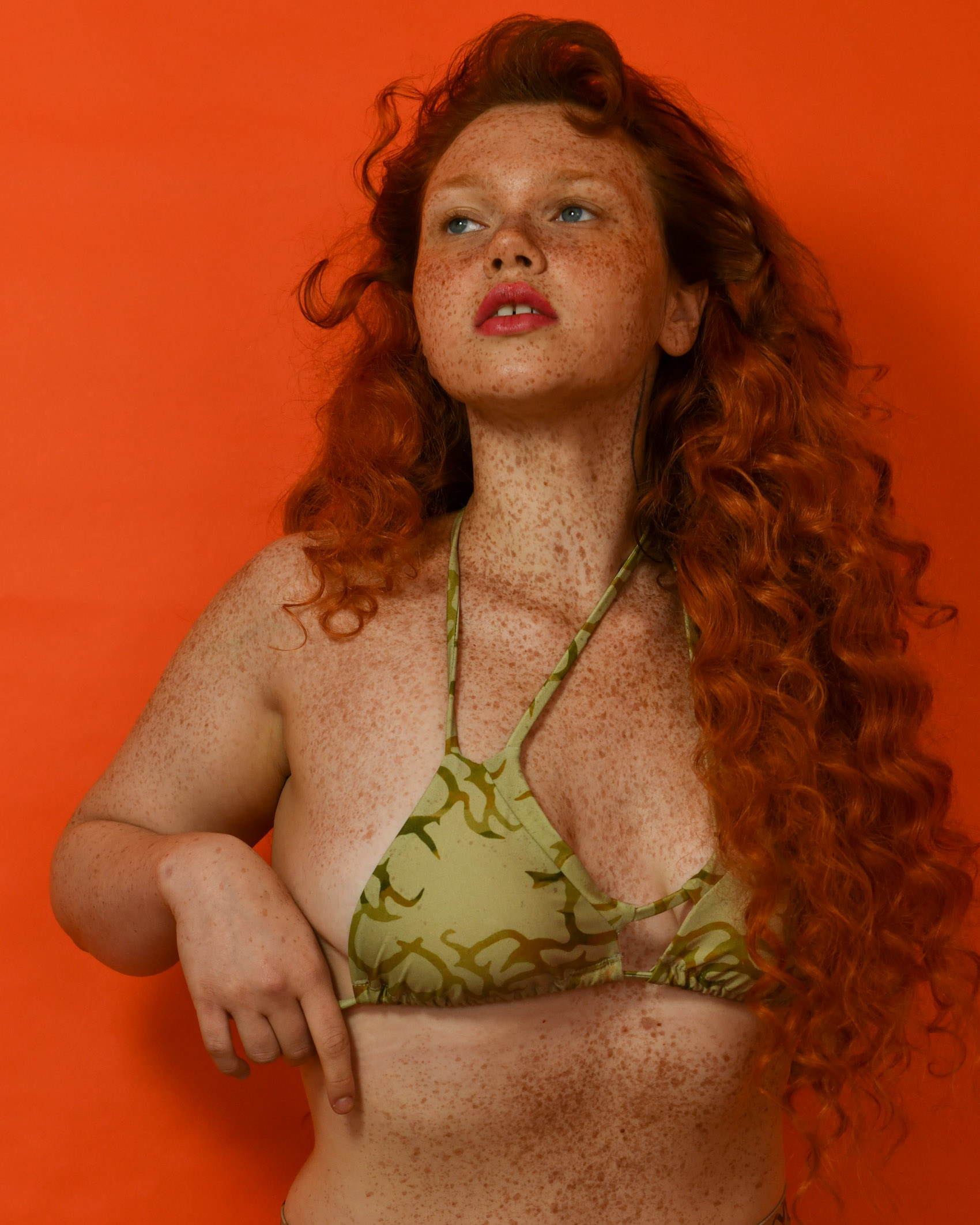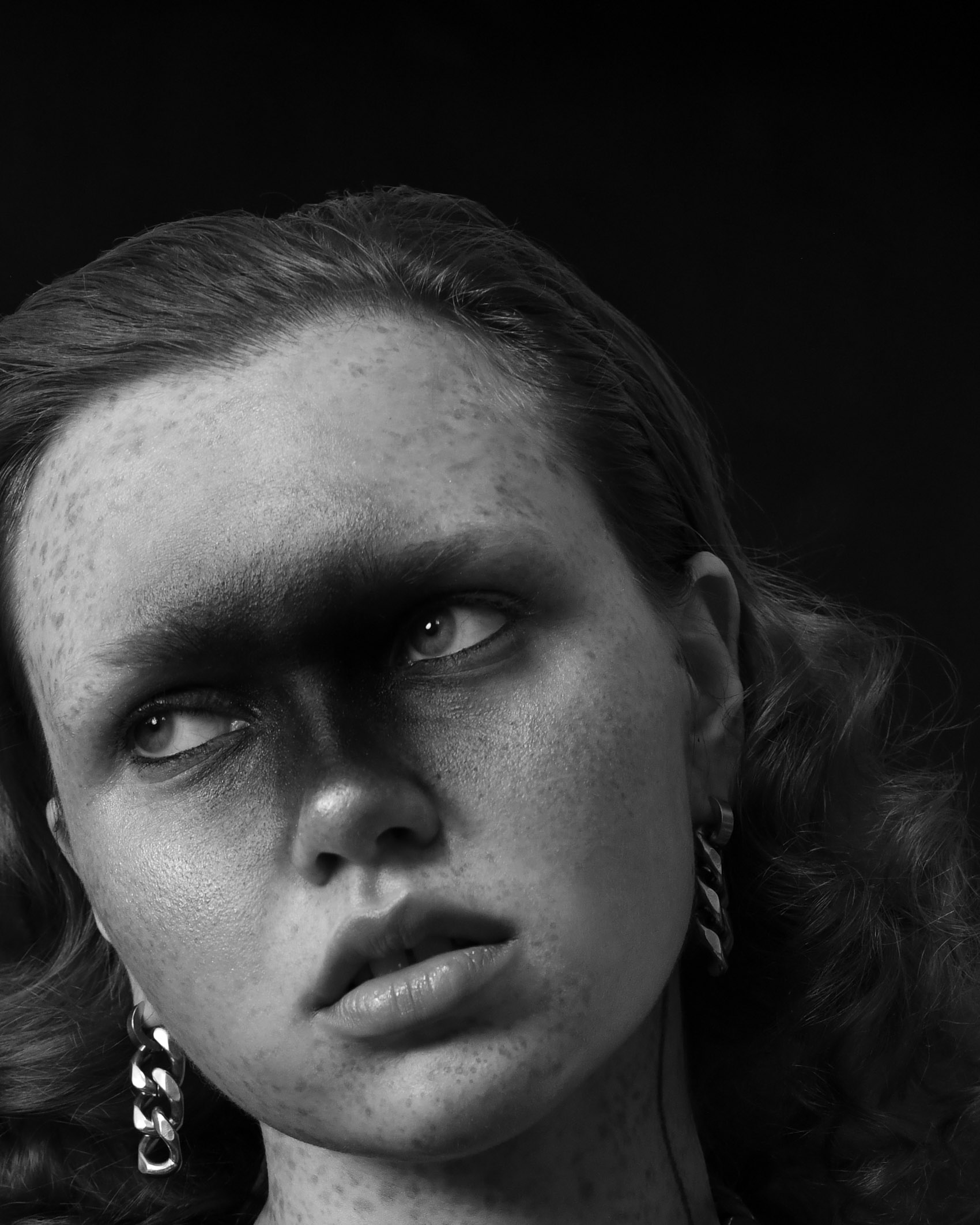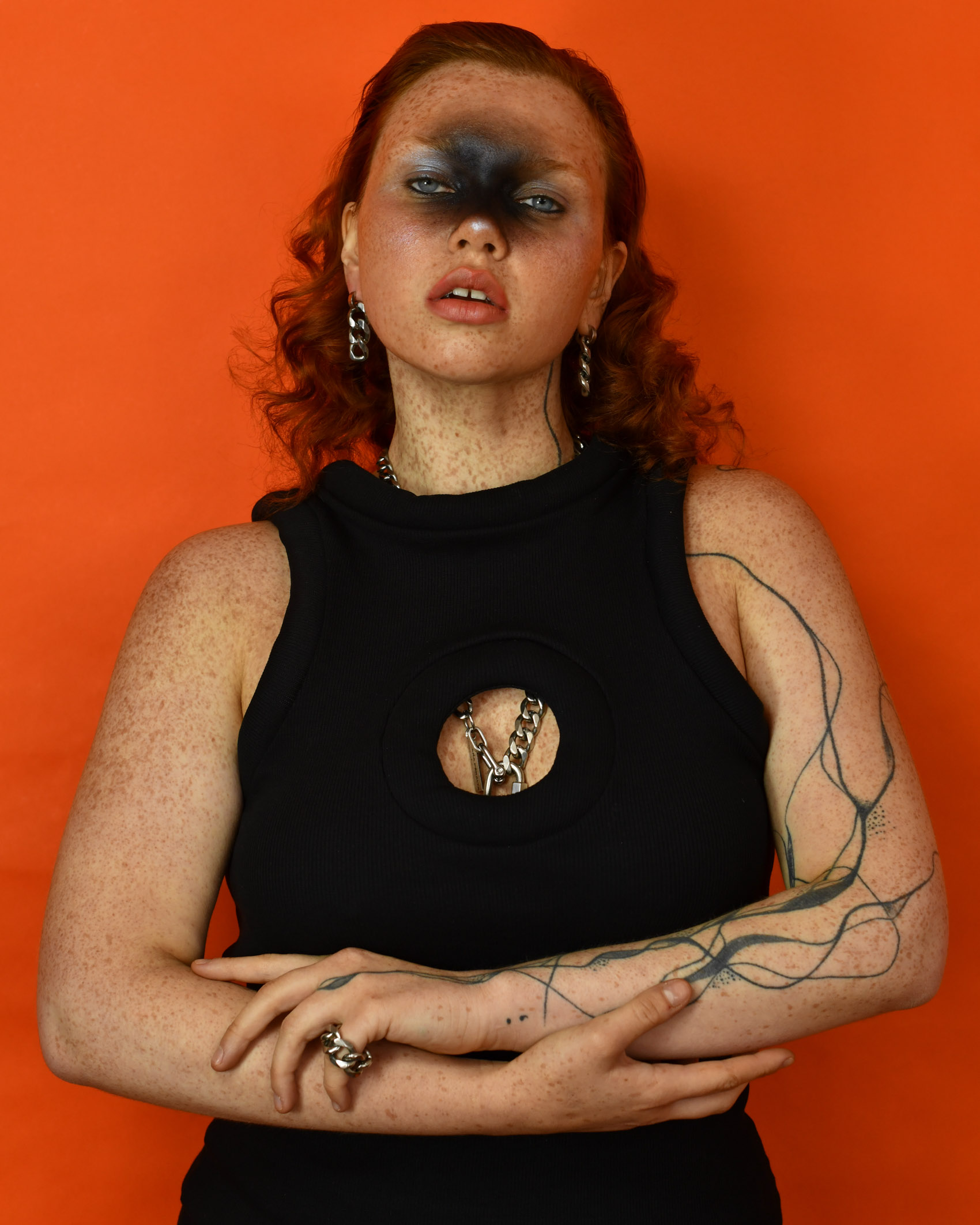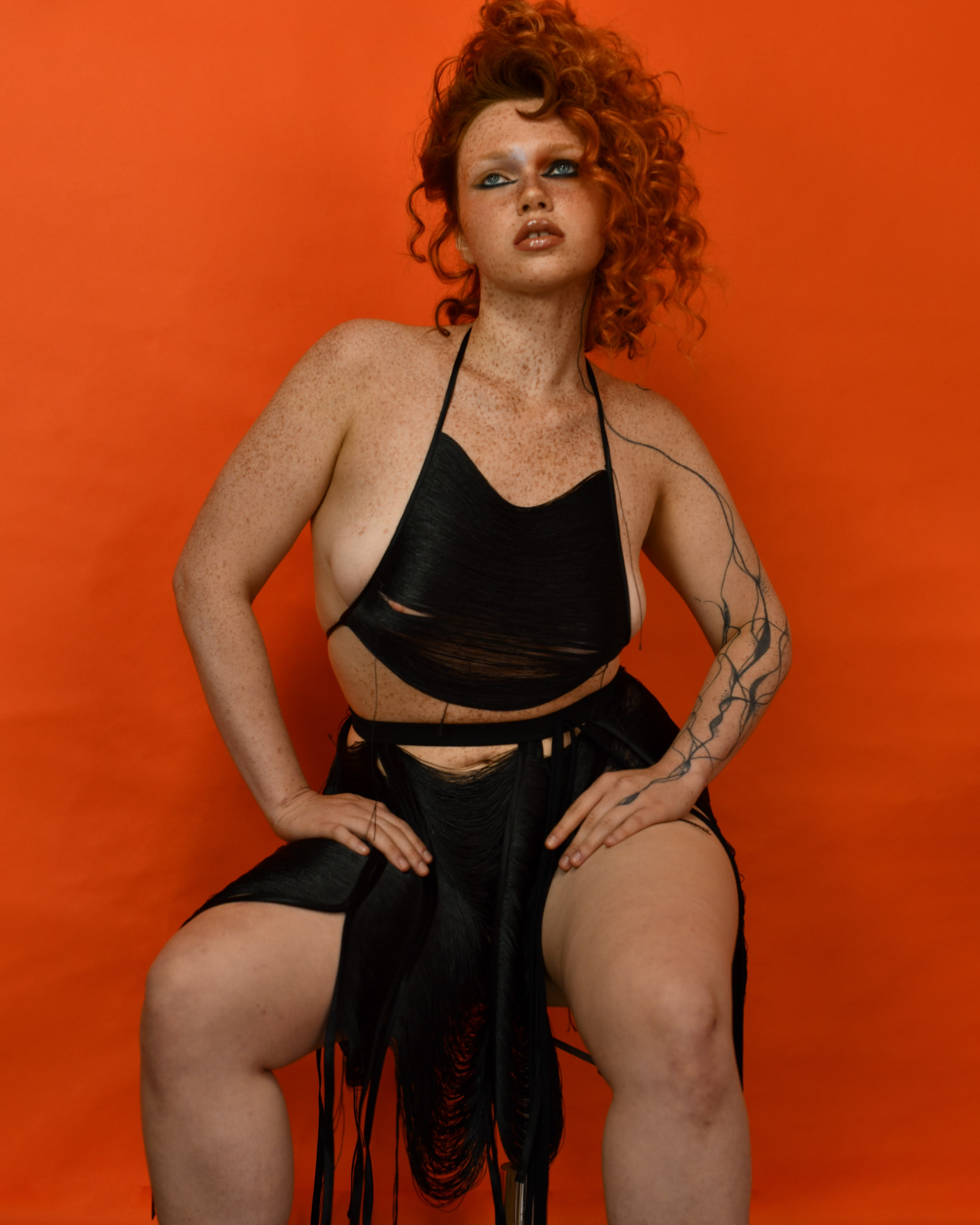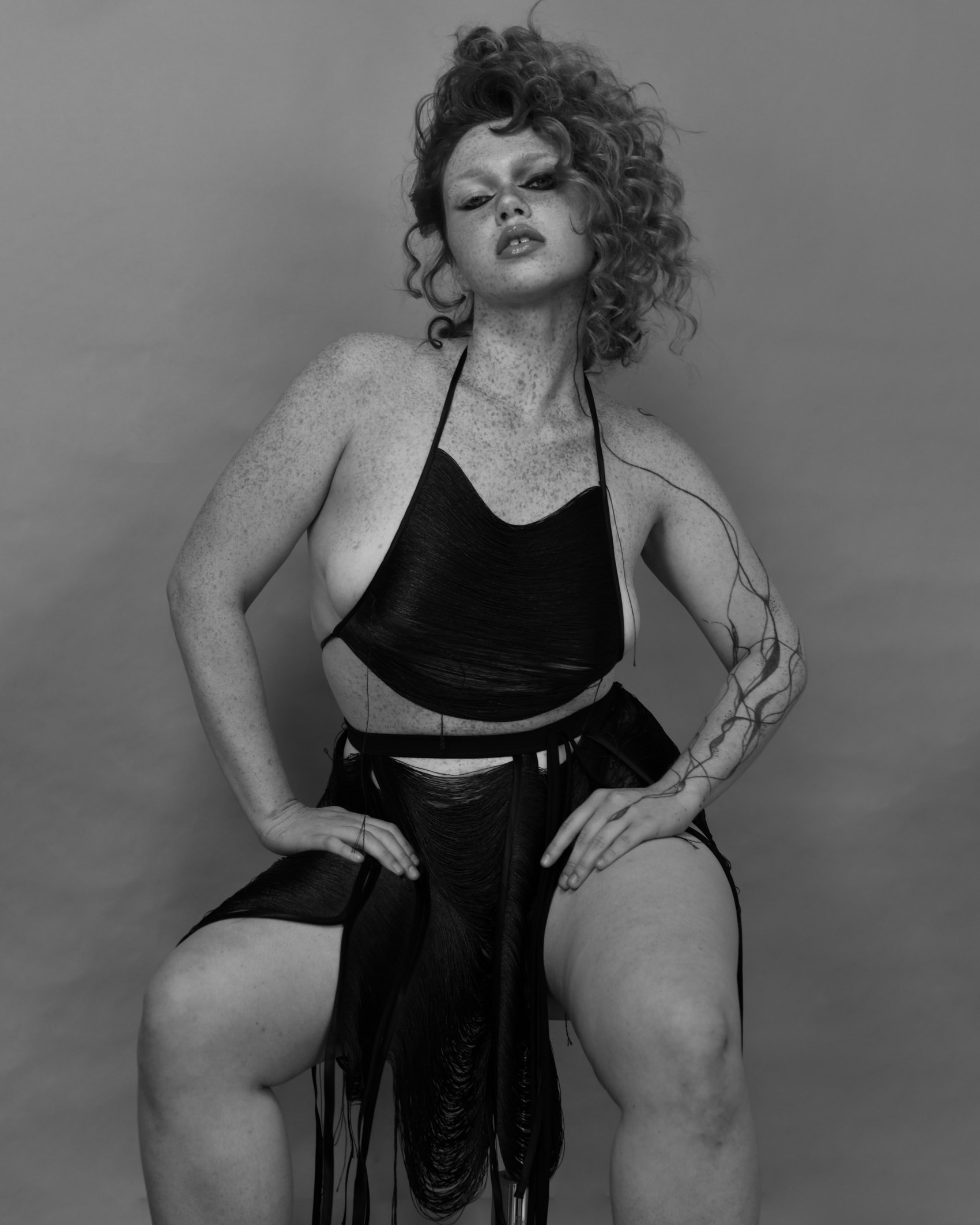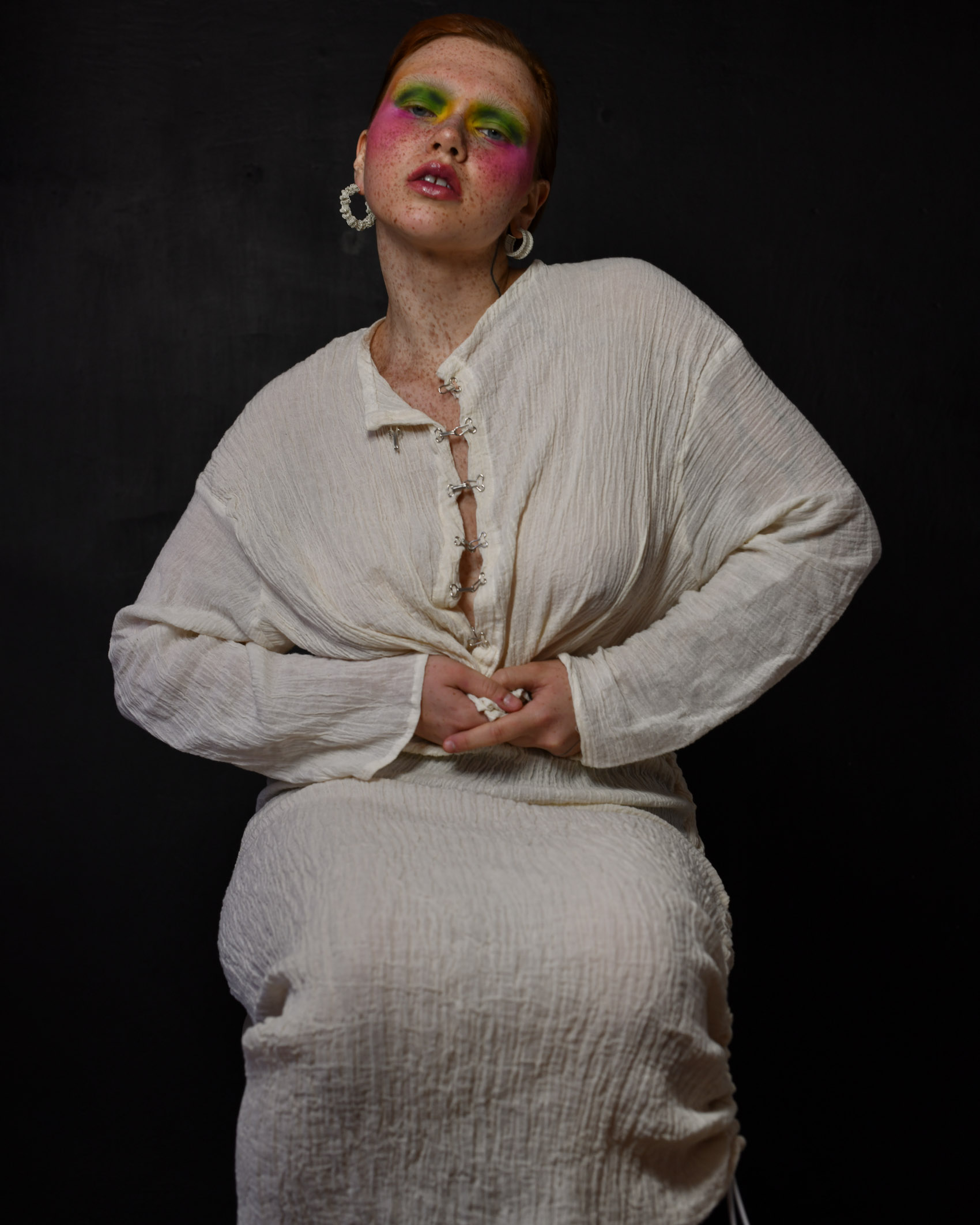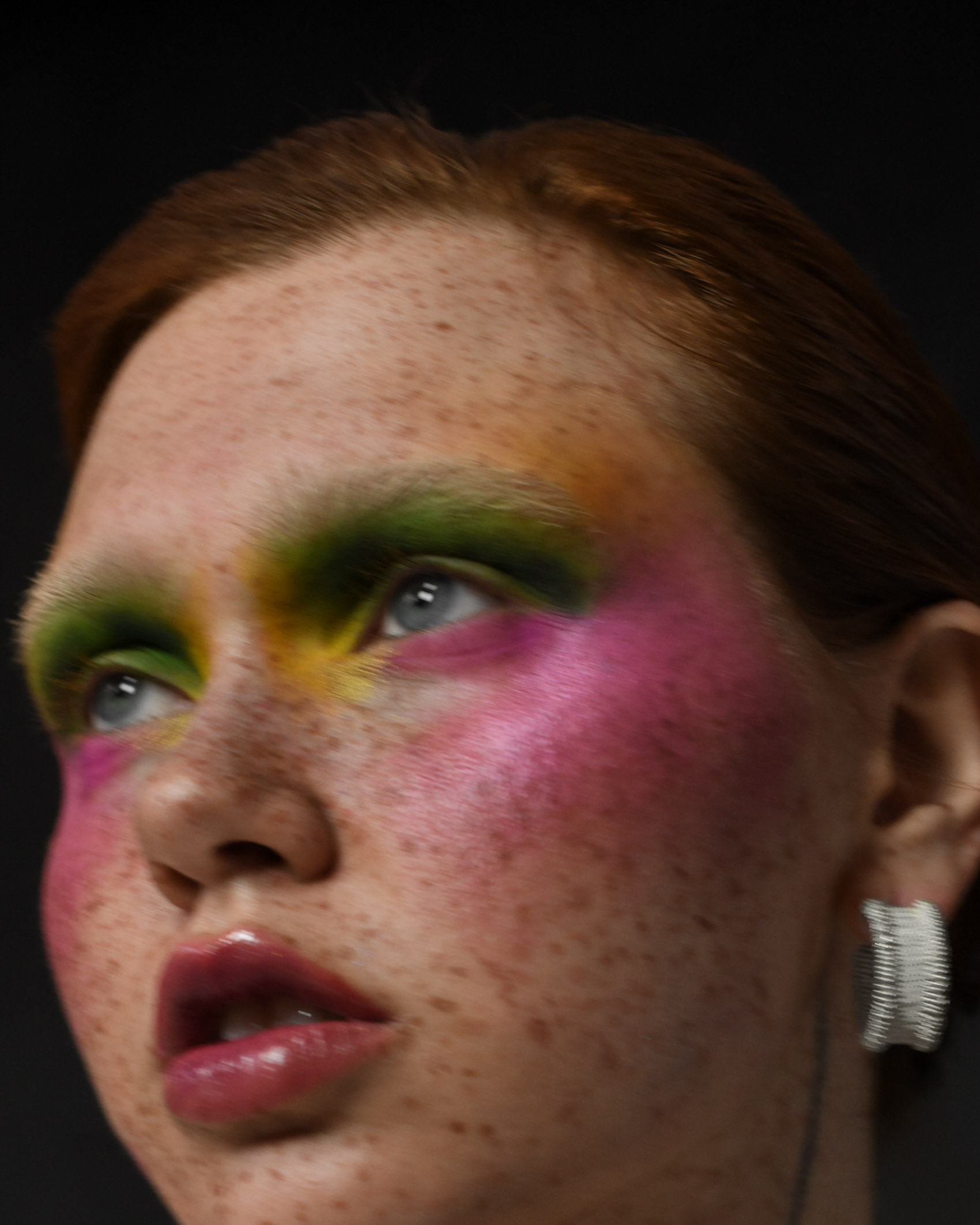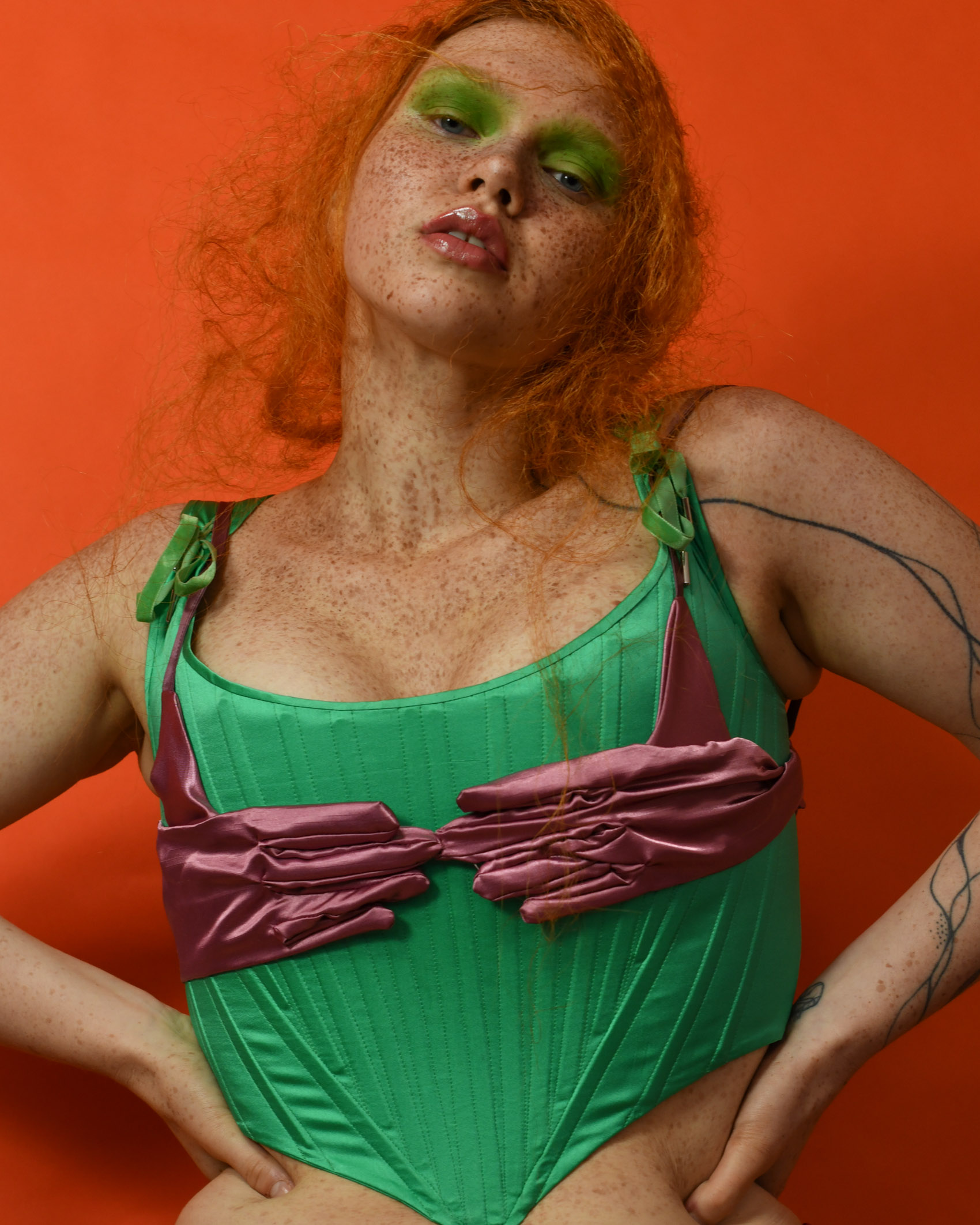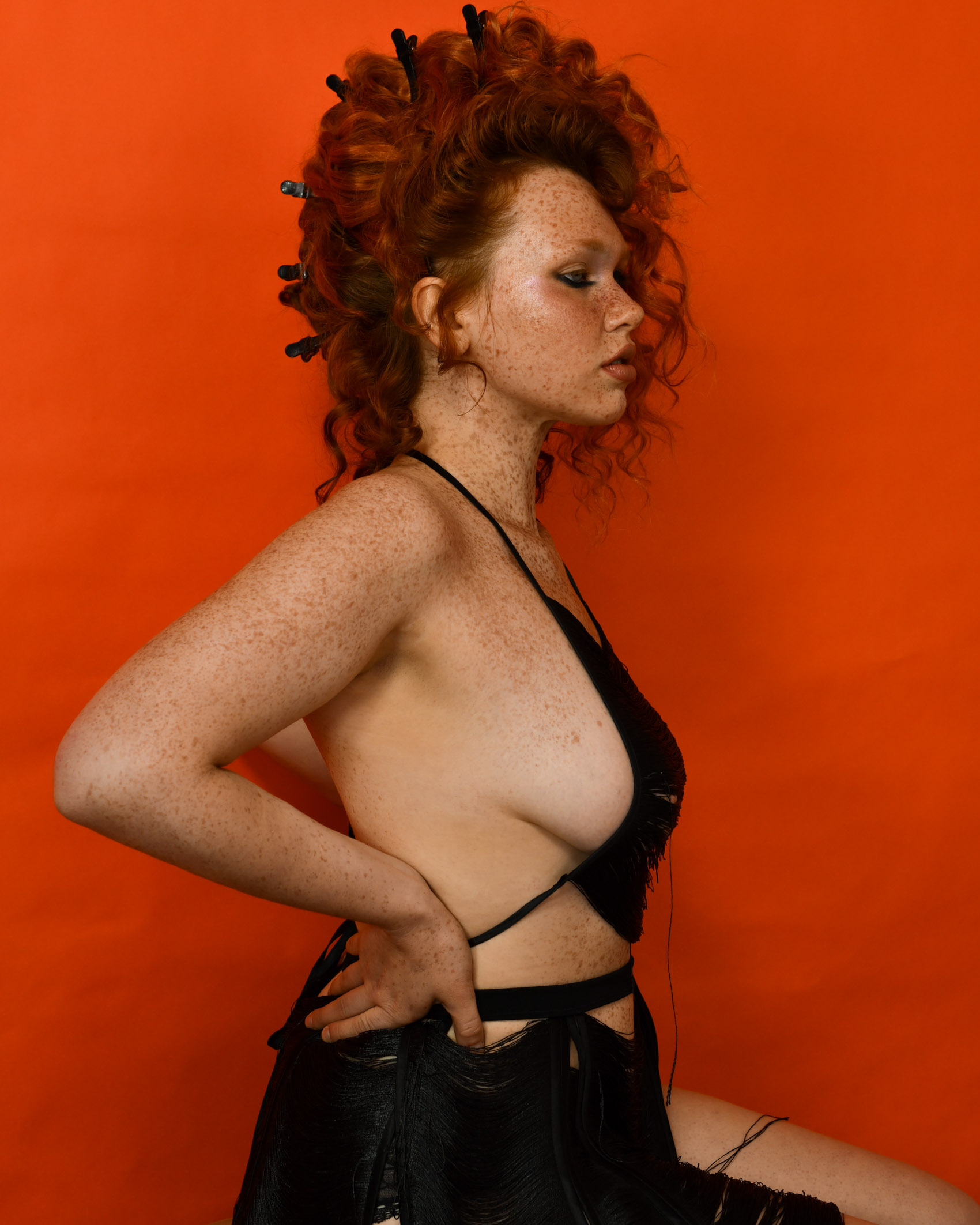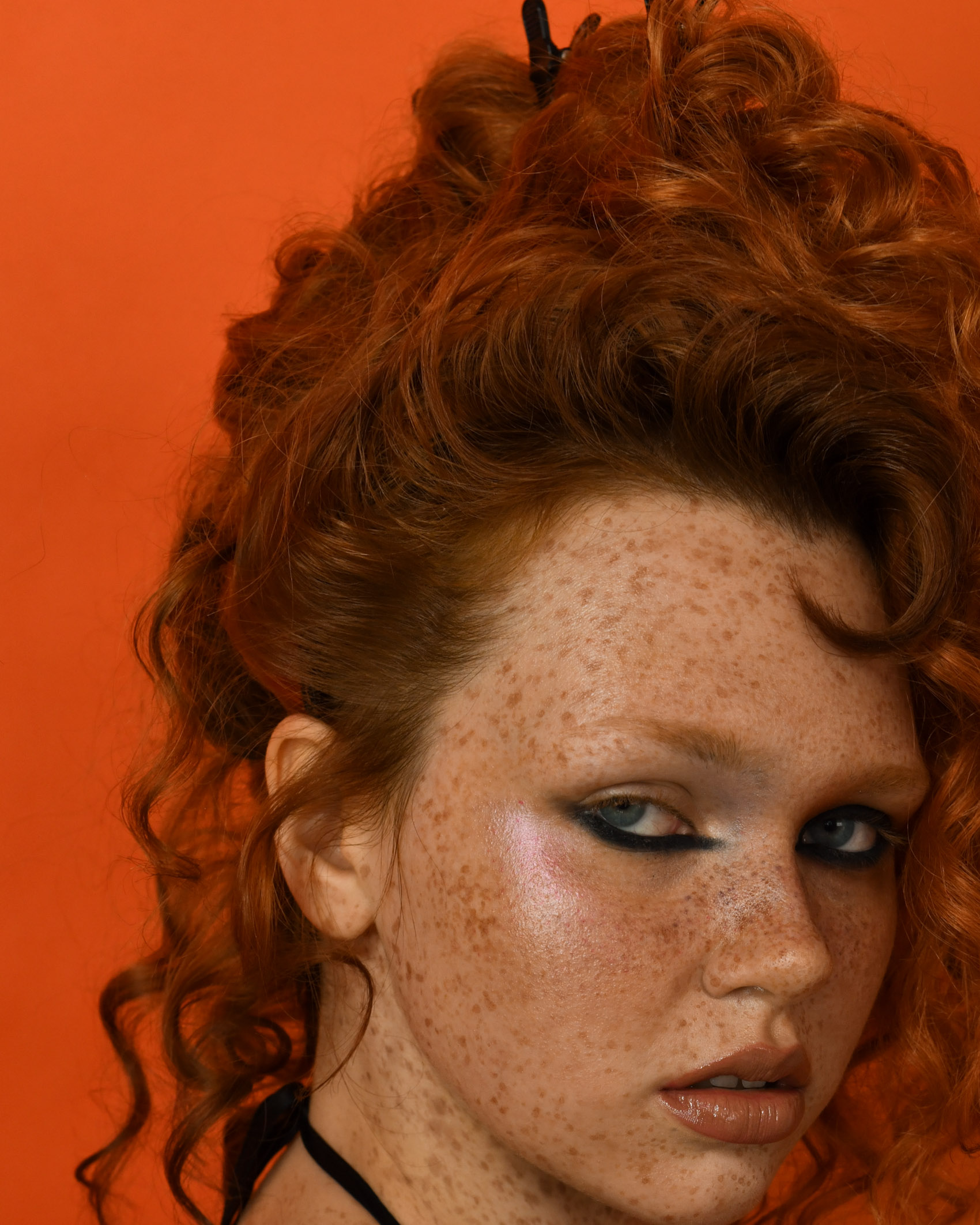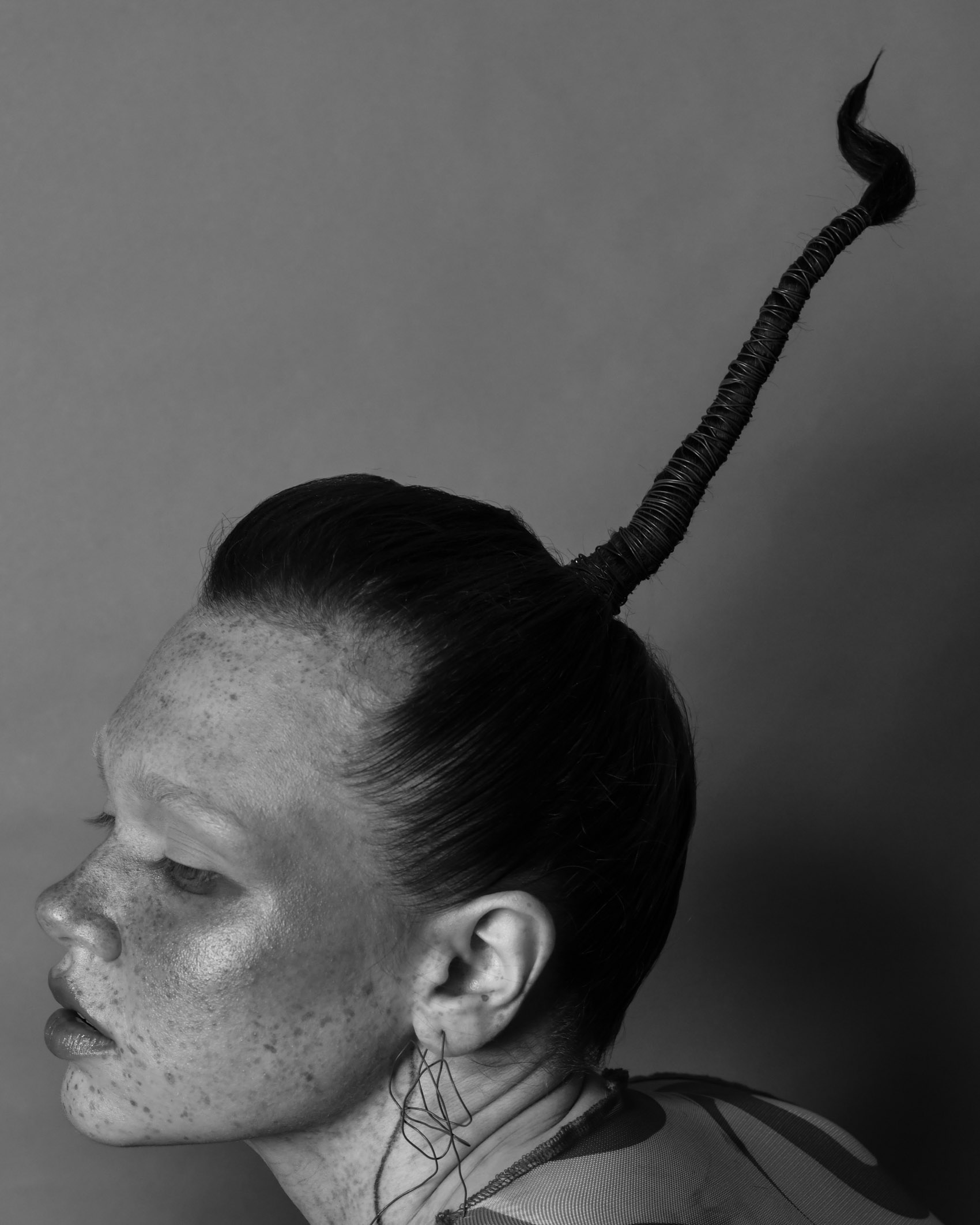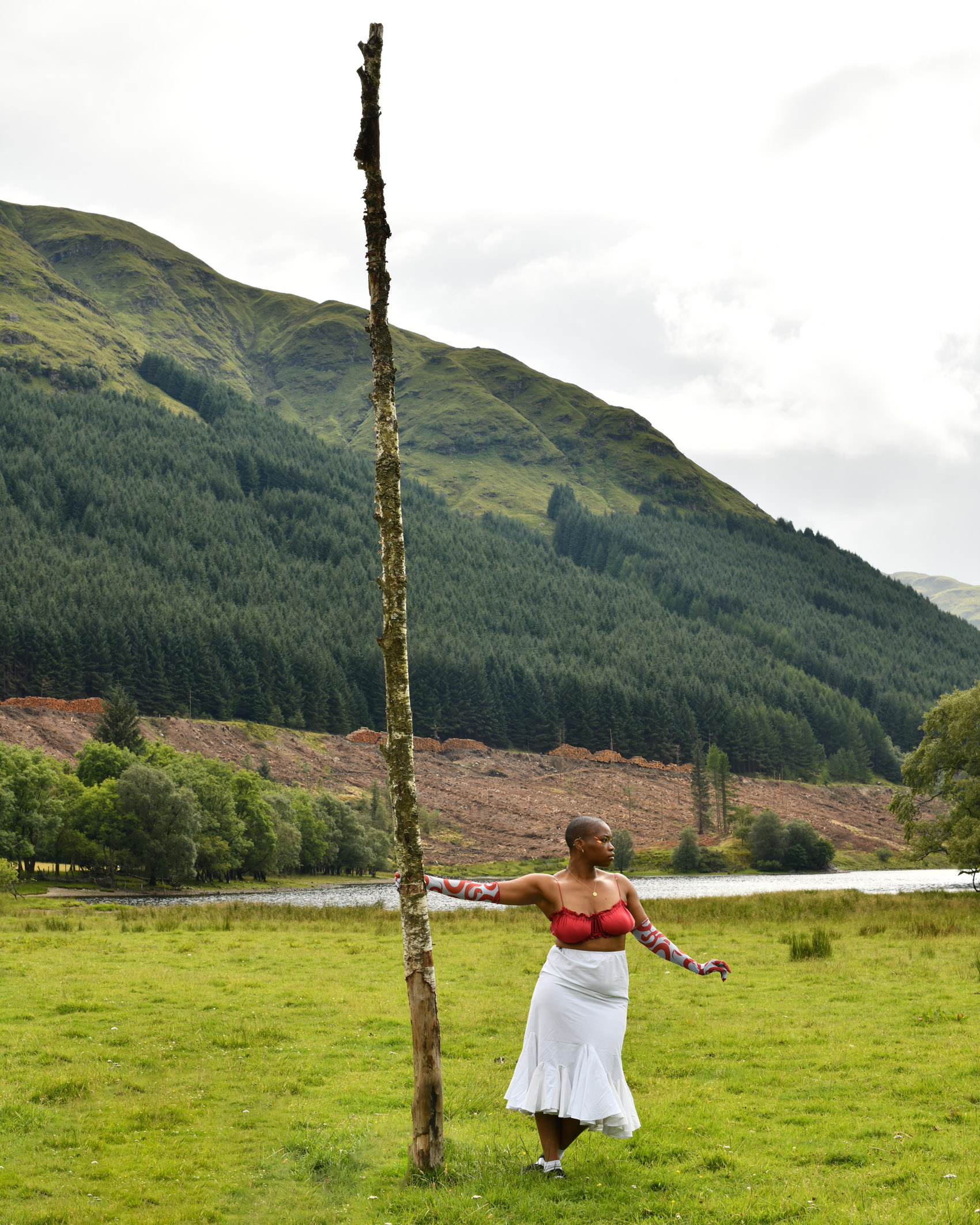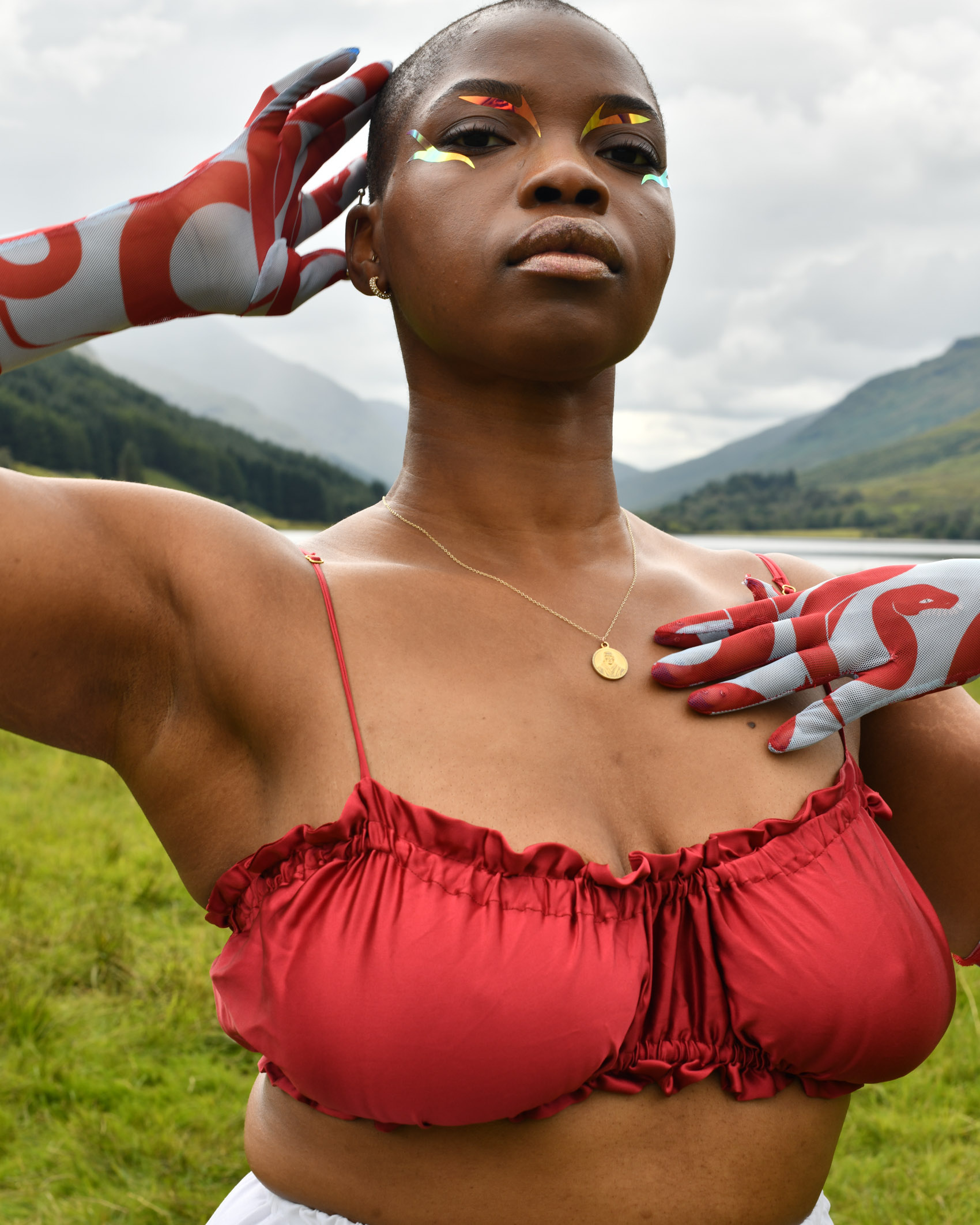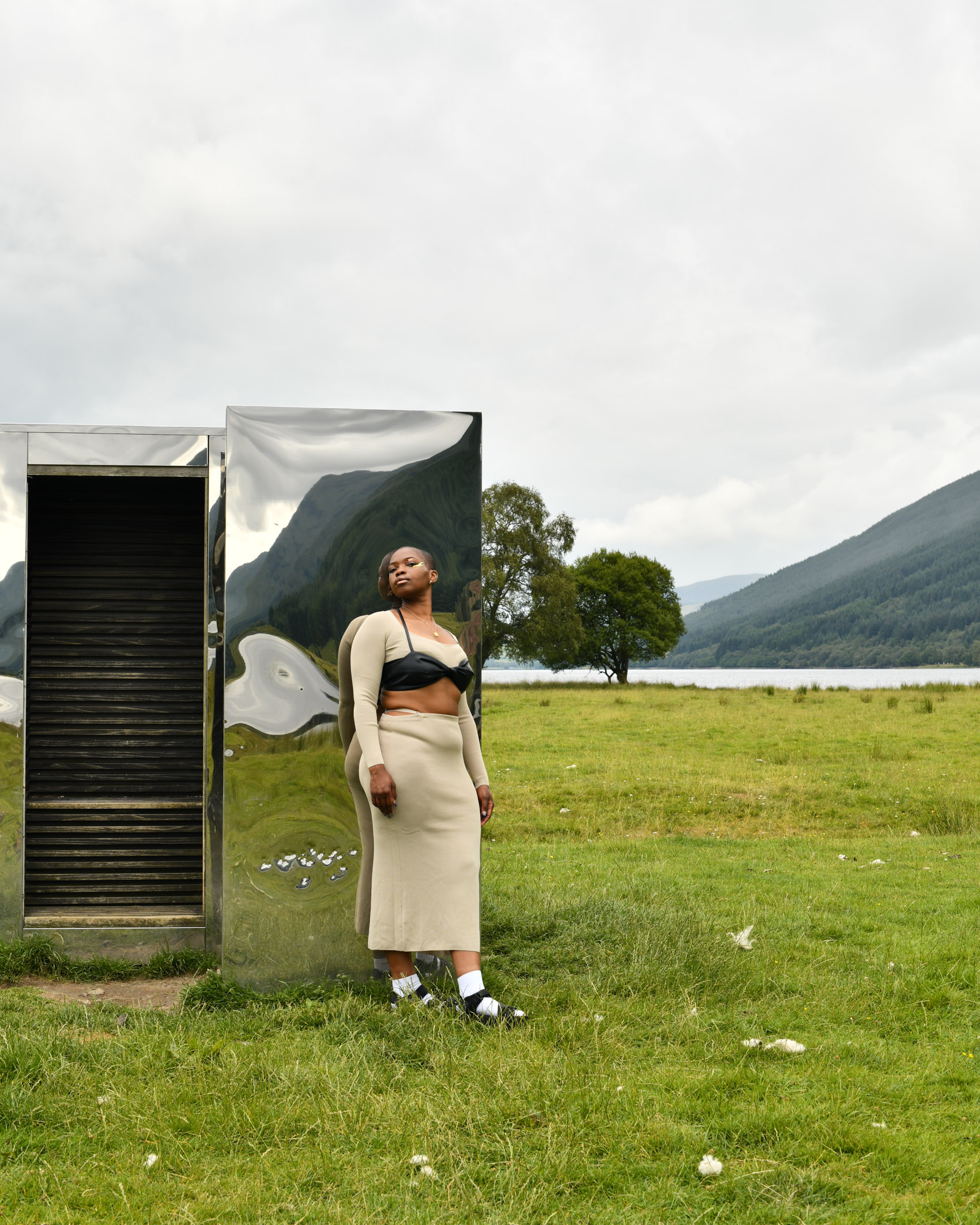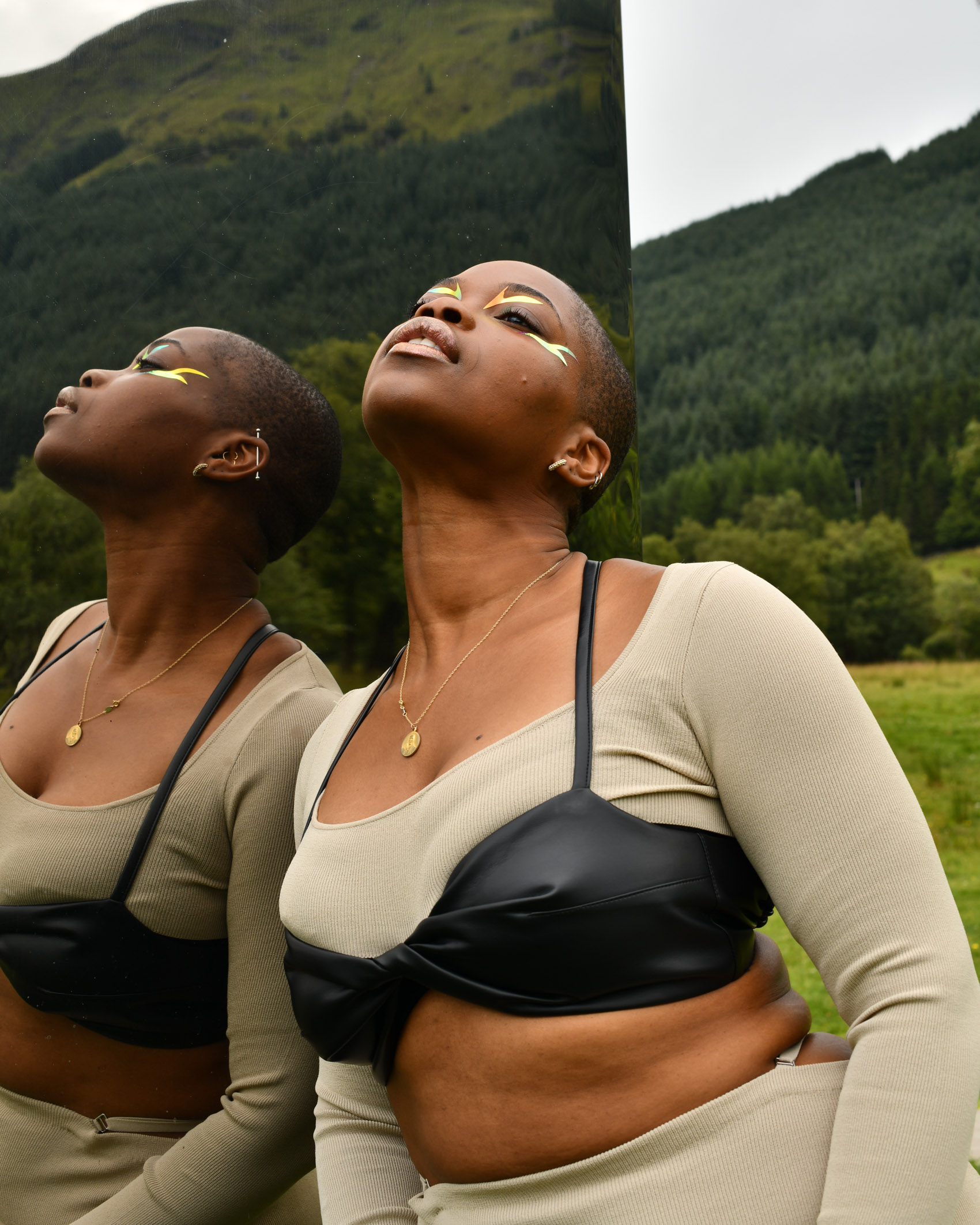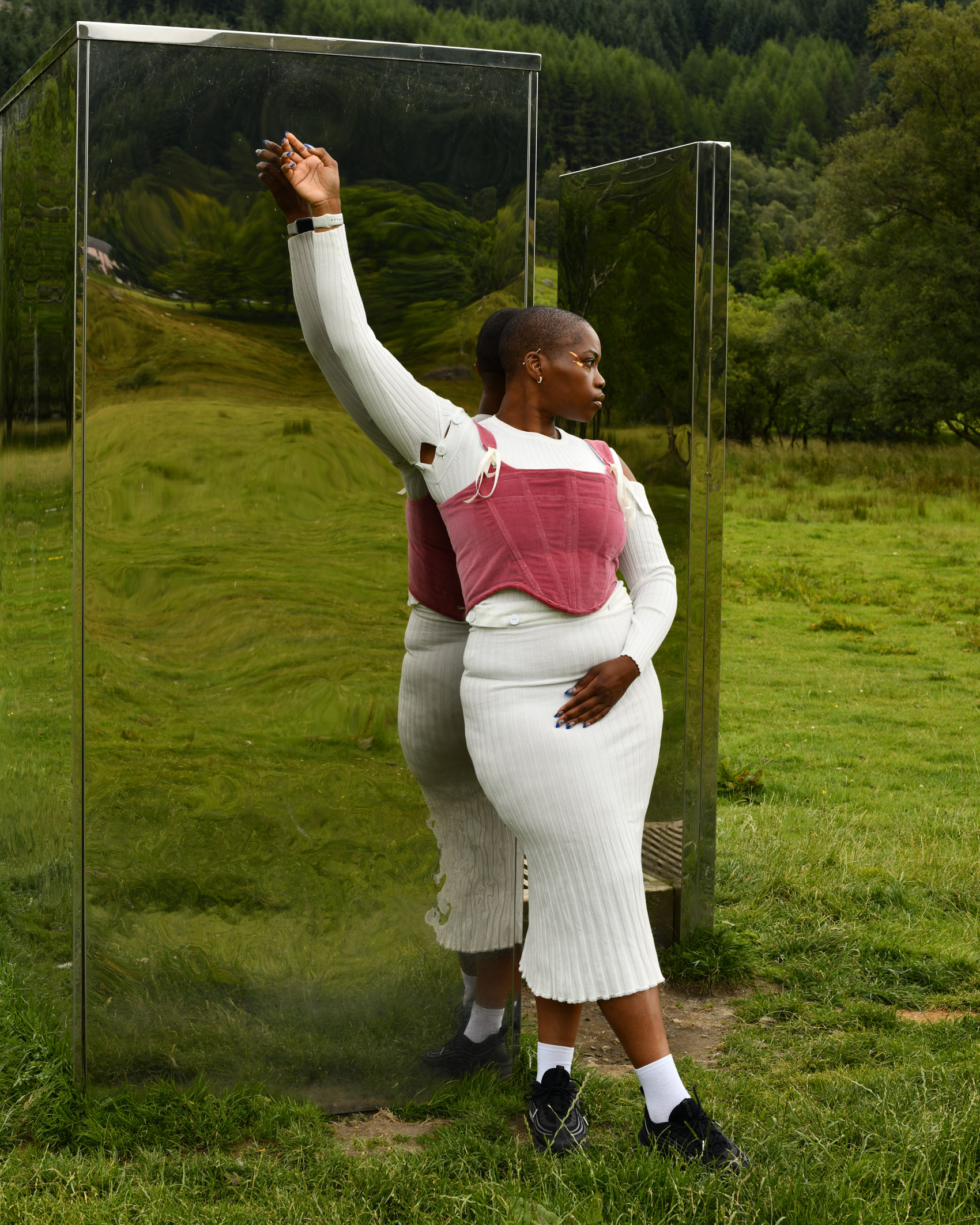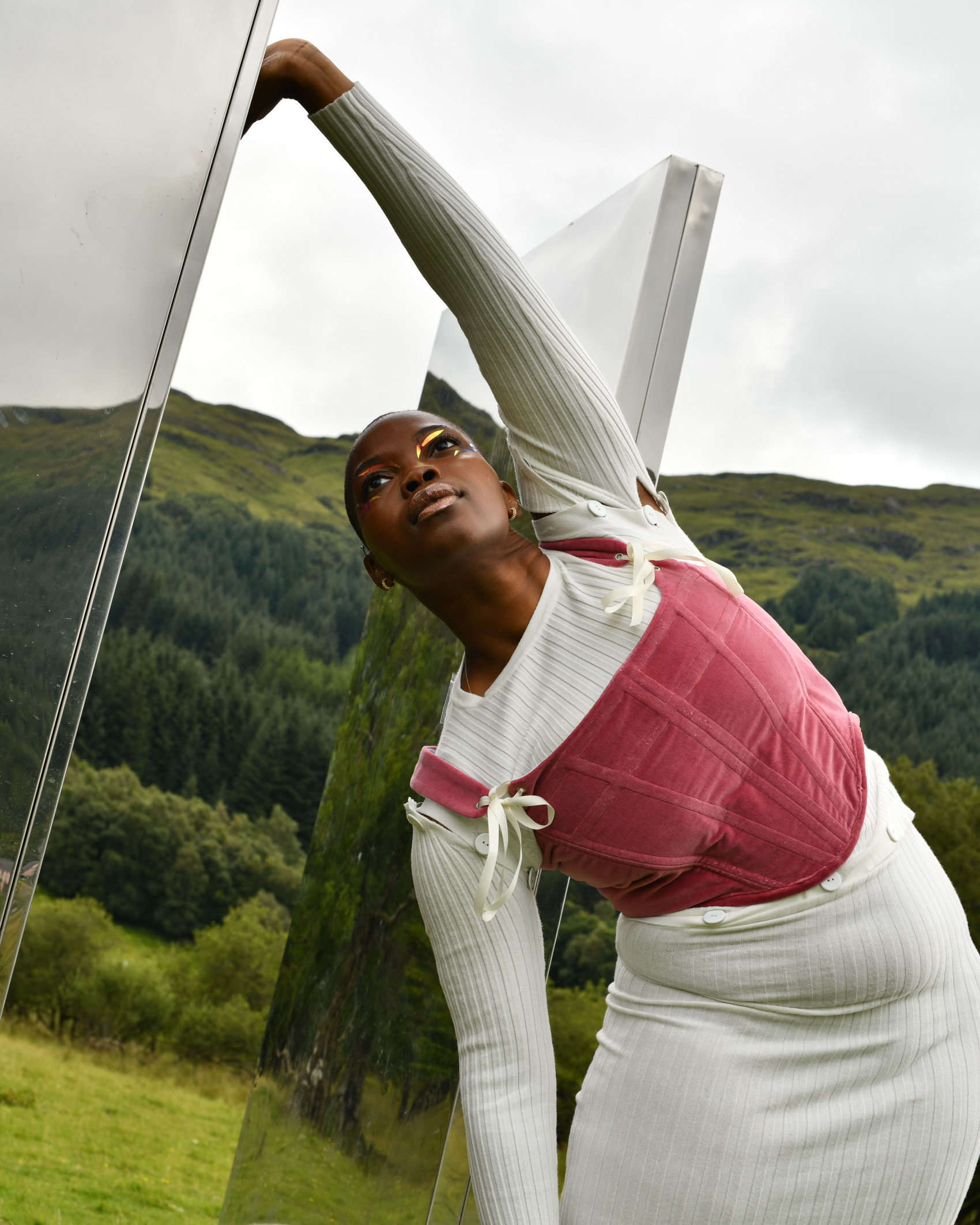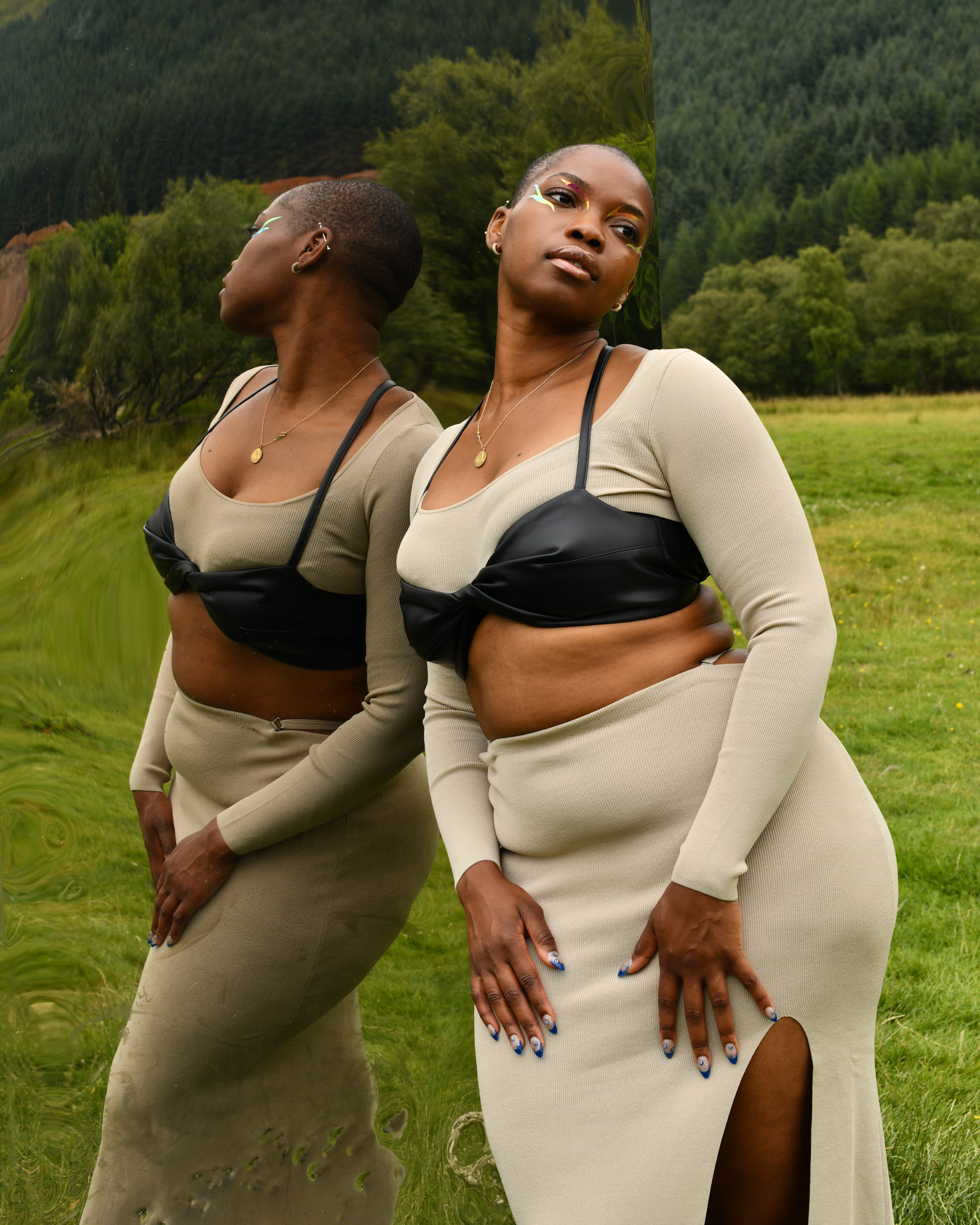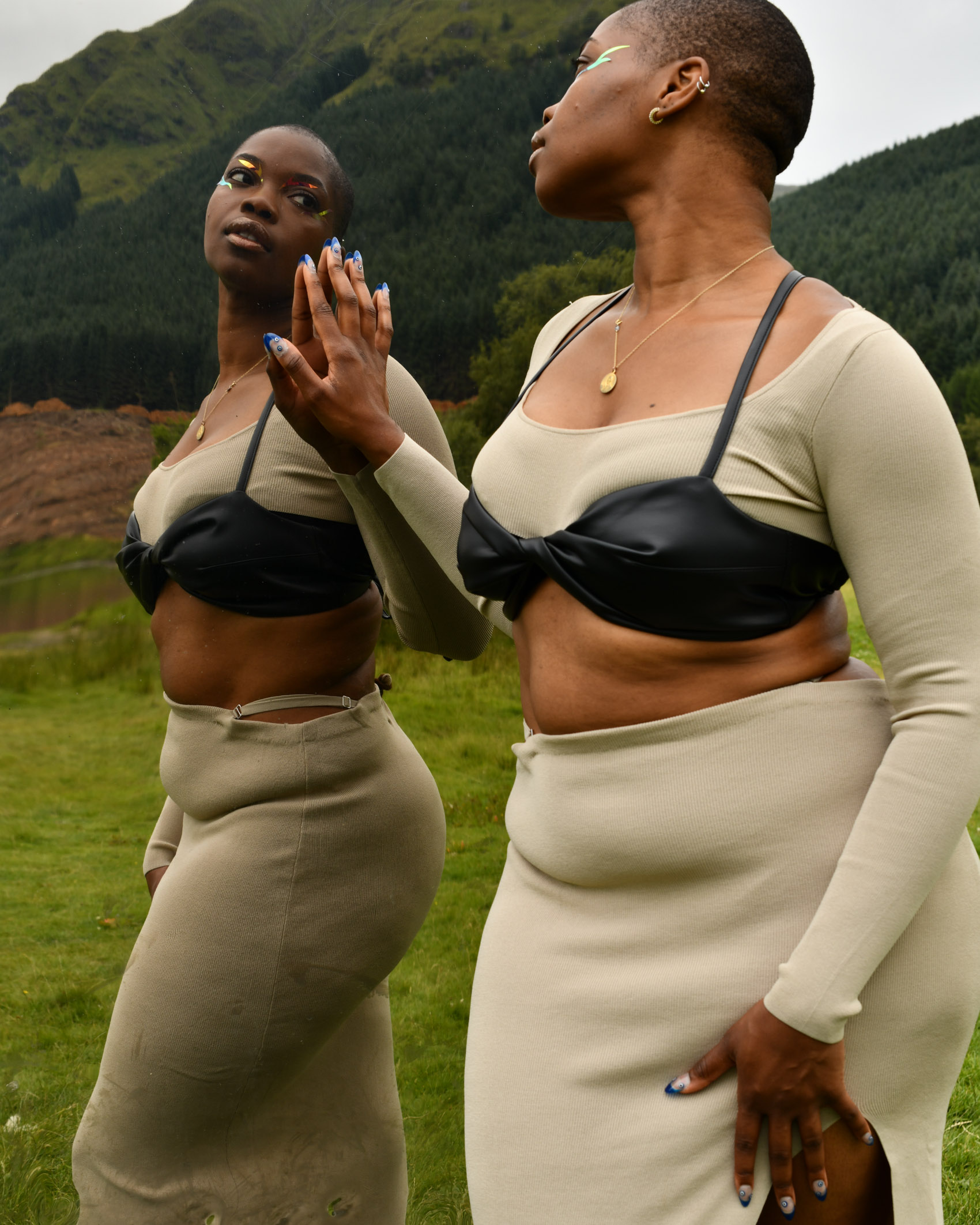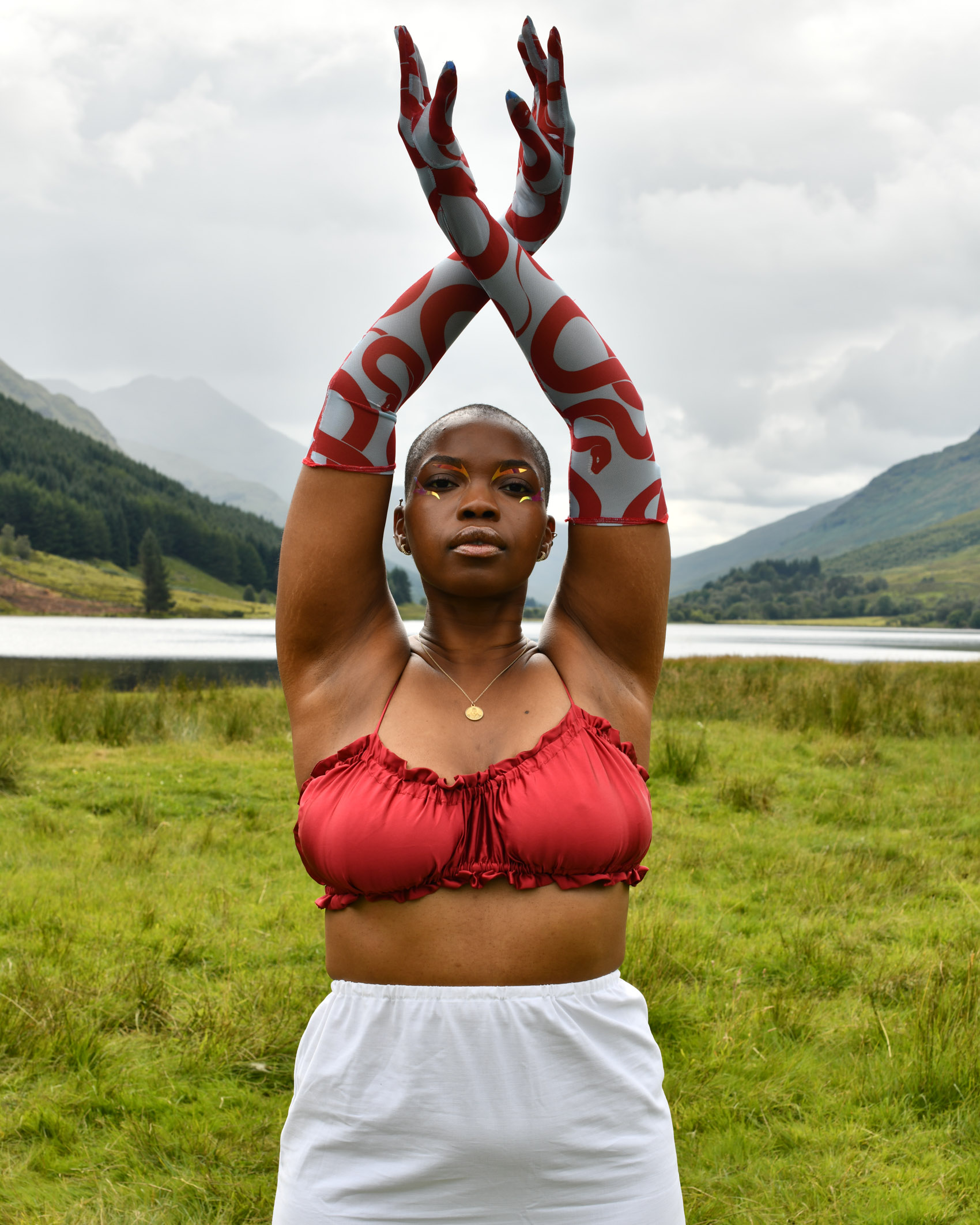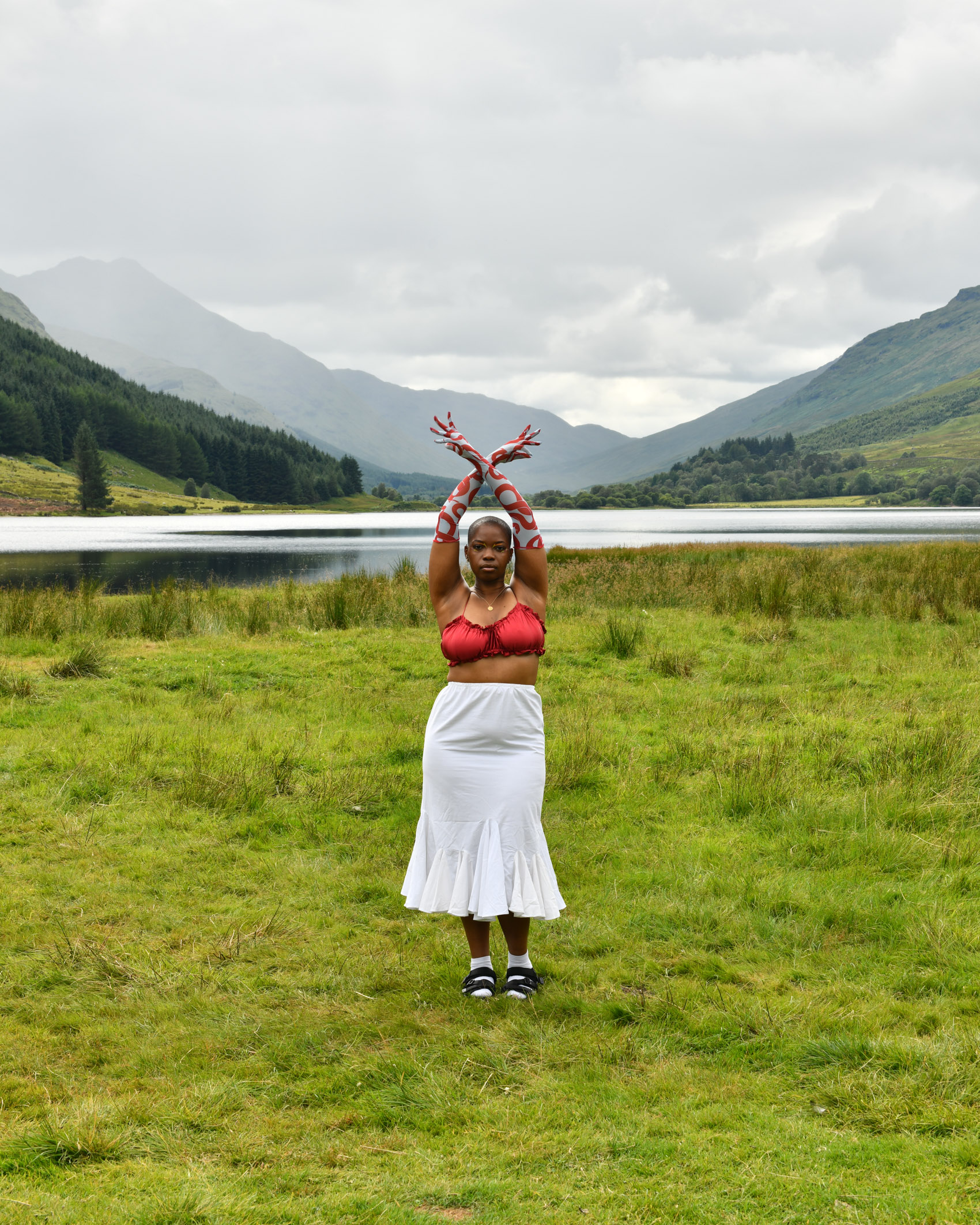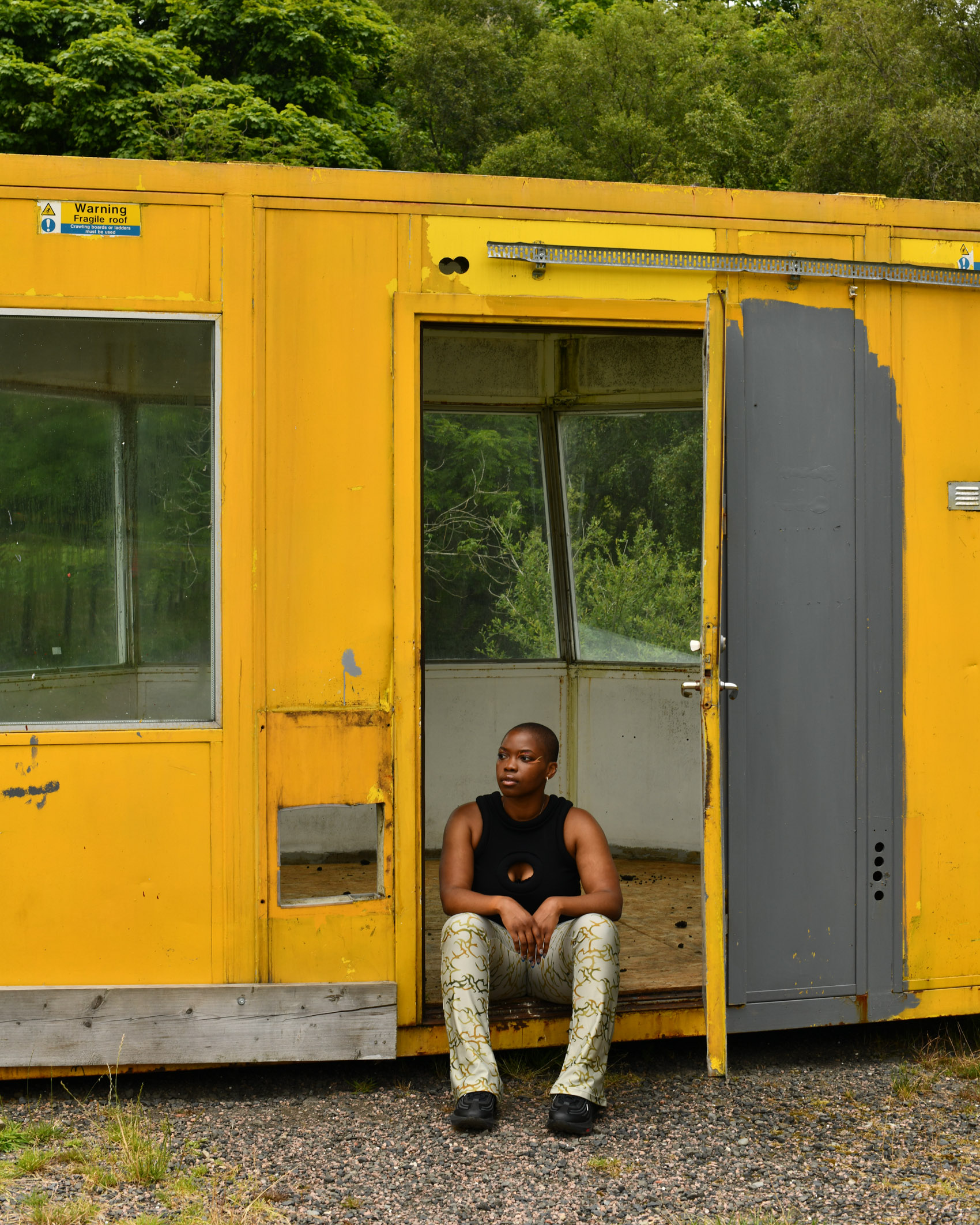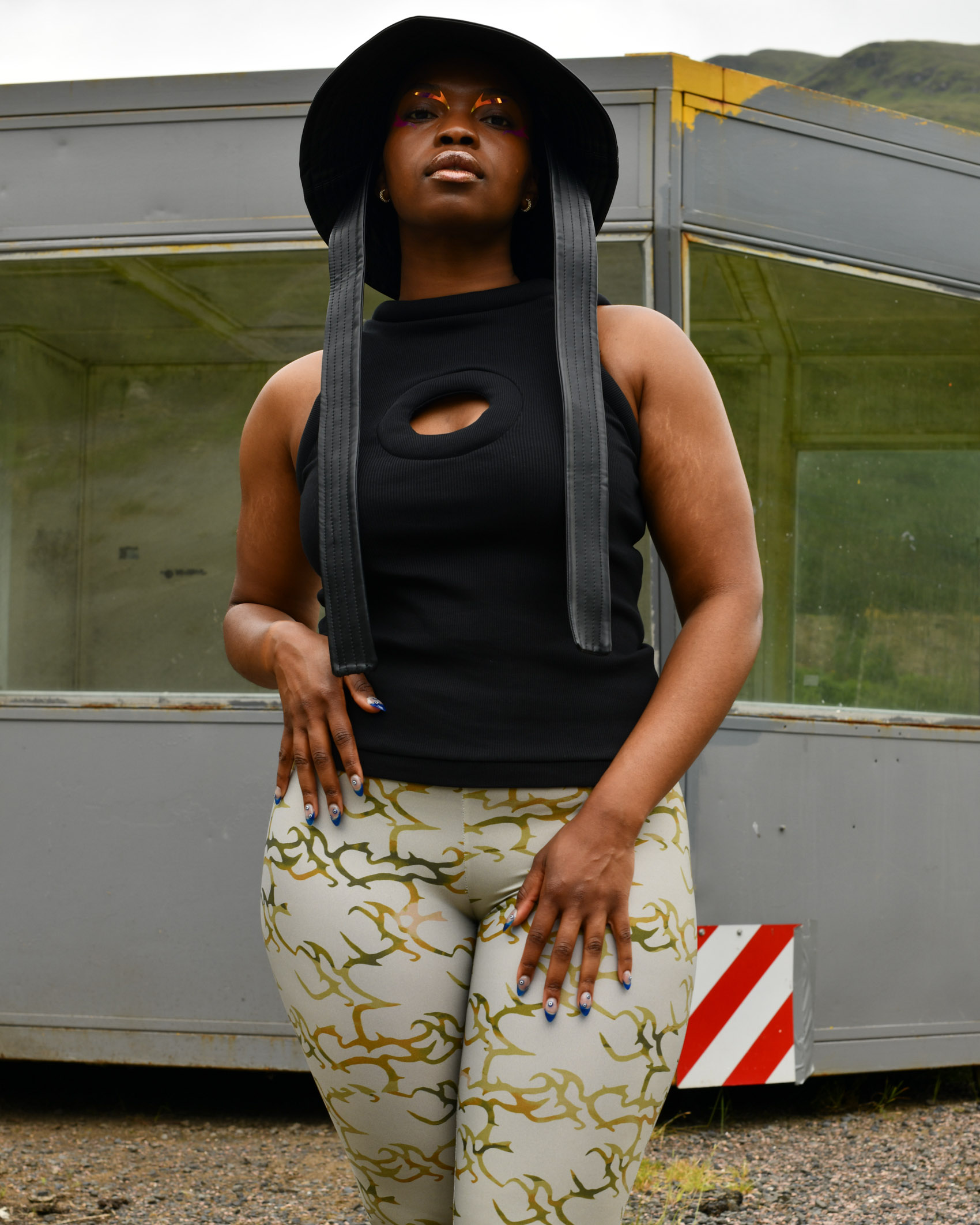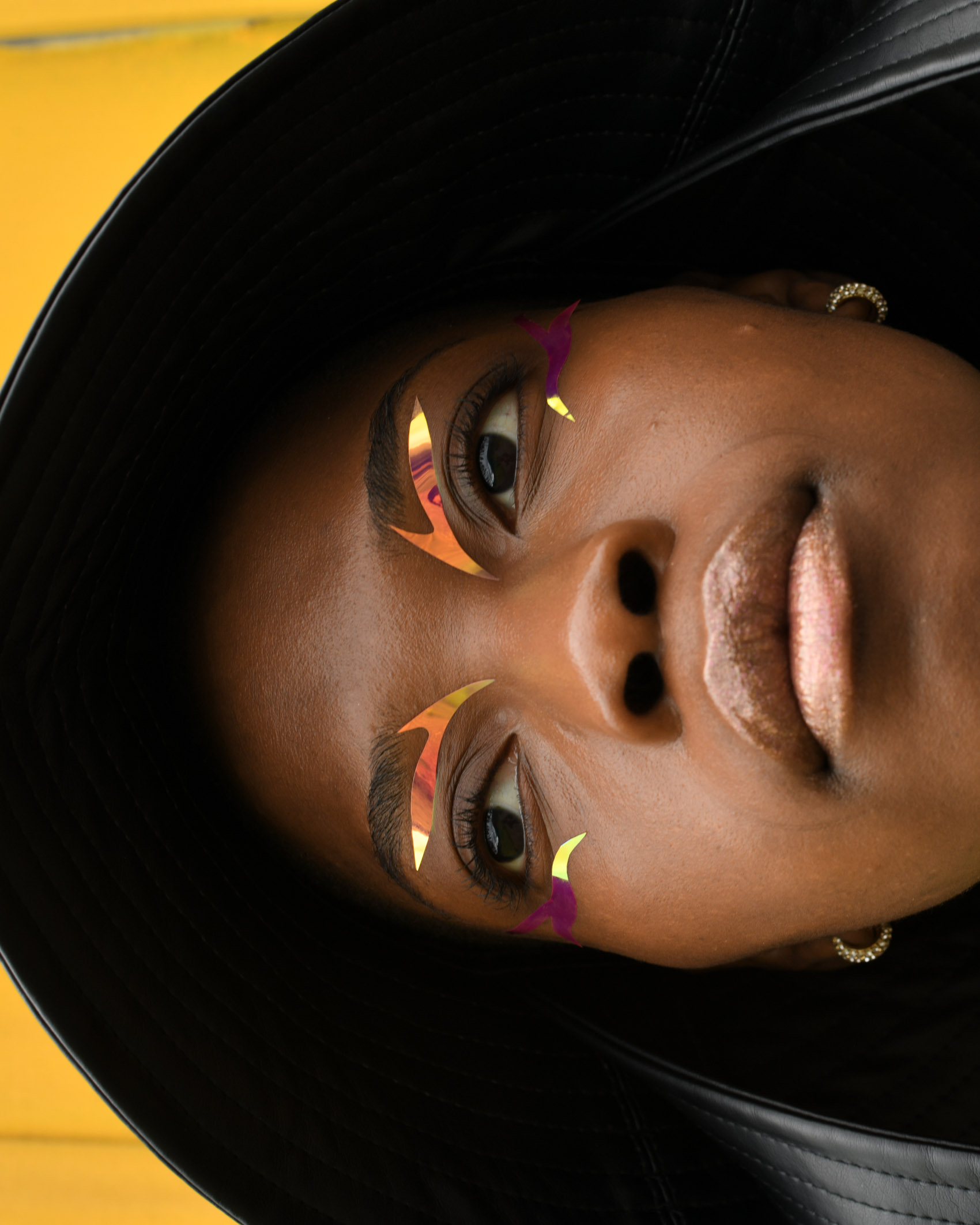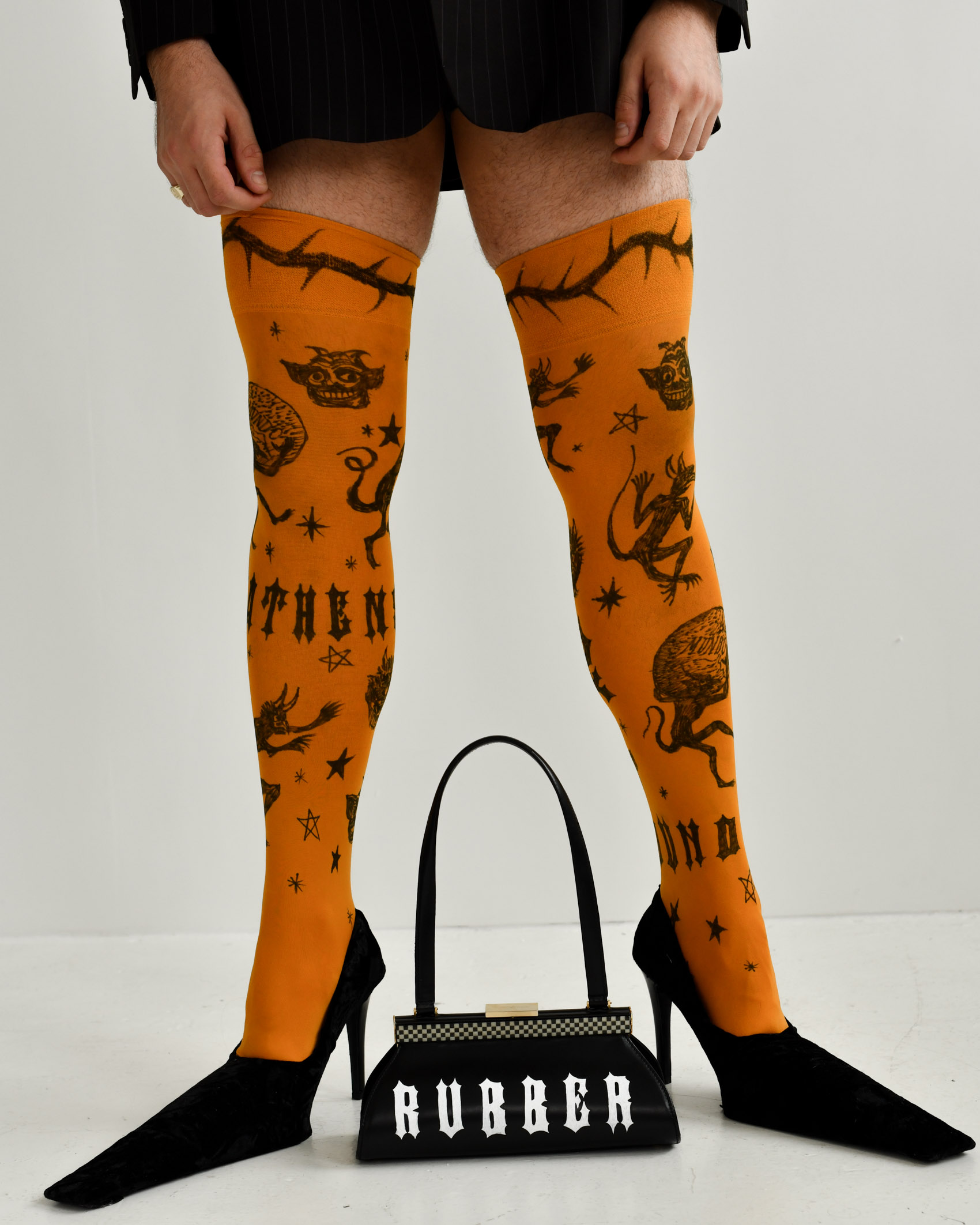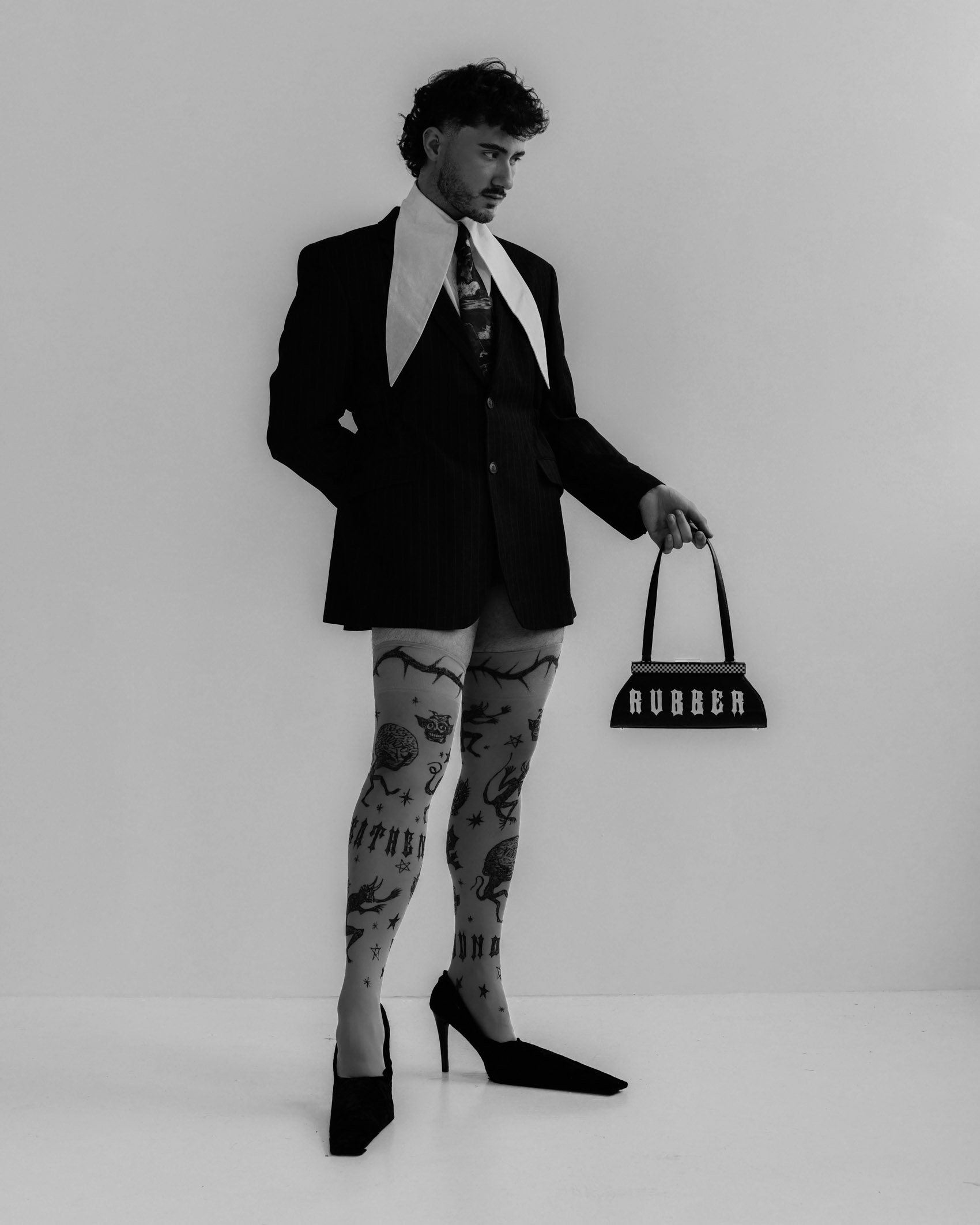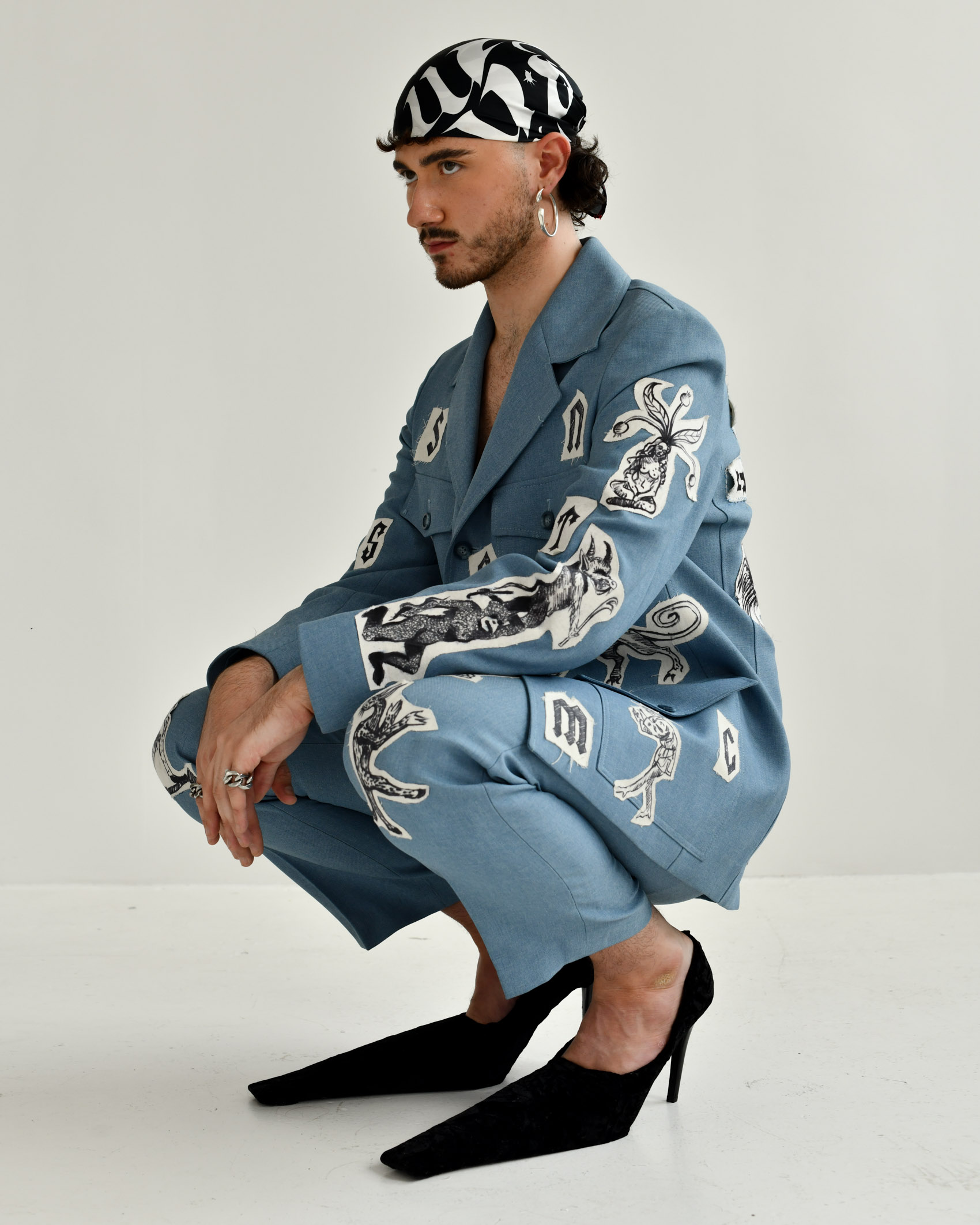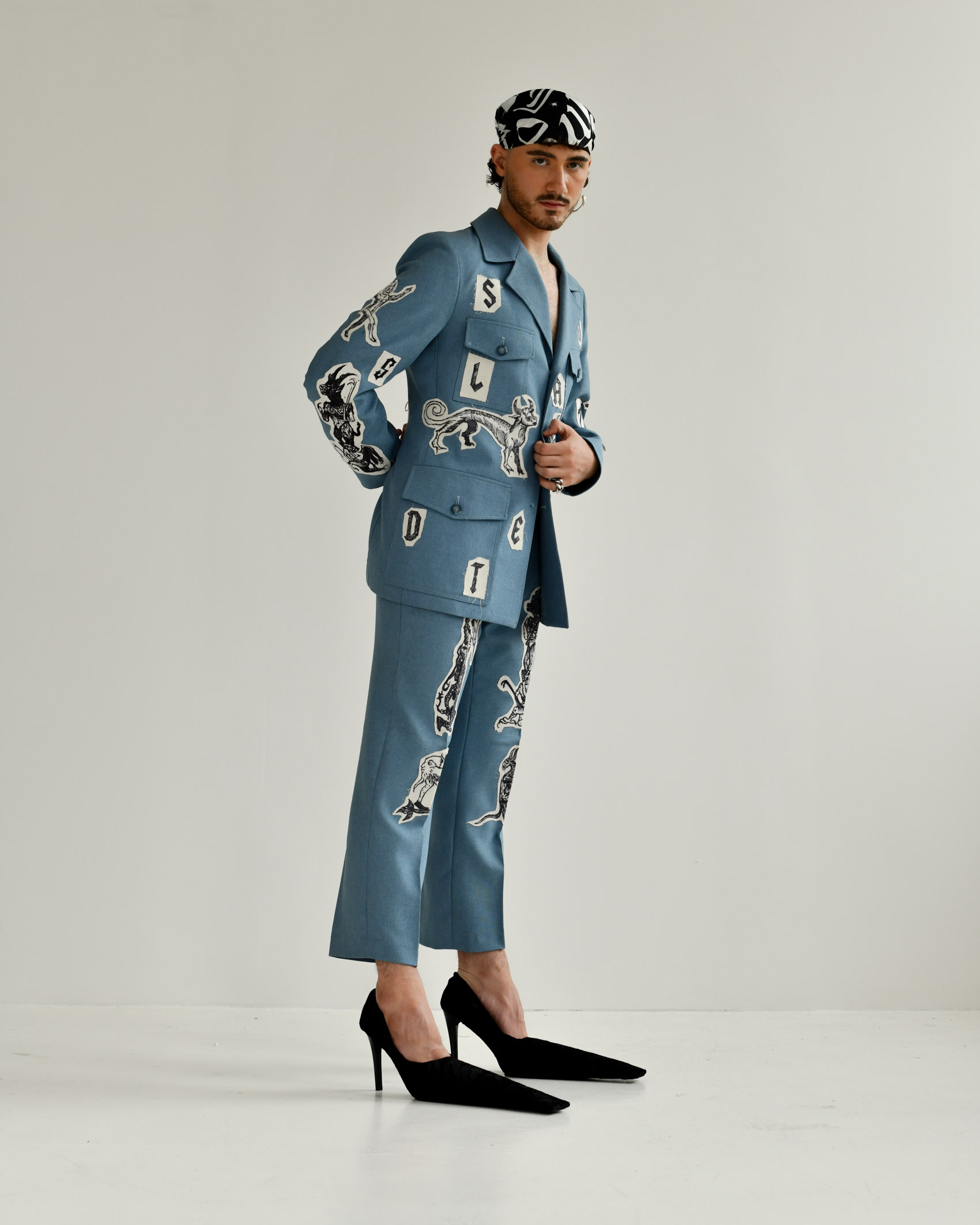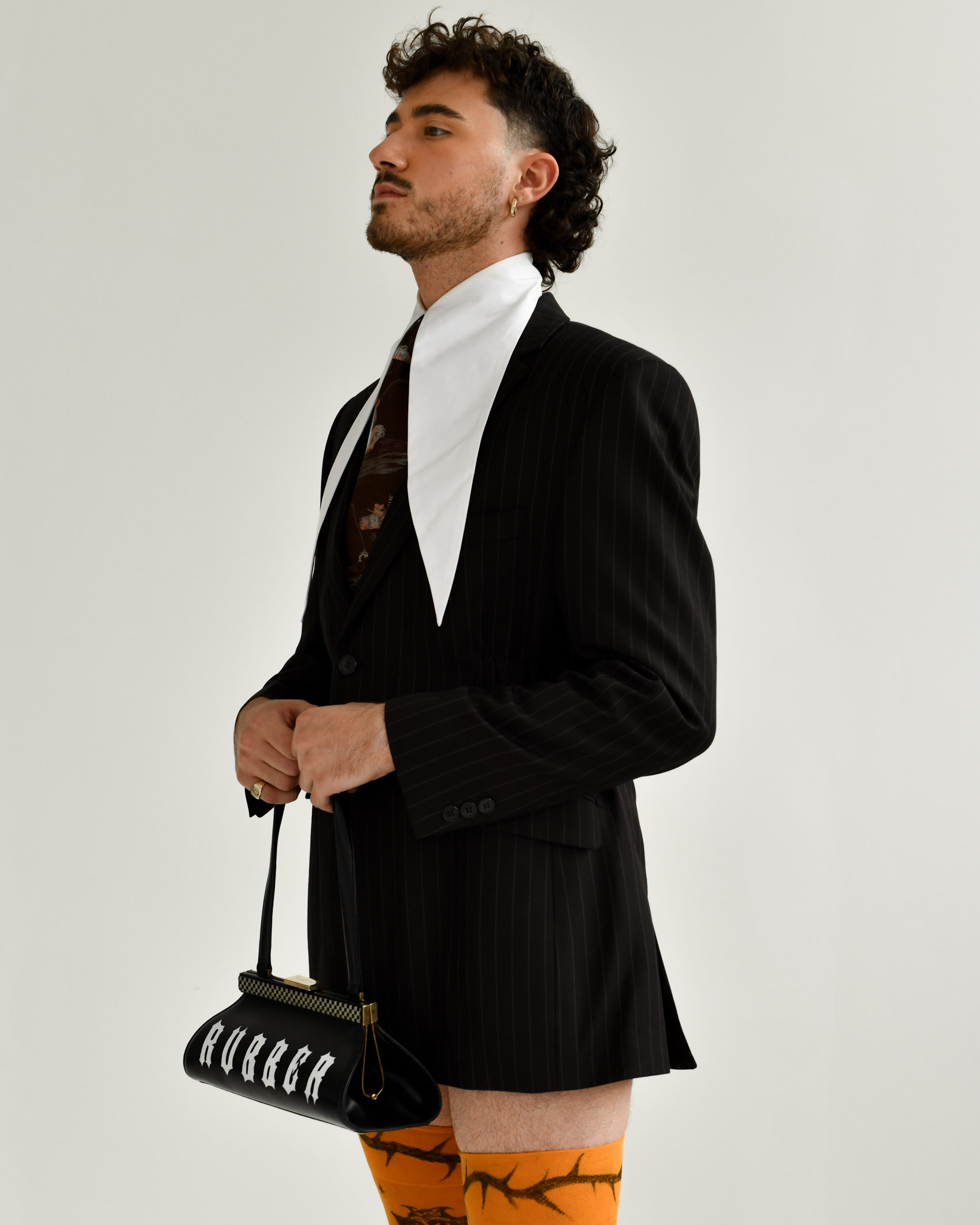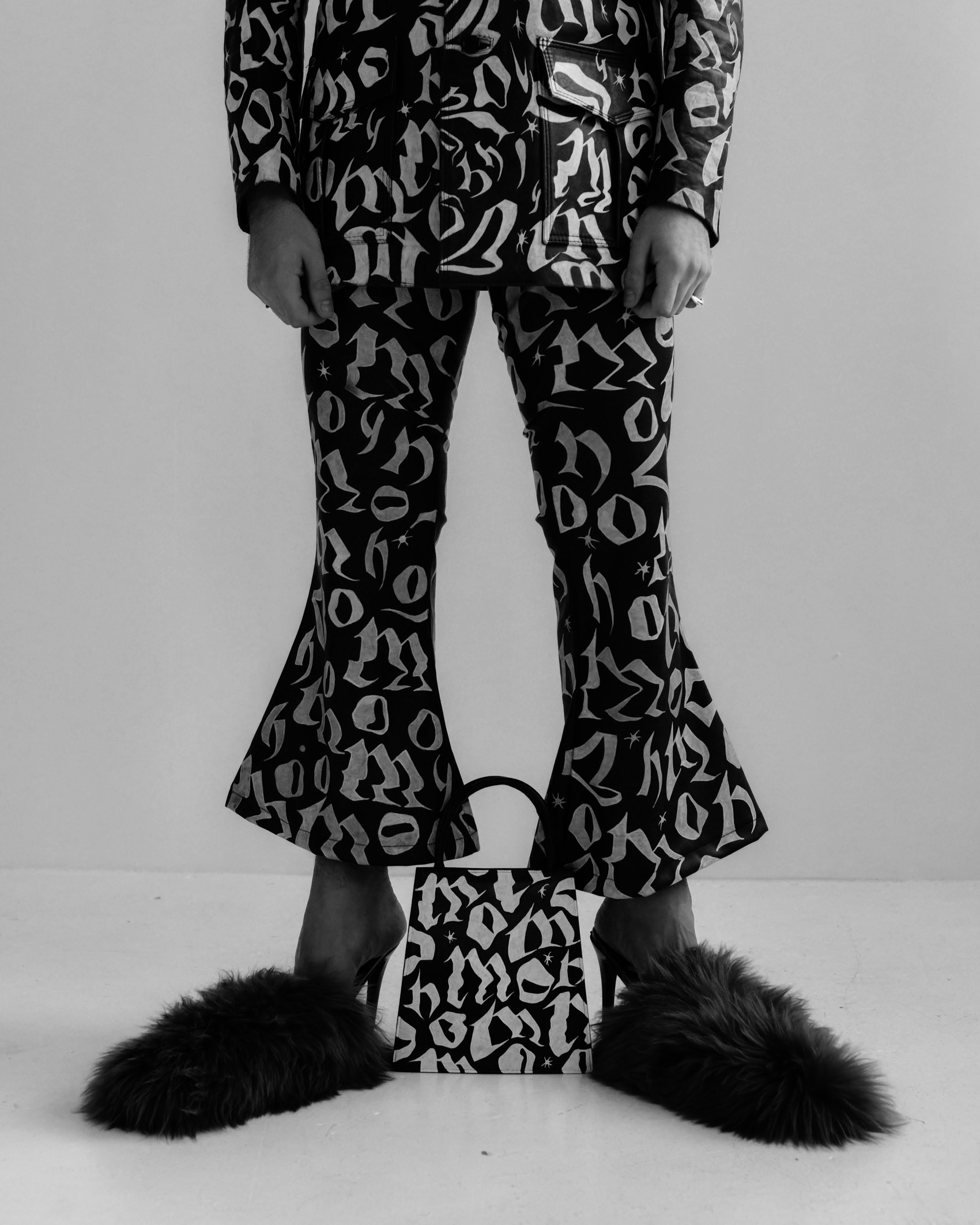SCULPTING with PJ HARPER
20.07.22
Featuring PJ Harper
Photography by Alex James Aylin
Styling by Tamara Turnbull & Graham Peacock
Words by Graham Peacock
PJ’s sculptures arrive at the studio in a brown cardboard box, filled high with styrofoam and bubble wrap. Whether contained in layers of packaging, laid out across the dressing room table, or placed around PJ himself, they centre the morning’s conversation. There’s a presence to them.
There’s a self awareness as well – as much a celebration of femininity as they are an eye-roll to the expectations put on the female pop culture icons Harper has been inspired by. They’re tangible manifestations of the sculptor’s own influences – his family heritage, his cultural fascinations. The women appear calm, indifferent, playful, effortlessly cool. Some of them sit in neon two-pieces, others lounge stretched out with mermaid tails. Some are nude. Some are busts that stop at the neckline. They’re all carefully handmade by PJ in his studio.
With a soaring online presence, the sculptor, who also goes by @pig.malion, creates sculptures that feels equally at home on a bedroom table as they do in a gallery for a global exhibition. Talking us through his process, his plans, and future ambitions, PJ sheds light on the mystery behind his work.
Hey PJ, nice to meet you. It’s nice to be around your sculptures this morning. How does it feel being so close to your work?
It’s nice to meet you too. I’m doing good, thank you for having me. It feels good, actually. It’s always interesting to see my work in different locations as opposed to just sitting around in my flat or studio space.
Why sculpture? How would you compare sculpture to other art forms, and have you explored any of them?
It’s got to be sculpture for me. Ever since being very young I’ve always had a fascination with small figures and dolls which has led me to where I am today, creating my own. I’ve dabbled in a bit of everything, whether that be painting, printing or video work, but nothing has my heart like hand sculpting.
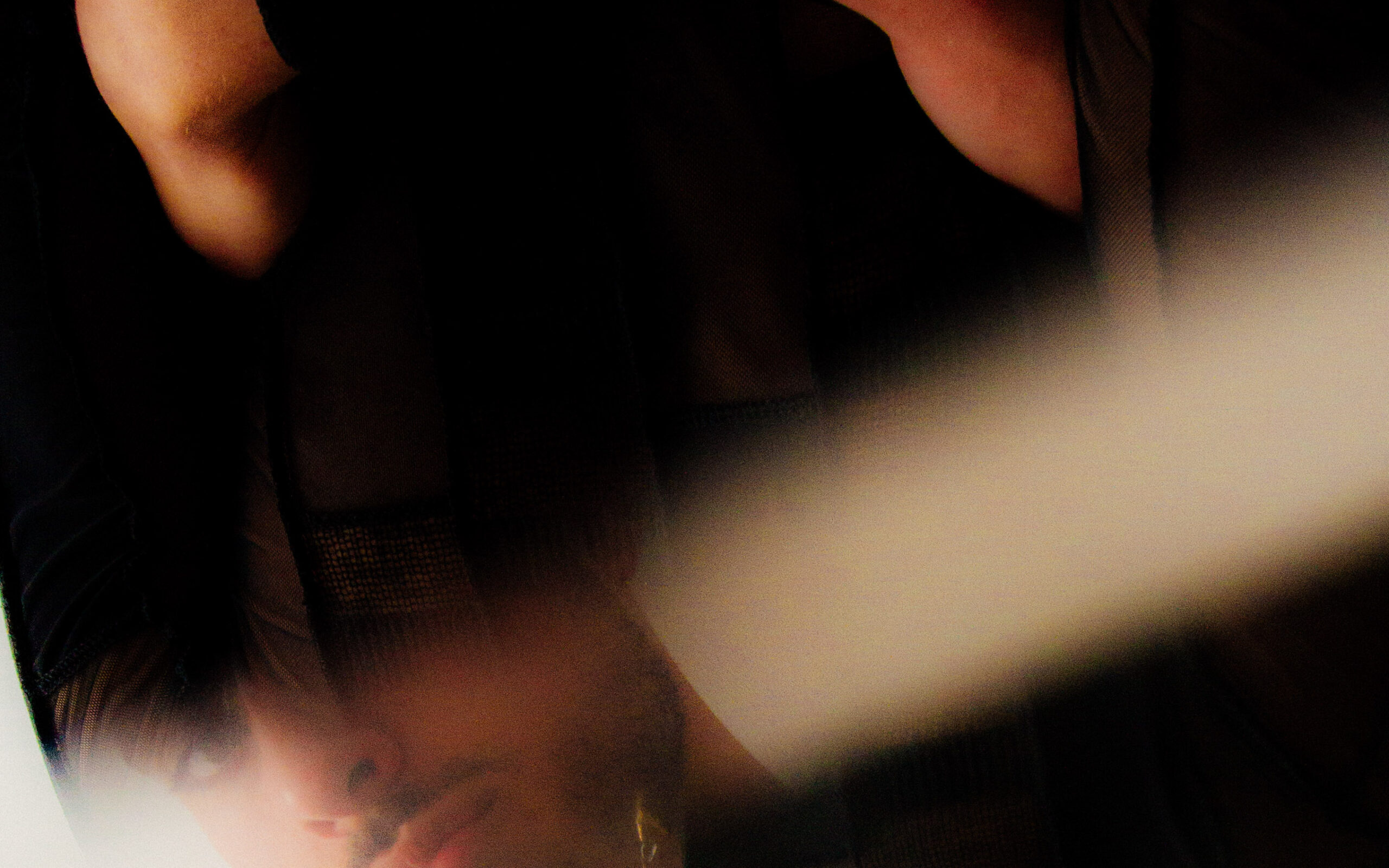
You talk a lot about lineage through your work – your sculptures are often based on women who’ve impacted your life. What is it about family and femininity you’re so drawn to?
Yes of course, I’m incredibly proud of my black heritage and I want to represent that always. My mum has definitely been the biggest influence for me, and my grandad. Despite all the hardships they have endured because of their ethnicity they have always maintained a positive outlook on life and I find that super inspiring. You know, I think it’s because I’m gay. Haha! and ever since being young I’ve always been obsessed with women, divas and all things feminine. I’d like to think of my work as my expression of the divine femininity.
Tell us about your relationship with masculinity and the masculine figure in art?
Well, as I just mentioned my two times Mr Universe grandad is one of the major influences on my work. I suppose it all really starts with him and what he was all about. Originally he was from Antigua and Barbuda, and was a competitive bodybuilder who also did a little bit of acting. This whole idea of body culture and black excellence has just been something I’ve always known, so it’s only natural that I want to push this within my work.
You’re bridging a lot of influences. Mythology obviously plays a big role. What else are you looking at and taking notes from?
Pop culture now and from the past, for sure. I’m a very nostalgic person and I love to look into the past as I find that this informs the future. I’m a sucker for anything 90’s – whether it’s movies, music or fashion. This is definitely the era I find most inspiring. I think had I not been a creative person I would have been a historian.
As a former Glasgow School of Art student, how do you feel about creative institutions?
I think it totally depends on the individual and how well you deal with that kinda thing. I didn’t really enjoy my time at GSA. I found everything to be too fast-paced and I couldn’t handle the essays, although I learned a few things for sure. I will say that my portfolio prep course at Tramway to get me into GSA was my artistic awakening. They really helped me to develop my understanding of what was important to me.
What advice would you give to someone about to leave art school, looking to transition from university to a career in their field?
Be sure of yourself. I wish I had known this sooner – it’s the most important thing that you believe in what you’re creating or doing. Having integrity will get you far.
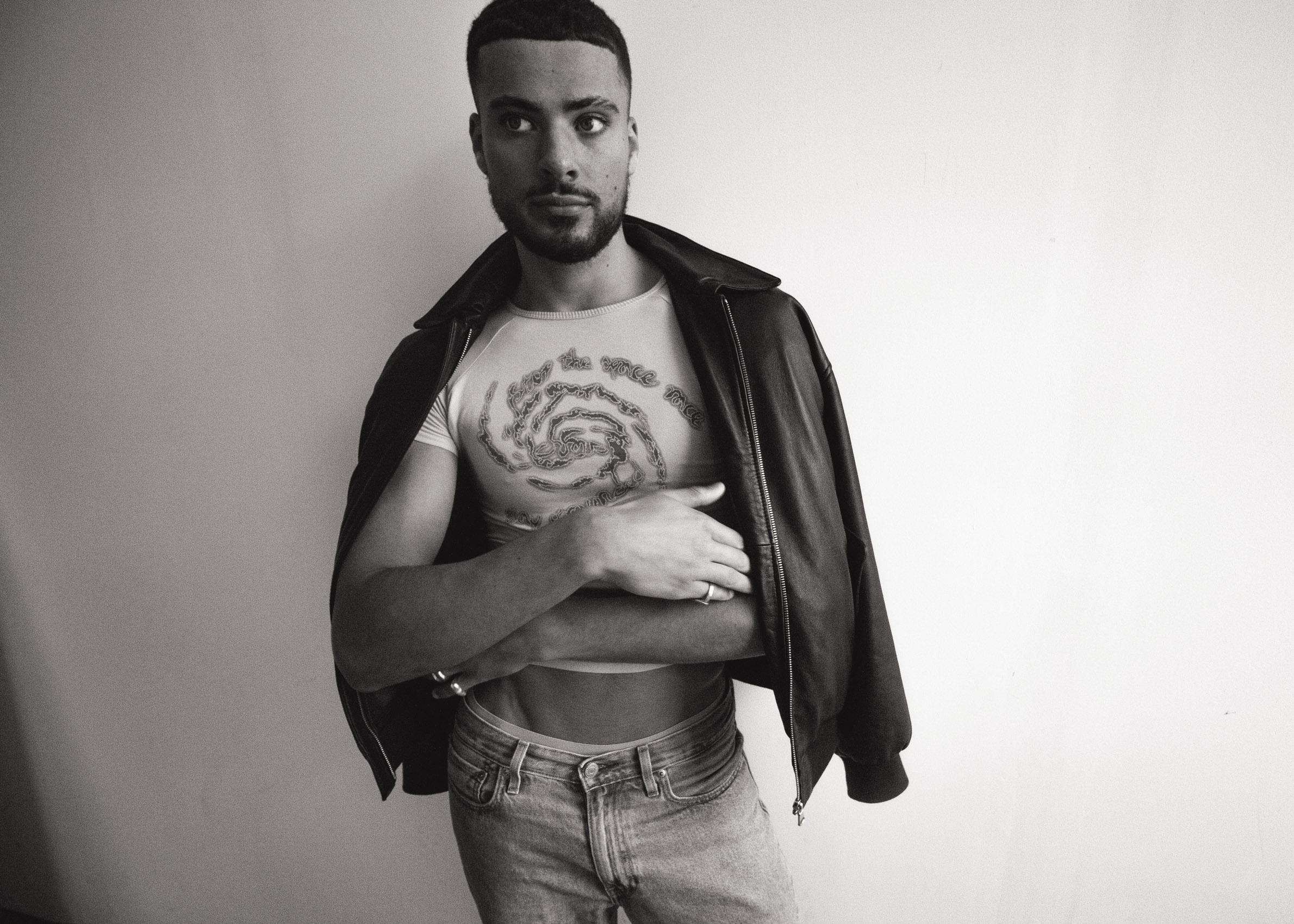
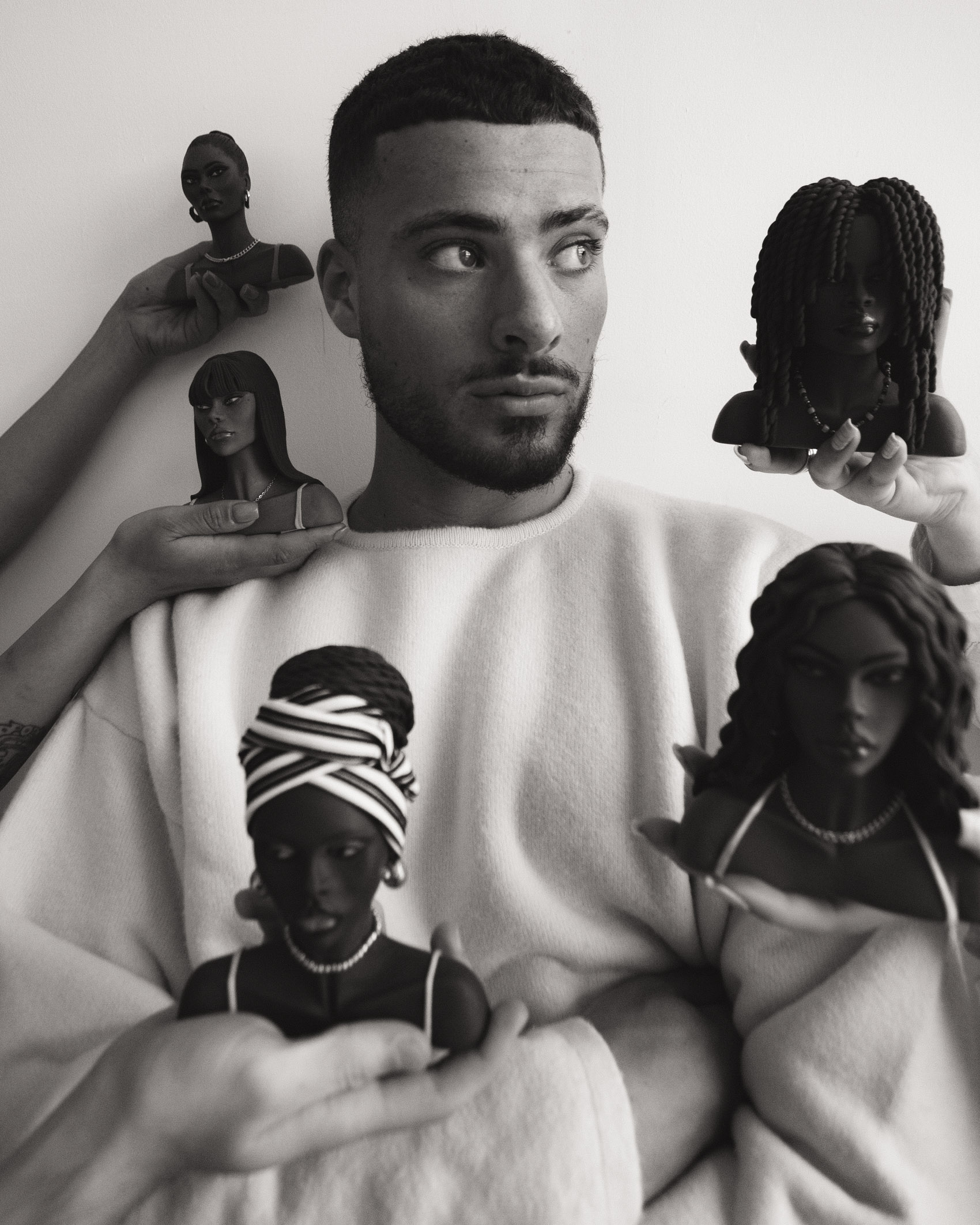
People talk a lot about how difficult it is to establish a creative career from Glasgow as opposed to elsewhere in the U.K., but you’re proof that that’s not necessarily true. Do you see yourself always being here?
It’s incredibly difficult but it happens and it’s important not to give up if things aren’t happening fast enough. I don’t see myself staying here for too long. I’d love to take my work to other countries. I want to do America just to see what it’s like, but these are plans for the future. Right now I’m quite happy in Glasgow.
You’ve worked with a lot of big names. We loved the sculpture you did for Jorja Smith. Who’s your dream collaborator?
Thank you, that was such an amazing opportunity for me. Being a fan of Jorja for a while then getting to collaborate was truly fantastic. That’s a difficult one, there’s so many people I’d love to collaborate with. I’d maybe have to say Erykah Badu, Rihanna or Megan the Stallion, but the list of dream collaborators is endless!
We imagine there’s been a shift in your relationship to your work since gaining a bigger profile. How do you stay focused with all the noise going on around you?
The main thing for me is that I want to make all my ideas and I end up overwhelming myself with a ridiculous amount of work, I’m now starting to realise I can only do one thing at a time. But I’m so lucky to be in such an amazing position with my work right now and it’s exciting to see what the future has in store.
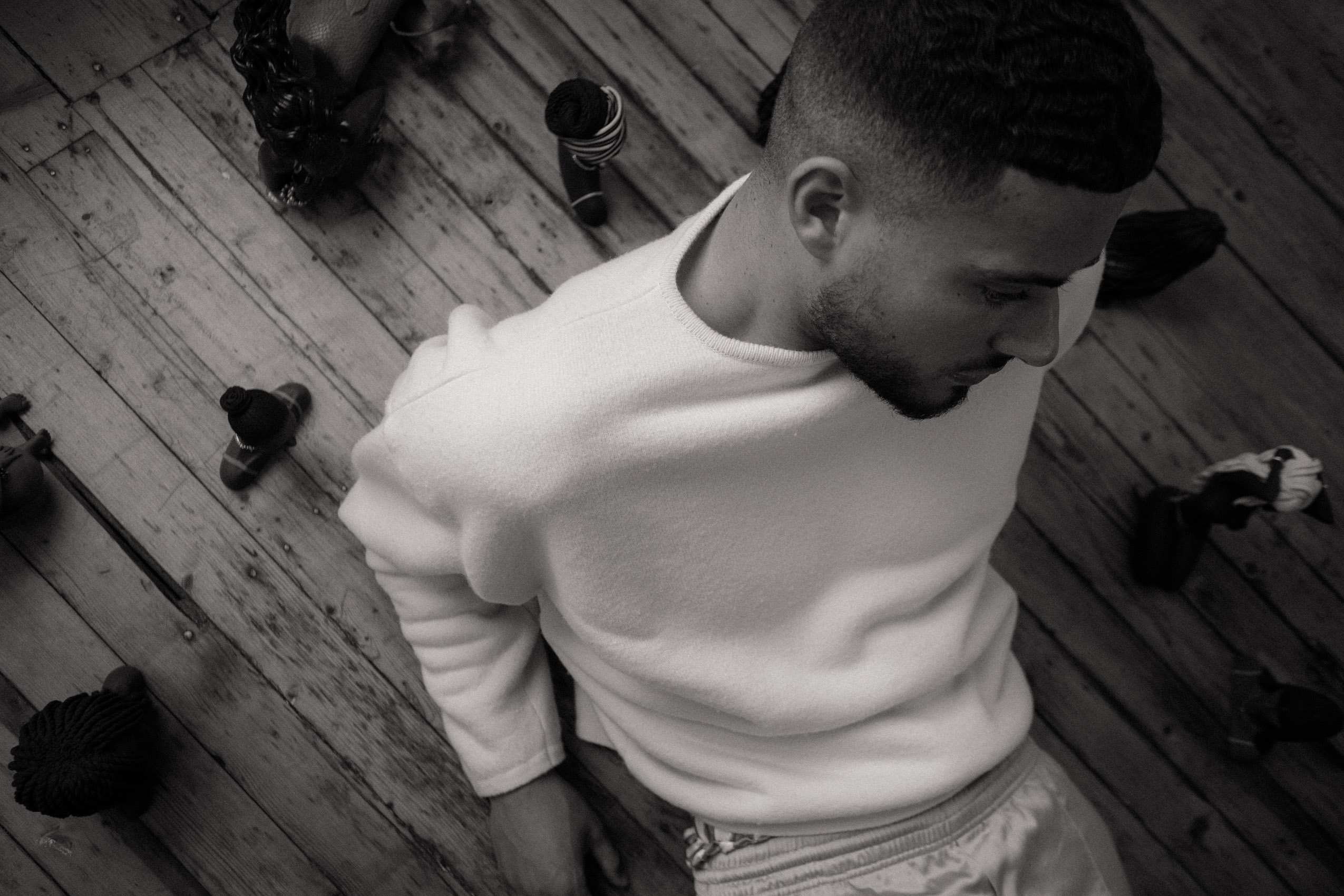
A NEW DARK-AGE with SHREK 666 & Lucid
07.07.22
Featuring SHREK666 & Lucid
Words by Graham Peacock
Styling by Tamara Turnbull
Photography by Bethany Grace
Fetish, magic, and surrealism collide in the work of SHREK 666 and Lucid. As individuals and as partners, both performers move through Scotland’s creative circles, embodying gothic folklore whilst innovating the country’s club scene.
They’ve emerged as something of an industry blueprint: charting a new path for queer perfomers, reminding them that a devotion to a single practice is as unneccessary as appeasing the mainstream. Taking in DJing, tattoo artistry, performance art, and prosthetics work, the term multidisciplinary barely scratches the surface of the couple’s work. And is it all paying off? Their roles in the launch of ‘Trollops’ at Glasgow’s famed Berkeley Suite in the same month as their prime-time set at Riverside Festival suggests it might be.
Their increasing omnipresence in Scotland’s club spaces hasn’t diluted the air of mystery that surrounds both SHREK 666 and Lucid. Getting to the bottom of it all seems to spoil the fun, as the couple most likely know, but our conversation with them got us thinking about the power in sexual liberation and queer collectivism.
Check out the feature below. The main take-aways: conventionality is dead, kink is forever.
Hey SHREK666 & Lucid, How are you?
SHREK666: Hey, I am well thanks. Pretty tired today after a big weekend but feeling joy from it.
Lucid: Enjoying the sunshine today and having a relaxed Monday.
Who is SHREK 666?
SHREK666: SHREK 666 is my performance avatar of an ogre embodiment. The name and troll I’ve been working under for years now.
Lucid: The love of my life.
Your artistic practice covers prosthetics, DJing, tattoo artistry, and performance. How do you describe yourselves as artists?
SHREK666: Multidisciplinary. I work mostly in performance and as a maker and director and collaborator on a wide variety of projects, shows, and events. It’s more about concept and feeling before medium.
Lucid: I am a performer and collaborator. I give creative direction as well as concept input for various multimedia and live performance projects.
It feels like you’re everywhere at the minute. You performed at Riverside which is such a staple in Scotland’s festival circuit. What was it like performing in front of that crowd?
SHREK666: It was fun, the reaction was fab. My slot was in between Big Freedia and Roisin Murphy on the main stage which was kinda crazy. To be on a festival lineup so full of queer representation is a rarity and shouldn’t go unnoticed, and that was due to the hard work of Bonzai Bonner. Safety is a big issue however when mixing crowds. I know of multiple trans* people who were physically and verbally attacked. There’s still work that needs to be done.
Lucid: I was working BTS at Riverside, stage managing and working artist liaison. The Saturday had the most diverse line up that
Scotland has seen on a festival.
Both of your work appears to take influence from medieval imagery, body horror, religious imagery, and folklore. Have these been lifelong areas of interest? What shaped your performance style?
Lucid: We are both into surrealism and magic. As well as being goths these things influence our performance style.
SHREK666: We’re in a new dark-age.
Congratulations on the launch of Trollops at Berkeley Suite, too. Can you tell us a bit about the backstory and purpose of this night for readers who don’t know?
The backstory is in where the fight for sex workers rights and queer & trans rights meet. It’s a space that celebrates those intersections evolving strip club culture to the next level so it’s not just for cis men. A way of thinking about how you can appreciate bodies respectfully and showing how it’s perfectly possible to respectfully “objectify”. Also, importantly, Trollops is giving opportunity and celebrating trans* & gender nonconforming dancers for the first time in Scotland.
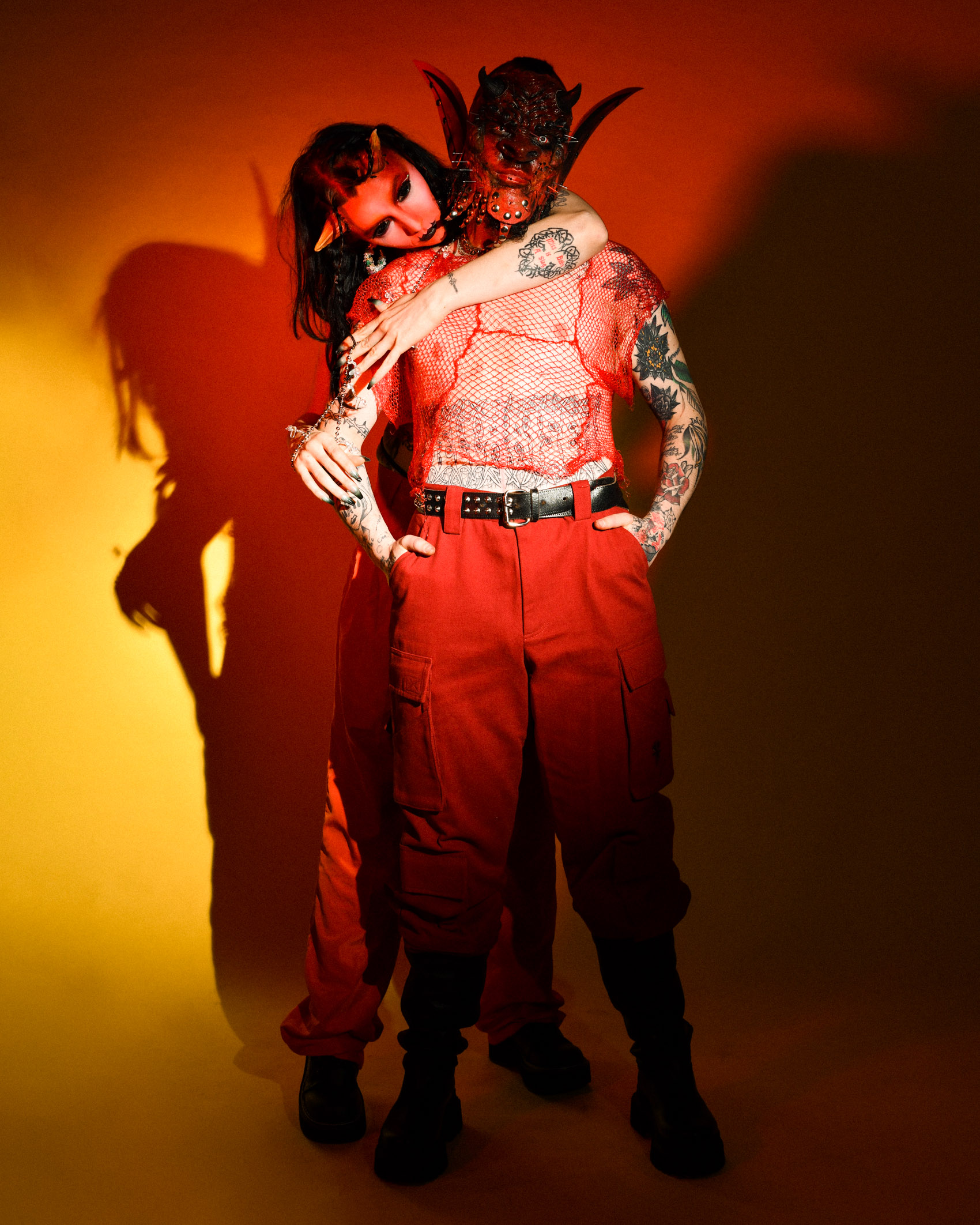
SHREK666 wears Jean Friot
Trollops felt like at its core a celebration of sex in all its forms. It can be easy to forgot how binary and prudish mainstream discussions of sex are. What are you both hoping to communicate about sex, sexuality, and relationships through your work?
Lucid: We tend to play with fetish and power play when we work together. We like it when our audience leaves thinking about why they feel a certain way and hopefully it can open some peoples perspective up on sex. Our audiences are placed delicately into the role of a voyeur. As each person’s sexuality is individual to them we are hoping to communicate to the viewer as an individual that curiosity can be powerful.
SHREK666: Having a deeper understanding of pleasure and where those feelings come from will overall allow for more pleasure, better relationships, communication, and sex. I often use one specific fetish or kink as a starting point for a performance and explore within that, although there are so many ways to explore and share intimacy [other] than sex and we play with that through our performances.
The kind of spaces you both create, independently and collectively, no matter the event, promote love and acceptance. They’re spaces you can dive into and forget about all the anger and judgement outside. Do you feel a responsibility or even a pressure to be role models or spokespeople on queer topics?
SHREK666: I think who you choose to work with is important. Having a mutual understanding, ethos, and passion for making the space comfortable for especially queer people but open to all who show respect. We want and deserve a good time but these things take constant communication and work. I don’t feel a responsibility to be a certain way, I care about community and believe it’s important to share information.
Lucid: I do not feel pressure to be a role model or spokesperson. I have certain lived experiences that have shaped me and made me realise the importance of community and speaking up. Energy flow, blockages, and healing through movement have been a big part of my adult life. Hence why clubs have always been attractive to me: they can be a place to break patterns of shame, heal from trauma through dance, and share connection. There is however a level of whit and care required when working with club nights. Any space where d*ugs or alcohol will be consumed is not a safe space. These spaces are important and should be protected.
What’s coming up next for you both?
Lucid: I am studying Community Development in the Autumn, with hope that I will learn more effective ways of activism and hoping to continue to work in the queer and sex work communities.
SHREK666: I’m working on an exciting performance commission for Fierce Festival with my boglins and I’m doing a few more music festivals in the summer. Making more music, performance, and sculpture and working on future events for our collaborative club night which is currently called Ministry of Pound.
IN TALKS with SPENT
22.06.22
Featuring Spent
Words & Styling by Graham Peacock
Photography by Scott McWilliam
Make-up by MVB
Venue Bonjour Glasgow
It’s exciting to see an artist like Spent gain traction in the music scene. With infectious electronic beats, and a lyrical ability that sees them move between powerful and unbothered from one line to the next, Spent’s sound appears as effortless as it is unpredictable.
Not satisfied with solely releasing music, Spent creates an entire world for their listeners to immerse themselves in. With a bold visual style and innovative videos, Spent has emerged as a multidisciplinary artist who cares about serving up thought-provoking, hedonistic, complex work, and who doesn’t give a f*** about what everyone else is doing.
Having climbed through the ranks despite an absence of live venues, we visited the Cybersexy musician in Bonjour, a queer bar in Glasgow’s East End, to talk about all things digital, physical, and queer.
Spent! How are you?
I’m good. I’m feeling very extroverted, which is lovely for both of us.
We’re in Bonjour: a profit-sharing, workers co-op queer bar in Glasgow. How does it feel getting to perform in spaces created for and occupied by queer people?
It’s nice. It’s refreshing. When you’re coming up, and you’re performing in spaces where no one wants you, and no one’s ultimately listening to you, and you’re just selling your soul, it can be a bit disheartening. I think especially for queer people that’s kind of just everyday on the street. So it’s quite nice to come into a space and be turned the whole way up and be fully you and do your art, and everyone’s there to really be there. It’s nice. It’s good.
Tell me about your name.
It’s simple. Spencer is my last name, Teddy is my first name. So, half of Spencer, and T for Teddy. But the alternate way is Spencer, and I’m bent, so: Spent.
We’ve read other interviews you’ve done, and you talk about Spent in the third person. It feels like Spent is more than just a stage name, do you feel like they’re separate from you?
It’s both, I think. Spent is completely informed by my personal life and my experience. It’s so personal, but I think by removing Spent from Teddy I get this freedom to be as creative as I want with no restrictions. It’s removed from the physical space so I can exist in the digital. And this can be expressed through sound, visuals, performance, anything. I think Spent just removes the limitations of physical space.
Your work seems more preoccupied with the digital world than the physical one. I think queer people find a lot of power in the way they present themselves online, do you feel this way?
Yeah, I do for sure. I think a lot of queer people do because it’s a space where you have complete agency to be whoever the fuck you want and do whatever you want to do. But I don’t necessarily think my work focuses on the digital space, I just think it focus on queer experience. I think, as I’m growing up, it’s more about how I then translate that into the world and the people I have around me. So it was very online-based, and now as I move on it’s more as a commentary on the time.
Speaking of the digital world, what was your most recent Google search?
‘LoveHoney discount code’.
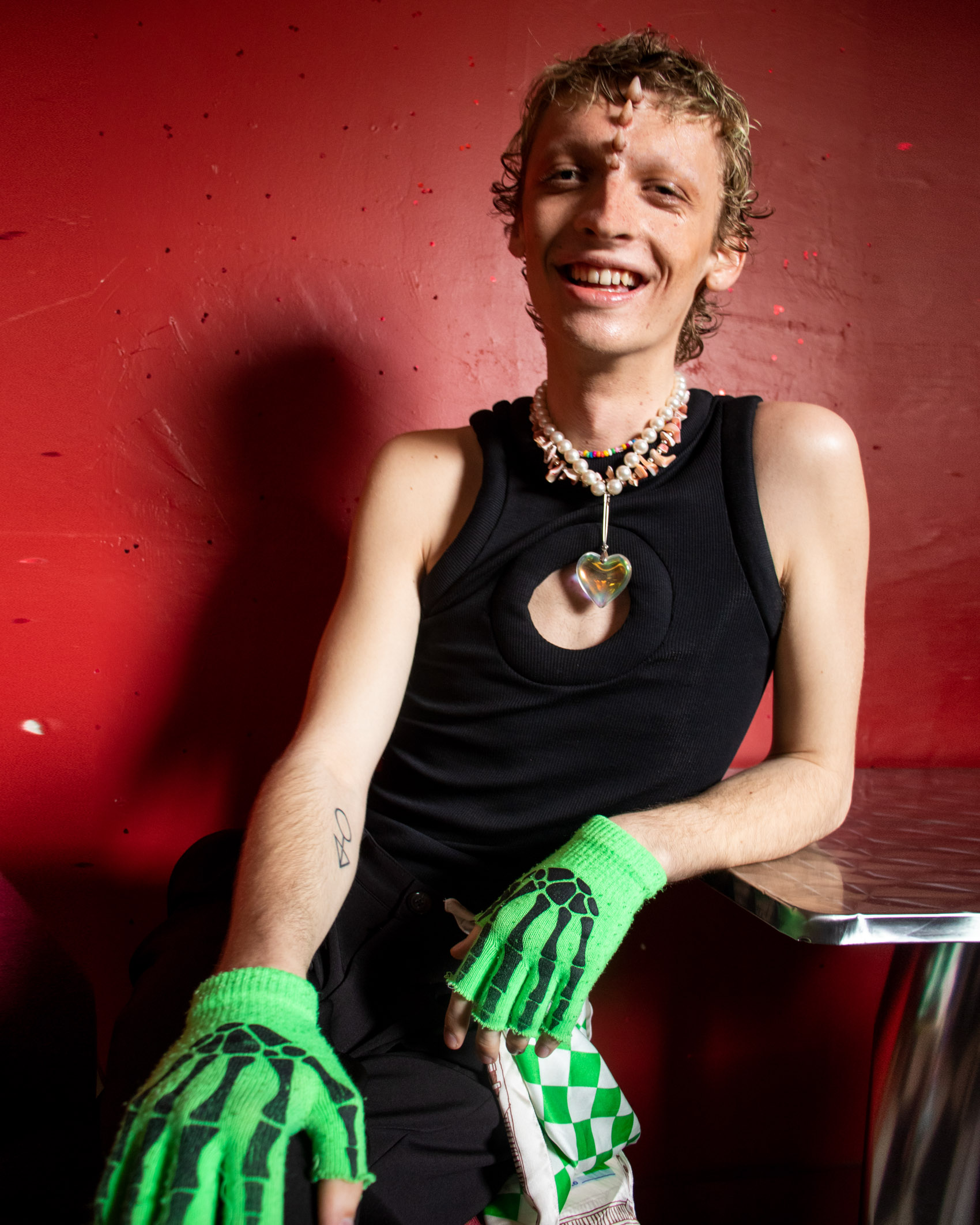
We keep listening to Cybersexy. Is this song part of a new project?
Yeah, it’s part of new stuff. It’s planting a foot in reality, this whole new project. I’m in my Basquiat era. Like, I’m not trying to paint a really realistic situation. I’m just churning shit out about the real queer, nonbinary experience. My new song is called Eyes. Cybersexy was the club, it was the online space. Eyes is that feeling of walking down the street with all eyes on you in the best way and the worst way. Like yeah I look good, but do you want to fuck me or do you want to fight me?
The same can be said for any creative industry, but the music industry feels especially fast-paced. Do you feel a pressure to release new music, or do you feel like you can take your time?
I definitely felt pressure with the last stuff. I was at uni full time and releasing songs and music videos every single month for a year. It was so intense, but I felt I needed to otherwise I’d be forgotten. Now I don’t feel that at all. I’m an independent artist, I don’t have a label. Okay, I might be in the industry, but I’m also not in the industry – I think that provides such freedom, because I can just do whatever I want. I believe in my music, I’m giving this perspective that hasn’t been given a lot before. Regardless of the sound, the subject matter, where it’s coming from, is not in mainstream stuff. So I don’t need to chase, I need to give my authentic real experience, and if that happens to be once every 2 weeks then fine, if that’s once every six months, then fine. It’s just about authenticity.
Speaking of authenticity, people throw around the term authentic, and they throw around the word experimental. But we feel like your work is genuinely both. It’s experimental in the sense that it fits into the genre of experimentalism, but listening you can tell that you yourself are pushing yourself to experiment within your sound. Who influences you?
I’m influenced by everything, and a lot of things. At the moment, it’s James Blake, Frank Ocean’s Tumblr – Patti Smith’s book Just Kids is the reason I moved to Glasgow. Obviously Arca, JPEGMAFIA, and Andy Worhol at the moment randomly. I was never really into him before now.
Okay, that’s all. I’m buying you a drink at the bar. What are you ordering?
A pint of your cheapest cider.
IN TALKS with MEDICINE CABINET
25.11.21
Makeup by MVB
Words by Tegan Jaimie
Scotland is a hotbed for musical talent, a burning underground scene that’s witnessed the likes of LUNCH pals Lucia and the Best Boys, Nova and TAAHLIAH ignite to roaring critical success. This week, we meet another burning talent, Medicine Cabinet, and let’s get started by stating it’s a Medicine Cabinet world, and we’re just living in it.
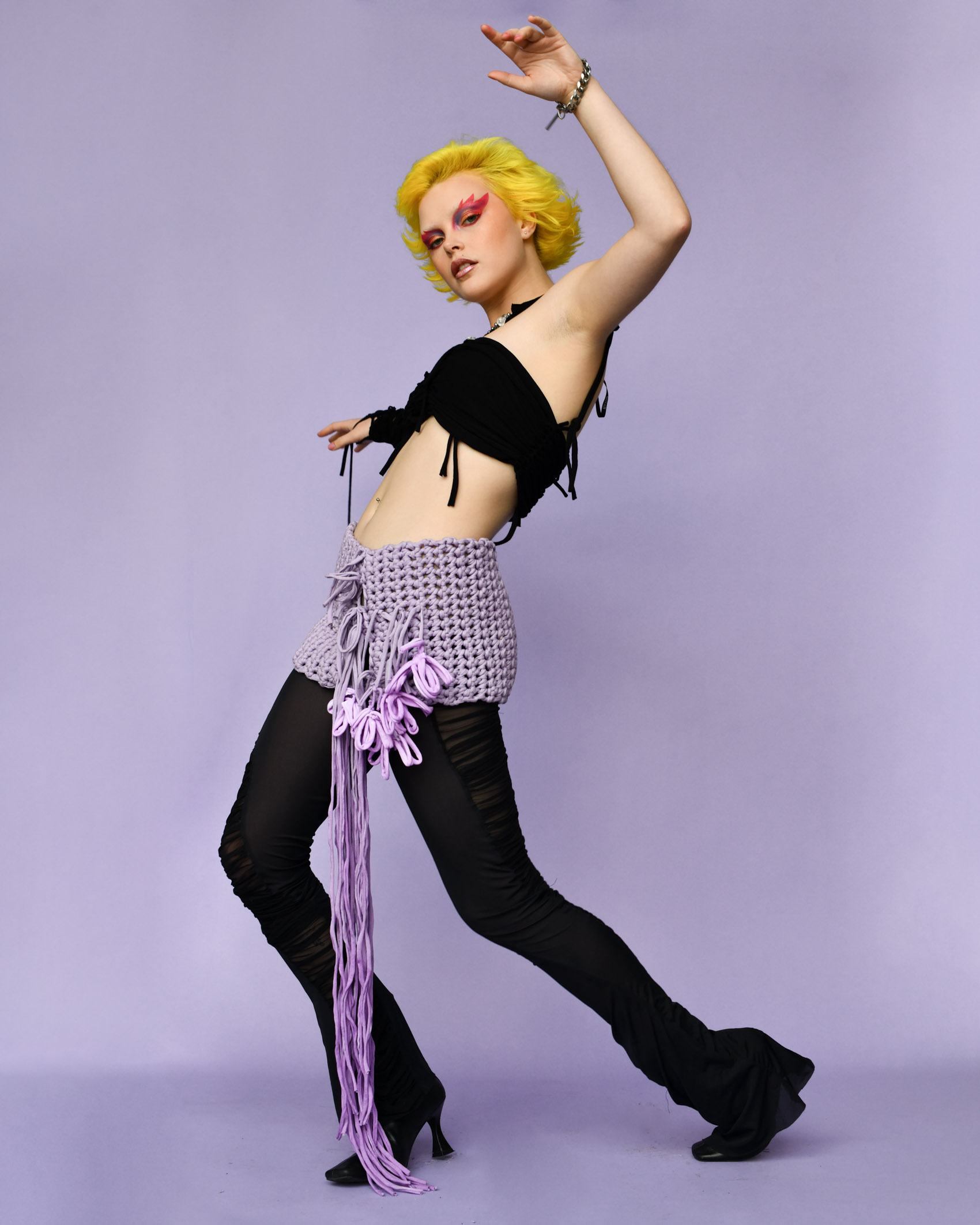
Still to release any music online, the five-some is finally ready to digitally debut. LUNCH chatted to Anna, Eilidh, Josh and Joseph about the serendipitous origins of the band, the theatrics of world-building on stage, and most importantly, their pre-gig snacks.
Anna and Josh originally connected over a mutual swipe right on Tinder but after establishing no romantic intentions the chance nature to their meeting was ultimately the beginnings of the band as we know it. In quick succession, the five-some had all crossed paths and with that their friendship and collective talent grew. “I kind of bookmark when the band started as when we all became friends. Because as long as the band’s been going together, and as the band’s progressed our friendships have progressed too” says Josh
And how does that friendship impact them as a band? “When you’re in a band because people are watching you on stage they can totally see when it’s bullshit. You can see if you don’t like each other and it’s not fun to watch. I think it’s nice to watch people have fun up there. If you’re having fun, people are gonna have fun watching you have fun.”
And fun they had. With a successful run of gigs across the early formation of the band, they quickly carved themselves a reputation as an act to watch. By gig three they were supporting The Murder Capital and Kingdom Management got in touch. “They sent us a message afterward and we’re like ‘Hey guys, we’re interested in helping you out with no strings attached for like six months’. And then yeah, after that six-month period everyone was very happy. Scott’s an absolute legend.” says Anna
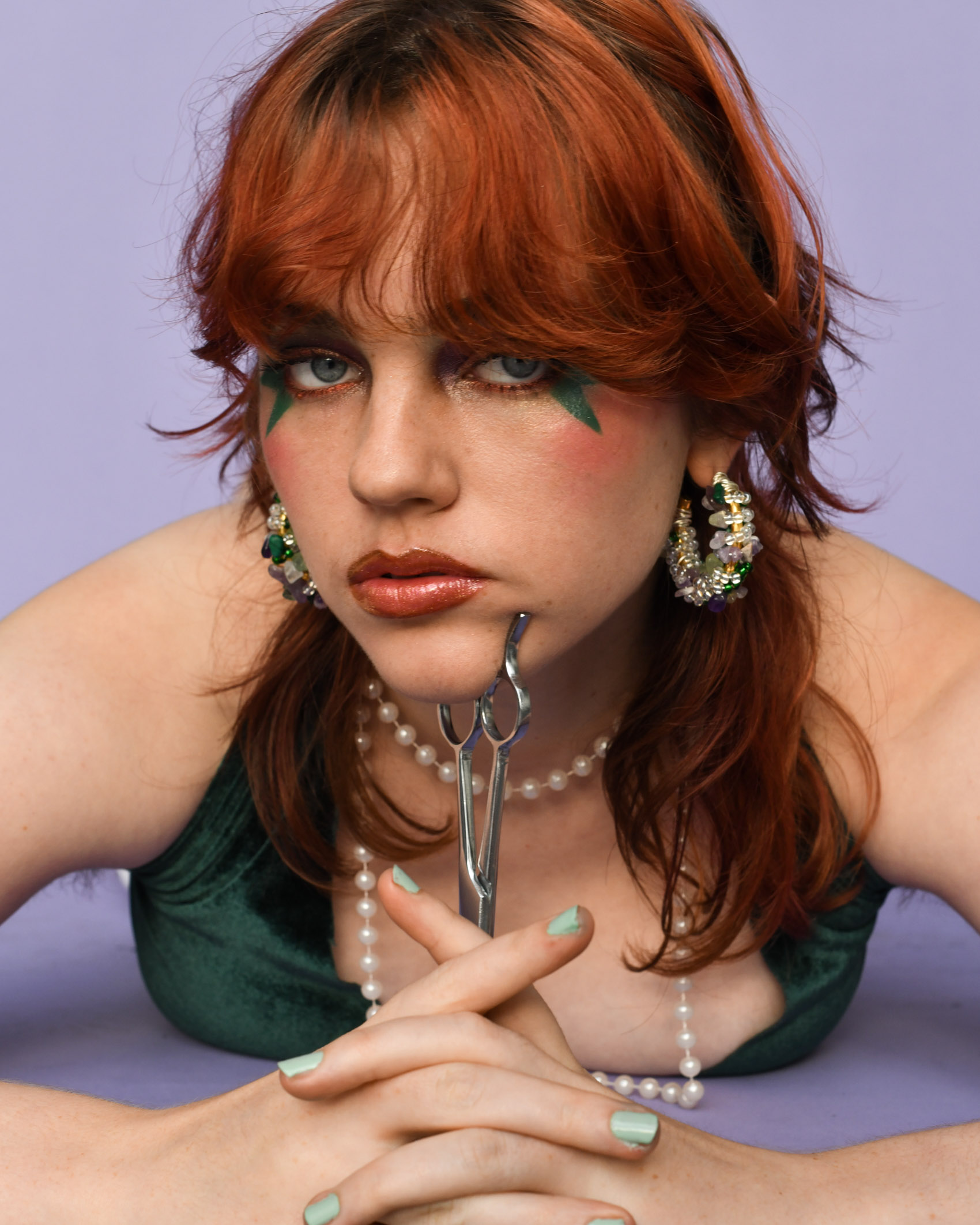
To have experienced Medicine Cabinet’s music you have to have been lucky enough to hear them live. With an uninhibitedness that dominates the stage, they were quick to point the likes of Grimes and Madonna as inspiration when it comes to the theatrics of gig performance. “Madonna’s stage stuff has been incredible as well. She’s amazing in terms of her world-building which is not where we’re at right now but that’s something that we would definitely like to do in the future. I’m picturing that one where she was sort of dressed as Mary Antoinette. It’s like an opera. That’s very cool.” says Anna.
So who are Medicine Cabinet channeling when they perform? “When we’re on stage we all sort of using it to embody saturated versions of ourselves. And that can change depending on how we’re feeling that day or what’s just happened to us in our lives.” explains Anna. This fluidity as a band hungry to explore different facets of their creative energy has kept them evolving and also caused the unlikely experiment of them not releasing music yet. “I think if the lockdown hadn’t happened we would have probably released by now. But I’m really, really glad we actually haven’t because during a lot of them we kind of changed everything up and wrote songs we kind of actually have always kind of wanted to write. And if we released when we were going it we would have been totally different band I reckon.” explains Josh
With gigs returning, Medicine Cabinet are back on stage and set to support Spector on their upcoming tour in January. Keeping on brand here at LUNCH, what’s the all-important pre-stage snack for the band? A collective agreement that you can’t go wrong with a Tesco’s meal deal and a Tennent’s.
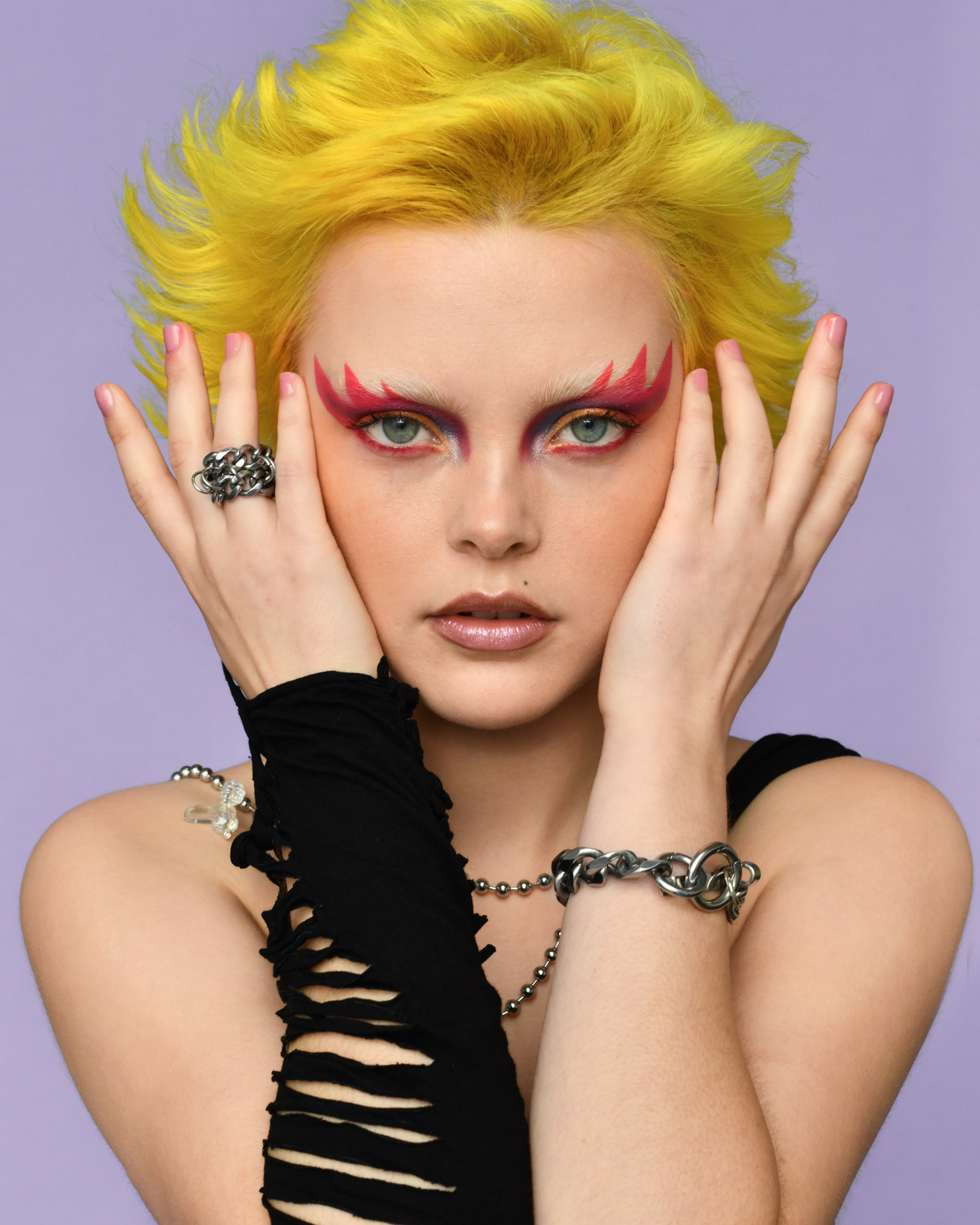
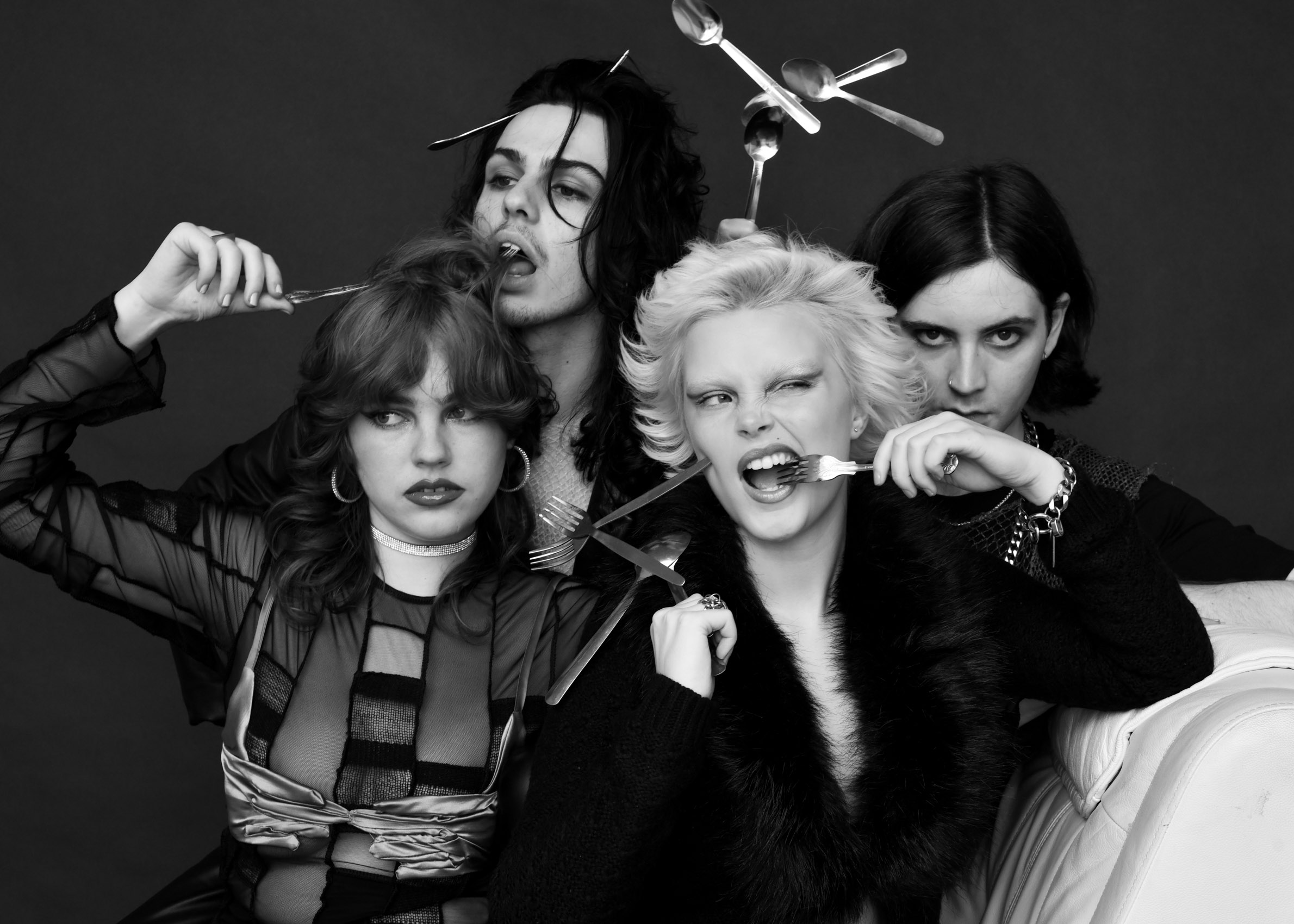
IN TALKS with SBA
21.10.21
Words by Tegan Jaimie
Made-To-Order brands are leading the charge in a new wave of conscious fashion labels. Revolting against their zeitgeist-led fast-fashion counterparts, the MTO movement isn’t fleeting or short-lived. In fact, these agile business models may be the only viable way forward to solve the industry’s significant contribution to the climate crisis.
We chatted with one of our original made-to-order designers, S-BA here at LUNCH to discuss the origins of the brand, seasonless collections, and of course, an ideal lunch in the studio. The S-BA founder Samantha Balcombe is hand-making pieces that are enduring and timeless and it’s time to get to know the designer now.
EXPLAIN THE DNA OF THE S-BA BRAND?
S-BA started very loosely about 5 years ago. I was in between jobs and internships and was very unsure about what step to take. I was working in a cool concept store and my boss told me that I should just start my own brand and we can sell it in the store. So that is where it started! Back then it was completely different, I was listening to a lot of techno and raving every weekend so it was very dark, unisex, and oversized designs. I was working full time at this store so I was just making a few things here and there to test the waters. It wasn’t until about 2 years ago that I started to take it more seriously. I found the style that I actually liked making and wearing which I think is more feminine and pretty but still comfortable. I like my pieces to feel unique to the buyer so most of my pieces have an element of hand stitching or embroidery. My mum taught me how to sew when I was very young, I think of her a lot when I am making so I say she would say is a big part of the DNA of this brand too.
WHERE DO YOU DRAW INSPIRATION FROM?
I draw inspiration from lots of different things. Could be from the music I am listening to, things I see when I am traveling, or people I see on the street who I want to wear my designs. Sometimes even just seeing a certain fabric I want to use can inspire me as I think about what I could make with it. At the moment I am quite inspired by sparkly and embellished things so I think something new will be coming to S-BA soon!
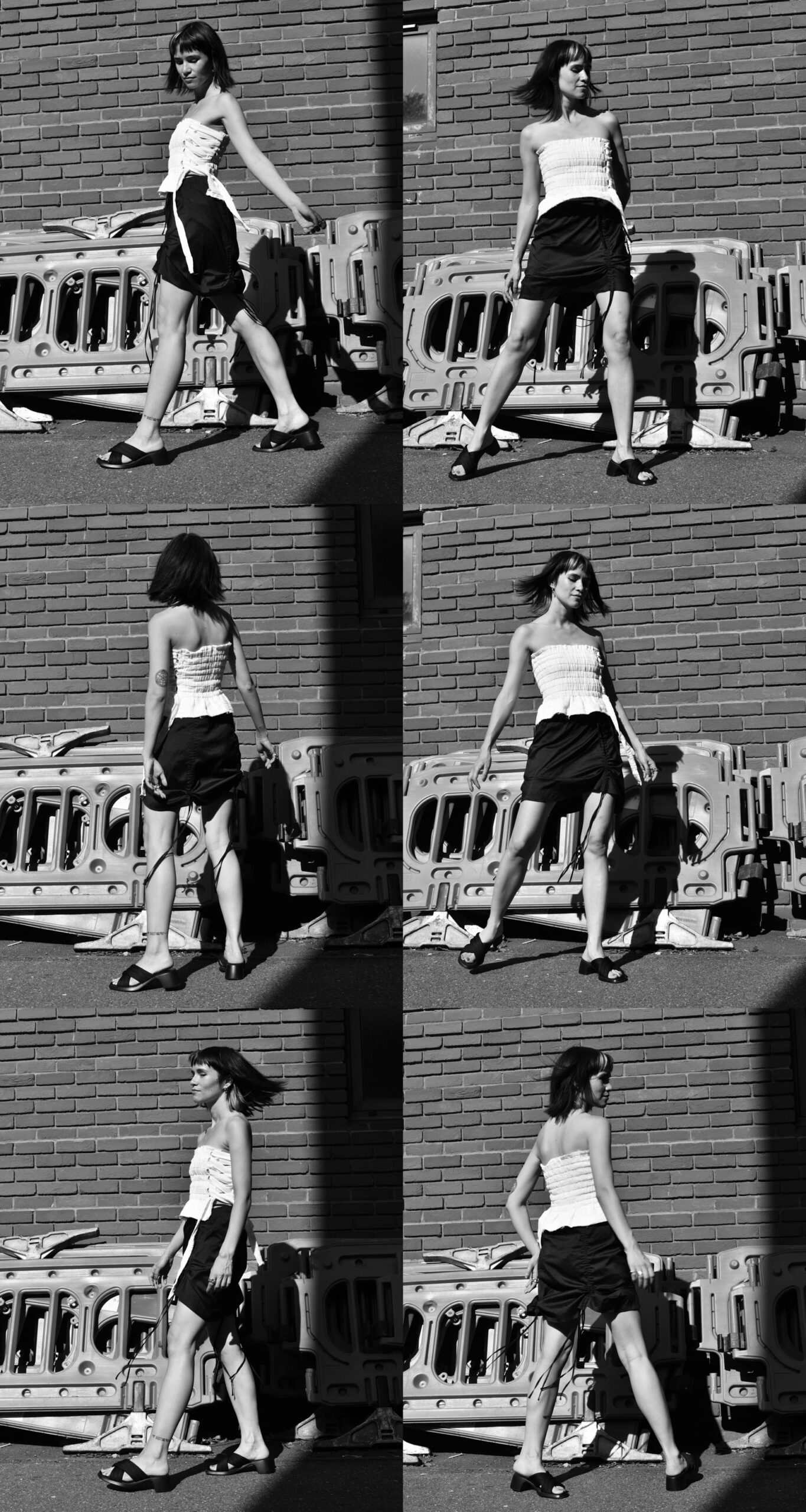
YOU ARE (HAND)MADE-TO-ORDER, WHY DID YOU DECIDE TO HAVE THIS BUSINESS MODEL?
All my pieces are handmade to order to help reduce wastage. I prefer to do it this way instead of having multiple garments and lots of fabric sitting around. And in some weird way, I feel like it is more personal making each piece to order. Also as I have moved my studio to home, it is a lot more space-efficient as my flat is tiny!
AS A SEASON-LESS LABEL, WHY IS THIS CONCEPT IMPORTANT TO YOU?
The season-less aspect was always gonna be my concept before I started my little label. After interning with designers and realising the mad stress and the amount of work leading up to each season, having to create so many looks that are soon to be branded as “past season” 6 months later. Having zero breaks and no sleep. It just always seemed so wasteful and not good for your mental health. I would rather create one season a year with staple pieces that can be worn throughout the seasons. I do carry over some designs as well from previous collections such as the Slit Trouser. This was only of my first ever designs and still one of my favourite pieces!
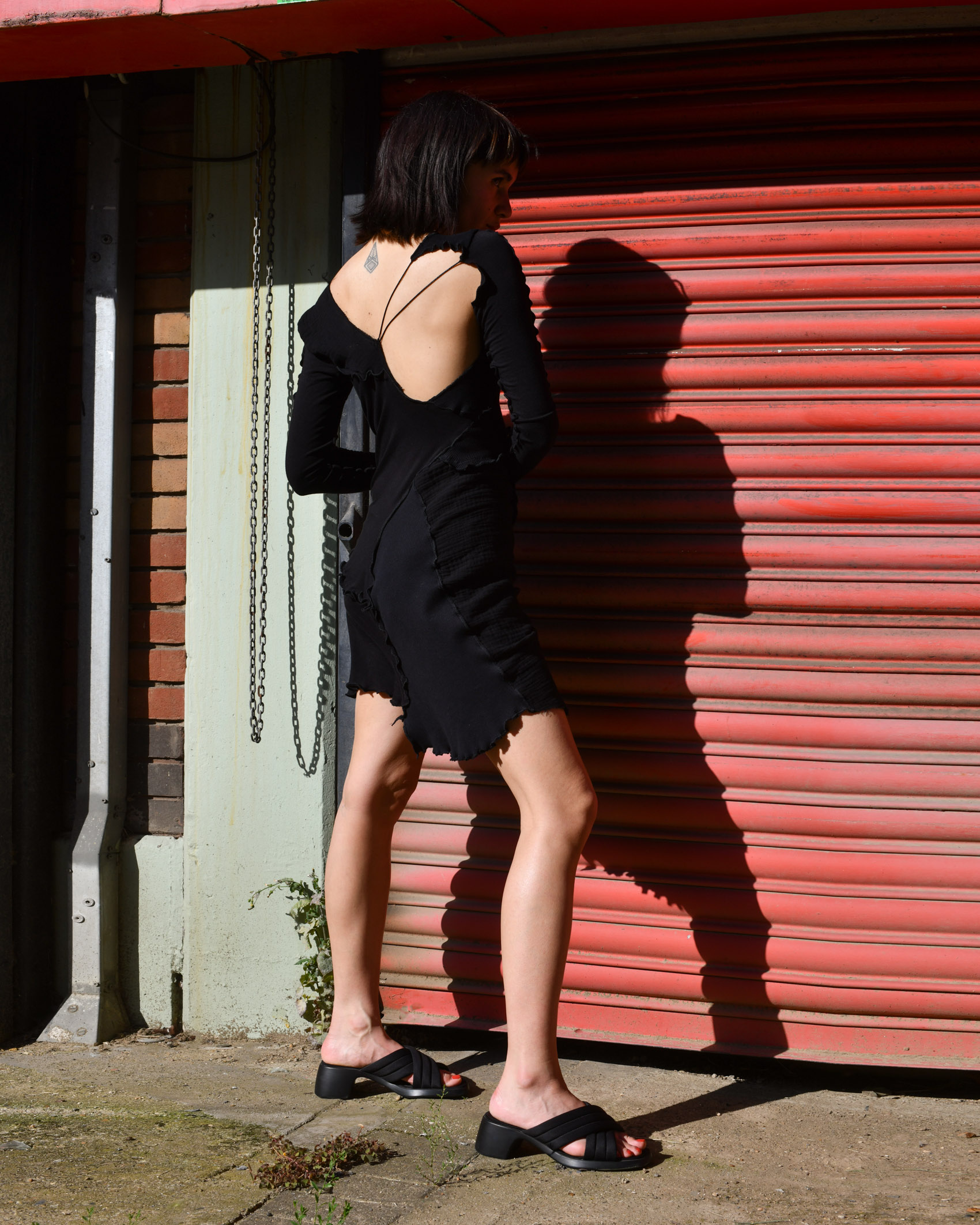
COULD YOU EXPLAIN MORE THE RESPONSIBILITY AS A FASHION DESIGNER TO BE MORE SUSTAINABLY CONSCIOUS?
I think it is very important when starting a brand to think of how to be as sustainable as possible. There is so much mass-produced and fast fashion shit out there that I think it is important to not follow the trends and create unique pieces that are special to you, whilst also trying your hardest to not damage the environment. I am always thinking of new ways to be more sustainable. A couple of years ago I stopped getting my fabric labels made, and instead, I bought a stamp for my logo and I handwrite the care instructions onto scrap fabric. I also have always kept most of my fabric scraps, and over the last year or so I have been turning them into remnant tops and dresses. One-off designs that I patchwork together. These have been my favourite things to make and have been a hit!
AND FINALLY, WHAT IS YOUR IDEAL LUNCH WHEN IN THE STUDIO?
I am currently trying to be healthy so my current lunches have been very green salads. However, my ideal lunch would be fried chicken or a burger and chips!
IN TALKS with HELÉNA STAR
14.10.21
Words by Hannah Gordon
Today we chat with London based musician, Heléna Star, whose career has been nothing short of exceptional. Joining her local radio station as a DJ at just 16, the 25-year-old has since made a name for herself in the music scene. She now has her own show on Foundation FM, a remarkable female-founded radio station advocating for those from ethnic minority backgrounds and the LGBTQI+ community within the music industry.
As her name would suggest, Heléna is a stellar individual championing for greater diversity both inside the music community and out. She brings a breath of fresh air to the DJ scene and has proved herself as a discerning role model to those looking to follow in her footsteps. With LUNCH, she recounts her own growth as a young Black artist and what completes her signature performance look.

You recently performed with Keep Hush for Black Minds Matter. Could you give us more insight into both of these organisations and what’s so important about them?
Yes I did! Keep Hush have been a great supporter of what I do for a while now and that is what they do across the board. It’s a really exciting organisation that stream, promote and ‘back the underground’ in all their pursuits. Plus, it is run by the best team who are really great at what they do and genuinely care, which can be rare to find in this industry. Black Minds Matter is a charity that I only recently have been introduced to but again, what they stand for and the work they do is absolutely essential. Promoting mental health awareness in the Black community and providing free services for individuals and families.
You are also a host of Foundation FM – another really important platform. What do you enjoy most about being a part of Foundation? How has it grown since its beginnings?
I am so blessed to be a part of Foundation, I was lucky enough to join the station on their first week being live! Not only has the station grown in size, in the space of three years the station continues to evolve and provides a space for people to grow and flourish.
You previously stated that you struggled with the lack of diversity in your hometown, Guildford, as well as struggling with accepting your racial identity. What would you say to others facing the same issues now?
I really started to feel a shift in how I viewed myself when I moved away from home. It wasn’t so much about accepting who I was, it was about being proud of who I am. I’d love to think that with the expanding knowledge at the tip of our fingertips and having role models that reflect under-represented groups, fewer people will have to feel othered. The reality is that we still have lots of issues to deal with but finding community and finding others who accept, love and understand you is the best place to start. I’d also like to see schools tackling those issues more as there currently is not enough done to protect or to educate those who need it most.
Having been involved in music and DJing from a young age, are there any other career moves you’d like to make in the future?
I am really lucky to have known the path I wanted to go down from an early age and one of the great things about this industry is that there are so many places to move into. I will always work in underground electronic music, but I would love to add more strings to my bow, including production, label management and eventually owning a club or venue.
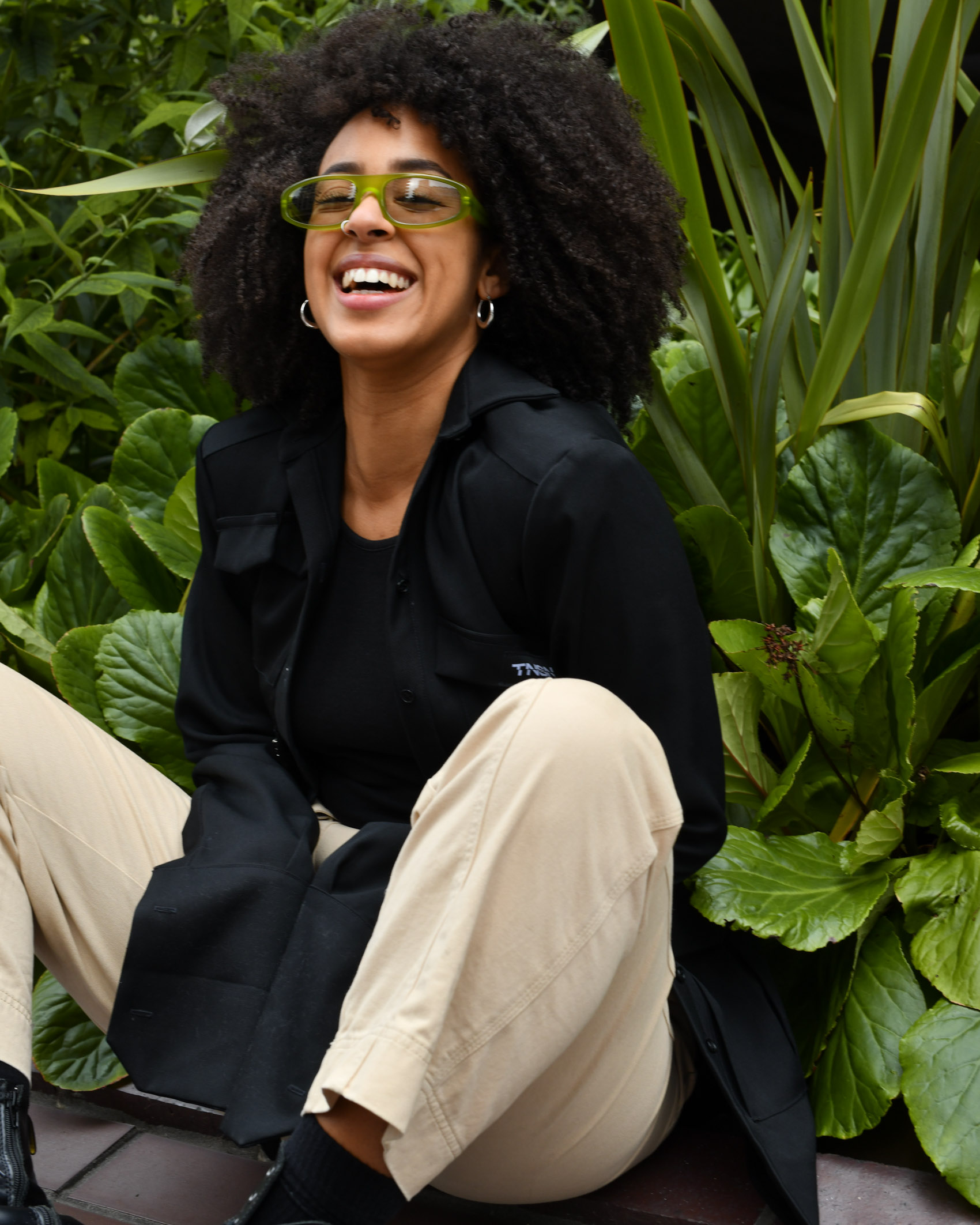
What is your go-to look for a gig? How does this compare with your style off-duty?
Those who know me will know I love to change my hair all the time lol but a staple look for me would be a slicked back bun – so I can easily use headphones without my hair getting tangled – with a bold red lip, maybe my own or a friend’s designed oversized t-shirt and some kind of statement trouser or jeans. To be honest, I wear that on a normal day too, apart from off-duty you will definitely catch me with my afro flying free!
BEAUTY with ZUZU
08.10.21
IN TALKS with PLANTAINCHIPPS
29.09.21
Words by Hannah Gordon
Featuring Nwanneka aka Plantainnchipps
Photography Bethany Grace
Styling Tamara Turnbull
Makeup MVB
A guest as delicious as today’s needs little introduction. She has swept Glasgow’s most recent festivals with her vivacious tracks and undoubtedly endearing nature, it’s no wonder DJ Plantainchipps is gaining swift traction in the city’s music scene. The multidimensional artist is also releasing her own recordings under her real name, Nwanneka, including her most recent magnetising single, Soil.
This ascending musician is also a recently, mid-pandemic, graduated English language and literature student. With the global brakes on performing and a shortage of graduate jobs, Nwanneka reflects on her perceptive navigation through her return to musical performance as well as why everyone should care about themselves more.
Firstly, I have to ask, how did your DJ name, ‘Plantainchipps’ come to be? Is there a story behind it?
‘Basically it’s one of my favourite snacks. Plantain chips are a really great snack. I think it’s mainly in places like Africa, Jamaica, and the West Indies where people eat it. But it’s just one of my favourites.’
Tell us about your artistic process as a DJ, and what inspires you?
‘For the most part it’s always been me going to gigs, going to see other people play and how they play, how they use the decks as well. Sometimes it’s watching sets online or on YouTube, from that I tend to just watch and think how can I make that my own. How can I try and do my own thing with that?’
Do you remember a specific point where you thought ‘this is it, DJing is what I want to do’?
‘To be honest I think it was just in my first year of uni. I had been to a couple of DJ nights and I was like “it must be pretty cool to be the one in control of all the music.” I just thought okay, if there’s an opportunity for me to learn the stuff, then I’ll go ahead and learn.’
Intrigued at her clear enthusiasm, I enquire about the least pleasant parts of being a DJ.
‘It’s actually just getting all the tracks, you know. To be honest, the easy part is playing. The hard part is like having to sit and get all the tracks, it takes so long. You’re gradually accumulating music, but it’s just irritating because of the amount of time and money it costs to get all this music. Being a DJ, you have to have thousands of songs, at least enough to last you maybe 6 months worth of work. So yeah, that is quite intense’
How was it not being able to perform over lockdown?
‘During the past year and a half, it has been quite different – and difficult. I think initially when I graduated from uni I thought “oh, I can DJ then, rather than doing the work. Then that just didn’t happen so it was kinda like, oh fuck, now what?” Then trying to find [DJ] jobs has been really hard, obviously during a pandemic you’re not exactly going to get a job quickly. But even then when you do get back into it, the anxiety you now have of performing in front of loads of people, even though you were so used to it before, it just creeps back and you’re like “oh no”’
Your music is really energetic, how does that vary when you aren’t feeling so great, do you have to push yourself into a more artistic head?
‘In the beginning of playing I’ll still feel a bit meh, but as it goes on, the feeling of remembering why I enjoy DJing always comes back and helps me. It reminds me “you’re in a good space right now, its fine.”’
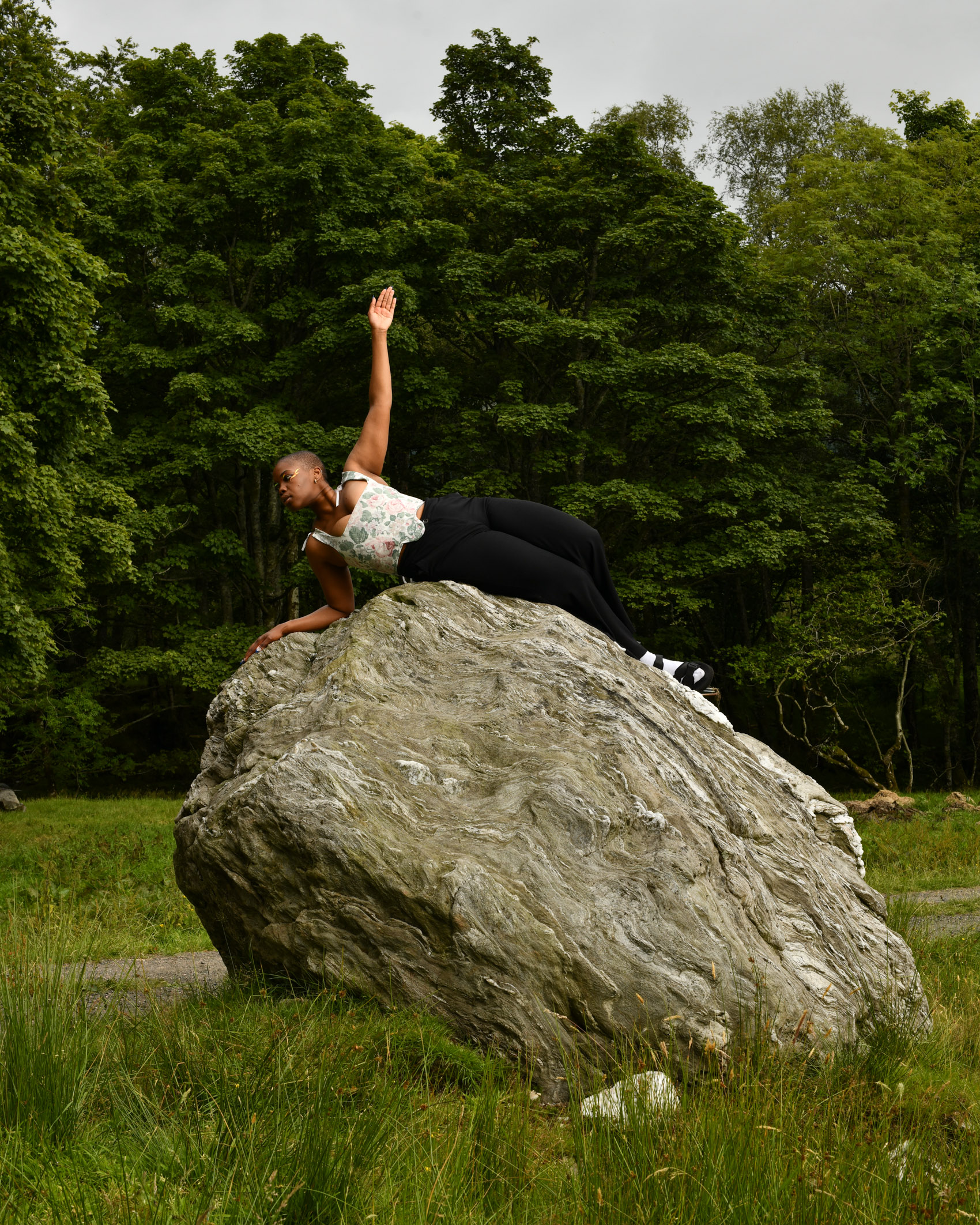
What has been your favourite gig to do overall?
‘I think it was the GSA degree show party, that was just so much fun. I have a lot of friends from GSA and I knew the promoter as well. I think it’s because a lot of my friends were able to attend it, they were all egging me on. I just remember them cheering “YEAH” at me.’
Obviously, I have to ask you about your fashion as well, is there a link between your music and fashion?
‘It’s funny, because when I DJ I don’t tend to put in the effort into how I dress. But recently I’ve been thinking, should I actually try to put in some effort? I’ve seen other DJs and they do actually dress up, or they’ll put makeup on, spruce themselves up a little bit and I’m like- People are just here to see me play, not necessarily what I’m wearing. But I do enjoy dressing up as well, it does feel nice and I think generally I just decide what to wear depending on the day, depending on how I feel, but I have been thinking recently I should put more effort in’
When you’re creating music, is there anything you want to put across?
‘When it comes to producing the music that I sing and create it really does depend on the vibe of the track itself. If it sounds slow, the idea that I have or what’s linking it, like what the theme of the song is – I guess it depends on what I think about when I start writing. That’s when I can figure out what kind of energy I’m trying to put out. And then with DJing in itself it’s always to make people feel happy, or joyous, or just want to dance, you know? I want people to just completely forget about themselves when they’re at my set. I don’t want people to feel like “oh people are watching me, I can’t dance.” Just relax, just have fun and forget. I think sometimes there’s too much attention and focus on how you look, what you’re up to, just forget about that!’
What’s your dream performance, where would you like to play?
‘Oh wow, I’ve actually never thought about that. I don’t really know. I feel like anywhere that’s just going to be an array of people who are open minded to any kind of music. It doesn’t even have to be big, just a nice environment to be in.’
Finally, I ask her about one thing she thinks everyone should care about right now.
‘It’s interesting, there’s a few things I think people should care about. First of all, people should care about themselves. Not in a selfish way, but in a way of realising how you need to be self aware. Just generally looking after yourself, taking time for yourself and being aware of your thoughts, where you’re at and what you’re doing, stuff like that – it’s so important. It can stop you from projecting. Once you’ve taken care of yourself you feel a lot better and then communicating with others is easier, you’re not agitated.’
‘Also, I think you should care about the people around you, your friends and your family. This past year has been very tough for some people, and somewhat enlightening for others, but at the base of it we all need to just care about each other. I think one thing we have learned from our governments is that they do not care about us, so we’re gonna have to try and care for each other. We’ve all been taught individualism and to look out for yourself – not caring about anyone else – I get it, but it’s also not that productive when it comes to times like this.’
‘Just caring about issues that don’t necessarily involve you, putting yourself in other’s shoes. There are a lot of things that do need other people’s input and support. I guess it’s also insightful for everyone else to just have some kind of input that’s going to be positive – and beneficial to the people involved. You have no idea how much that could help them out. Just putting yourself in a position where you’re like “do you know what, I don’t know a lot about this but I’m willing to try and know, or at least engage with it.”’
IN TALKS with OLIVER FJ JONES
22.09.21
Words by Tegan Jaimie
Every year we are met with a fresh cohort of emerging graduate designers adding their names to the lexicon of the fashion industry.
Oliver FJ Jones is one such new designer entering the space. While the jury is still out on what it truly means to be ‘sustainable’ in the industry today, one thing is for certain we still live in a culture that privileges commodity and trend over re-purposing and circularity when it comes to our consumerism.
Enter, Oliver FJ Jones, the Edinburgh College of Art graduate who is elevating the upcycling fashion scene where his reworked vintage bags emblazoned with his signature warped homo print are a hit here at LUNCH. So much so, his whole family is now scouting out vintage bags for him. A true reworking masterclass in how the industry should be addressing sustainability.
Below, Oliver discusses the origins of his namesake brand, delves deeper into his sustainability thoughts, and also his plans to develop his identity as a young designer.
EXPLAIN THE DNA OF YOUR NAMESAKE BRAND, OLIVER FJ JONES?
The DNA of an Oliver FJ Jones piece is often intertwined with historical nuance and attitudes towards gender. The brand exists as a catalyst for me to play with my own interests in medieval history, allowing me to turn aspects of it on its head. Growing up in the city of Lincoln meant I have always been surrounded by gothic religious iconography from Lincoln Cathedral to its historic castle. I think this is where my exploration started from. Being someone who grew up around Christianity meant that gothic architecture, choral music, and ancient stories were part of my upbringing. Only was it when I grew older and came aware of my identity did I start to question my own faith. I look at religious iconography more as a gateway into a wealth of history and inspiration. Using religion’s history of persecution against anything ‘ungodly’ as a source for inspiration. This is what I hope my brand’s DNA stands for. I am far more interested in the way my brand can serve to reinvent and reclaim these ideals. My first collection ‘HOMO’ dealt with these sorts of ideas, from knightly figures wearing adorned tights and elongated heels mimicking medieval lancing shoes. The collection did and probably still does act as a base for many other concepts I create.
WHERE DO YOU DRAW INSPIRATION FROM?
Inspiration comes to me in so many different forms, from books, films, history, and even music. The collections I’ve created are often grounded in a world in which I design and envisage. Maybe controversially, I try to stay away from directly looking at other designers’ work both present and previously too much when designing. I personally find the success of a collection comes from something uniquely individual from the designer. It’s fantastic seeing what’s happening in the world of design but often it can cloud my own creativity and voice behind my designs. There’s a lot more gratification that comes with designing something you feel personally attached to and connected to.
My latest capsule collection ‘HEATHENS & HOUNDS’ came to me whilst researching Hieronymus Bosch’s work. I took fragments of colour from his paintings and put my mind to how I could reimagine these oddly painted figures through my own eyes. Often inspiration stems from the smallest of encounters with textures, mediums, and print. For instance, I knew I wanted to play with the idea of vintage painted leather against fur and how that might make the wearer feel. My warped homo print stemmed from a want to create a pattern that only on inspection you’d realise it spelled out homo. These, often small, ideas can often build and build to form a much greater body of work.
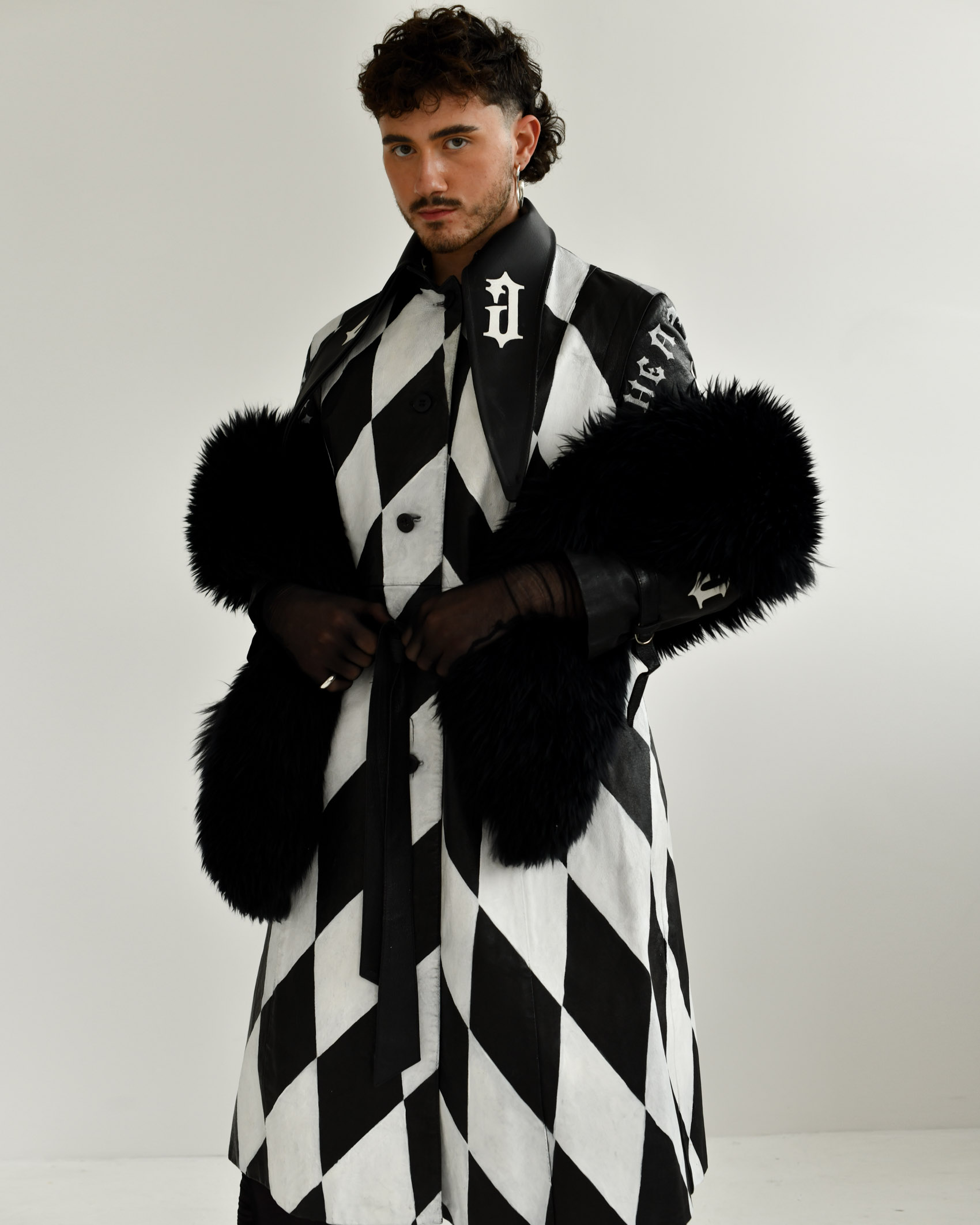
AS A RECENT GRADUATE, WHAT’S YOUR PERCEPTION OF THE INDUSTRY TODAY?
My love for designing concepts for fashion is often conflicted with what the industry sadly has become. I tend to approach my design similar to that of art. The collections and clothing I have reworked exist beyond seasonal fast-paced trends. I strongly believe the industry of fashion needs to readdress its message and responsibility within society. There are so many possibilities and messages clothing can showcase that often is missed. For too long huge corporate fashion businesses have sought fashion as a commodity, and placed emphasis purely on its commercial value.
I hope my brand welcomes creatives to think openly about what fashion can really be and mean for people. I hope to put emphasis on concept, story, method, and uniqueness in order to really connect and celebrate individuality. The vibrancy and eclectic nature of fashion has often been missed and replaced by trend and commodity. I also personally would like to see more infrastructure for younger emerging designers to be celebrated regardless of location.
WHY IS SUSTAINABILITY IMPORTANT TO YOU AS A YOUNG BRAND AND HOW DOES THIS FEED INTO YOUR CREATIVE PROCESS?
Sustainability should, I hope, be seen as an expected duty of young designers working and practicing in 2021. My personal approach to designing has often been restricted to previously vintage items which have forced me to think creatively. These items ultimately go on to exist as a single one-off piece to be coveted by the buyer. I feel really strongly about the idea of limited stock buying which celebrates this idea of a one-off piece. I hope in turn this encourages people to think of fashion as not only something commercial but something that exists as a story, a memory, and an individual.
HOW DO YOU SEE YOURSELF GROWING AS A BUSINESS? AND WHAT DOES A SUSTAINABLE BUSINESS MODEL LOOK LIKE TO YOU?
I hope to see my business develop to showcase both reworked pre-loved items along with handmade small run pieces which push fashion’s relationship with art and concept. I hope to see my brand become a wealth of bespoke items which celebrate diversity, inclusivity, and non-gendered fashion. I see my business developing as something not restricted to simply seasonal collections but as something more fluid. This in turn would I hope to grow an audience that champions sustainable conscious buying.
YOU UP-CYCLE YOUR SIGNATURE OLIVER FJ JONES BAGS – HOW DID THIS COME ABOUT?
The want to develop a range of bespoke bags began when I started to experiment on different surface mediums. One of the first bags I unintentionally created was originally used as a 1950’s binocular box case. By adding the warped homo pattern to the PVC coating the whole use of the bag changed. I’m always on the lookout for good quality, often unusual, evening bags that are ripe for designing on. Funnily enough, since then my whole family has been scouting for them. I like how the bags I design aren’t simply used for the purpose, but also used as display items. I think there’s something really interesting there about where fashion may enter more of an art sphere.
WHAT’S NEXT FOR OLIVER FJ JONES AS A DESIGNER/BRAND?
The development of my online presence is a priority for my brand right now. I have been slaving away at producing an immersive representative online website which showcases my previous work. Its often been quite challenging learning so many skills on the job but I cant wait to share my efforts with everyone. It’s quite an exciting feeling transitioning my current way of working to a more professional bespoke online experience. Going back right to the start of my collections and marketing them has been really holistic. Once these items have started their next chapter in someone else’s closet, I think the scope for really honing in on my own brand identity can begin. I want to push this idea of immersive design and transition to a clearer vision of what an Oliver FJ Jones piece can really be and mean to people.
Shop Oliver FJ Jones now

